
Dec 2022 Vol XXI Issue II
THE DEC ISSUE
Syracuse, New York Your student fee
This message is for SZA and Phoebe Bridgers so if you’re not them, keep reading.
Hey guys, we just wanted to say we’re free on Friday ;)
jerkmagazine.net @jerkmagazine
Zoe Glasser EDITOR IN CHIEF
Lilly Chidlaw-Mayen CREATIVE DIRECTOR Sarah Dolgin EXECUTIVE EDITOR
EDITORIAL
FOB EDITOR: Megan Adams
ASST. FOB EDITOR: Jojo Wertheimer
OPINION EDITOR: Margo Moran
ASST. OPINION EDITORS: Julia Reedy & Russell Tom Sun
FEATURES EDITOR: Julia Walker
ASST. FEATURES EDITOR: Sadiya Kherani
GAWK EDITOR: Lily Brooks
ASST. GAWK EDITORS: Noa Putman, Makenna John & Aiyana Hardy
NOISE EDITOR: Sydney Gold
ASST. NOISE EDITOR: Emane Haque
WRITERS
Cassandra Abel, Gray Reed, Karla Sofia Perez Davila, Jackson Barnes, Lily Menk, Faith Bolduc, Marissa Carello, Chloe Langerman, Ellie Chapman, Maddie Rhodes, Madison Christiansen, Isa Naro, Timia Cobb, Jojo Wertheimer, Hannah Saltz, Joelle de Poto, Sophie Davis, Taylor Benjamin, Fifi Azzara, Kathryn Hendry, Etzabella Pabon, Naimah Rahman, Bryan Fletcher, Cassia Soodak
DIGITAL
Stratton MANAGING EDITOR
DIRECTOR: Lucy Stover
DESIGN DIRECTORS: Anika Dua & Lilianna Smith
DESIGNERS: Sophia Donio, Gisele Gosset, Thelma Gies, Sarah Wong, Hallie Meyer, Cayla Israel, Elijah Sykes, Catie Haugen, Olivia Smith, Sophie Sternkopf, Natalie D’Alto, Ande Wittenmeier, Gisele Gosset
VIDEO DIRECTORS: Olivia Allison & Luci Messineo-Witt
SOCIAL DIRECTORS: Katie Murray & Giana DiTolla
HEAD EDITOR: Allison Bilger
ASST. EDITORS: Isabel Bekele, Emma Novy, Ella Welsh
CREATIVE
DESIGN DIRECTOR: Lang Delapa
DESIGNERS: Lindsey Smiles, Hailey Williams Travis Newbery, Marisa Goldberg, Katie Cefalo, Megan Radakovich
ILLUSTRATORS: Matt Latvis, Hannah Landon, Thelma Gies, Hallie Meyer, Paige Toglia, Ben Herbert, Kodah Thompson, Fe Kligerman, Marisa Goldberg, Katie Cefalo
PHOTOGRAPHY DIRECTOR: JJ Tanaka
Kiran Hubbard
FRESHMAN INTERNS Teddy Ryan &
PHOTOGRAPHERS: Grace Hayden, Carmen Miller, Ellie Stern, Vivienne Love, Maya Lockwood, Elijah Sykes, Junyi Zhang, James Hutchinson, Yiting Wang
Harriet Brown ADVISOR
Through its content, Jerk is dedicated to enhancing insight through communication by providing an informal platform for the freedom of expression. The writing contained within this publication expresses the opinions of the individual writers. The opinions expressed herein are not those of Syracuse University, the Office of Student Activities, the Student Association, or the student body. Additionally, the ideas presented in this publication do not necessarily reflect the opinions of the Jerk Editorial Board. Furthermore, Jerk will not be held responsible for the individual opinions expressed within. Submissions, suggestions, and opinions are welcomed and may be printed without contacting the writer. Jerk reserves the right to edit or refuse submissions at the discretion of its editors. Jerk Magazine is published monthly during the Syracuse University academic year. All contents of the publication are copyright 2021 by their respective creators. No content may be reproduced without the expressed written consent of the Jerk Editorial Board.
3
Eden
LETTER FROM THE EDITOR
My roommates and I always joke about Plato’s Allegory of the Cave, because philosophical concepts are hilarious, obviously. If you’re not familiar, the phrase basically means that our worlds only consist of what we’re exposed to, so if you live in a cave your entire life, you’ll think that the shadows on the wall of the cave are reality. But if, for whatever reason, you’re forced out of the cave into the outside world, then your perception of reality will change, and you will never be able to go back to how you thought about the world before. Your worldview can always expand, in other words, but it can never contract.
Right now feels like I’m about to get pushed out of the cave into a bright light that I’m not quite prepared for.
If that metaphor doesn’t work for you, here’s another one: life is feeling like the part right before the last lap in Mario Kart. I know the music is about to go up an octave and things are about to start lighting up rainbow, but for now, I’m relishing life in the slow lane (although, if we’re being really real, it’s never slow going at Jerk). The year is drawing to a close, I’m approaching my final semester at SU, and my friends and I are about to enter an entirely new chapter of life. Plus, December is naturally a time full of endings, and endings push us toward new beginnings that open up our worlds. These endings are often uncomfortable and strange; after all, your eyes have to adjust to the sunlight when you get pushed out of the cave (or you have to acclimate to the speed in that final lap; again, whichever you prefer). Comfort is also a fleeting thing; it can disappear without any warning.
In this issue, we’ve considered the ideas of comfort and discomfort in many of the ways they shape our reality. On page 23, read about
how statewide post-Roe legislation has forced SU students to worry about returning home, highlighting how comfort can also be a privilege. On page 57, check out our package that dives into the appeal of academia as an aesthetic. And of course, feast your eyes on our fashion feature shoot on page 41 that shows off cuddly and cozy clothes that mean a lot to us.
As we turn the corner into the final lap of 2022, I hope that we can examine what makes us uncomfortable so we can face it in 2023. After all, it’s not like we can solve a problem by refusing to acknowledge it. By thinking about what makes us feel on edge, we can consider why we feel the way we do and the ways in which it impacts our realities. I don’t pretend to be a philosopher — I’ll leave that one to Plato — but when we consider these things, I think we can learn to let a little more sunlight into our lives.
Editor In Chief
 With love, Zoe Glasser (she/her/hers)
With love, Zoe Glasser (she/her/hers)
JERK THIS 4 JERK 1-14
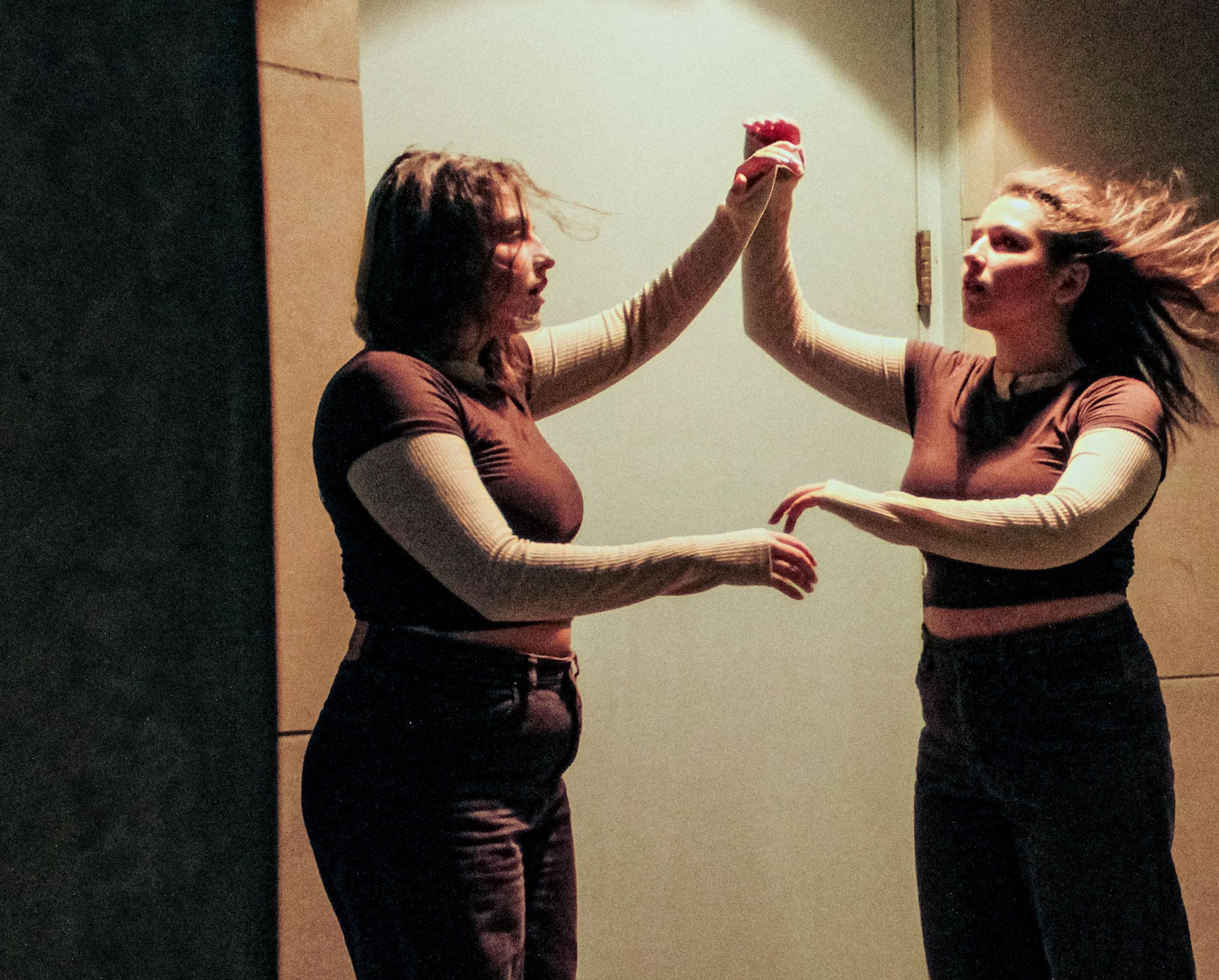
The Currency of Catcalling Julia Reedy Information Age vs SelfDeprication Fifi Azzara The Off-Campus Classism Divide Sadiya Kherani Study-Abroad Snobbery Russell Tom Sun 15 17 19 21 Home Is Where the Heartbeat Law Is Jojo Wertheimer How To Survive A Snowstorm Naimah Rahman Daley’s Technicolor Dreamcoat Eden Stratton Psychoanalytic Dream Journal Joelle de Poto Who You Gonna Call? Food Busters! Sarah Dolgin Courage, Care & Candles Eden Stratton 23 27 31 35 39 40 Jerk on the Internet But wait, there’s more... Hit/Bitch Karla Perez December Horoscopes Kathryn Hendry Sex: Cum On, It’s Time to Fix the Orgasm Gap Emane Haque Framed: Jordan Thomas Jackson Barnes 21 +/-: Cranberry Sparklers Cassandra Abel 7 9 10 11 13 14 JERK THIS BITCH SMUT FRONT OF BOOK OPINION FEATURES 5
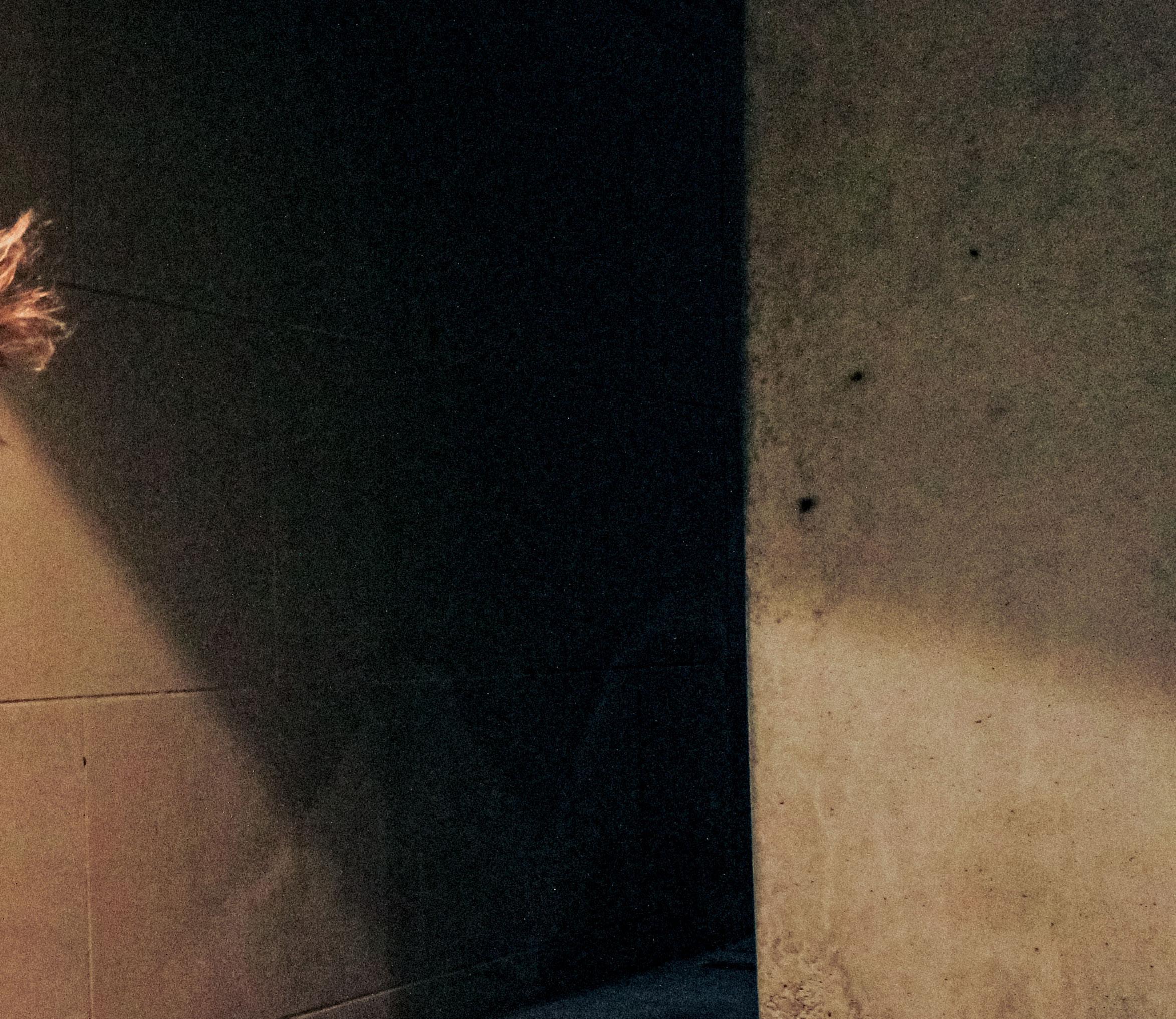
Snug Cassia Soodak & Lily Brooks Stripped: Damsels in Distressed Lily Brooks Form & Function: Coquette Girl Naimah Rahman Closet Case: The Cultural Role of Our Clothes Emane Haque The New Vintage Zoe Glasser Package: Dark Academia Gray Reed, Ellie Chapman, Chloe Langerman, Kiran Hubbard Amplified: Bri Margo Moran And That’s What You Missed on “Glee” Bryan Fletcher 41 49 51 52 53 57 65 66 GAWK NOISE FASHION ARTS JERK THIS 6 JERK 1-14
Listen to Jerk’s weekly podcast, Hit and Bitch — where Zoë, Emma, and Kenny discuss the things you hate to love and love to hate — on Spotify today!
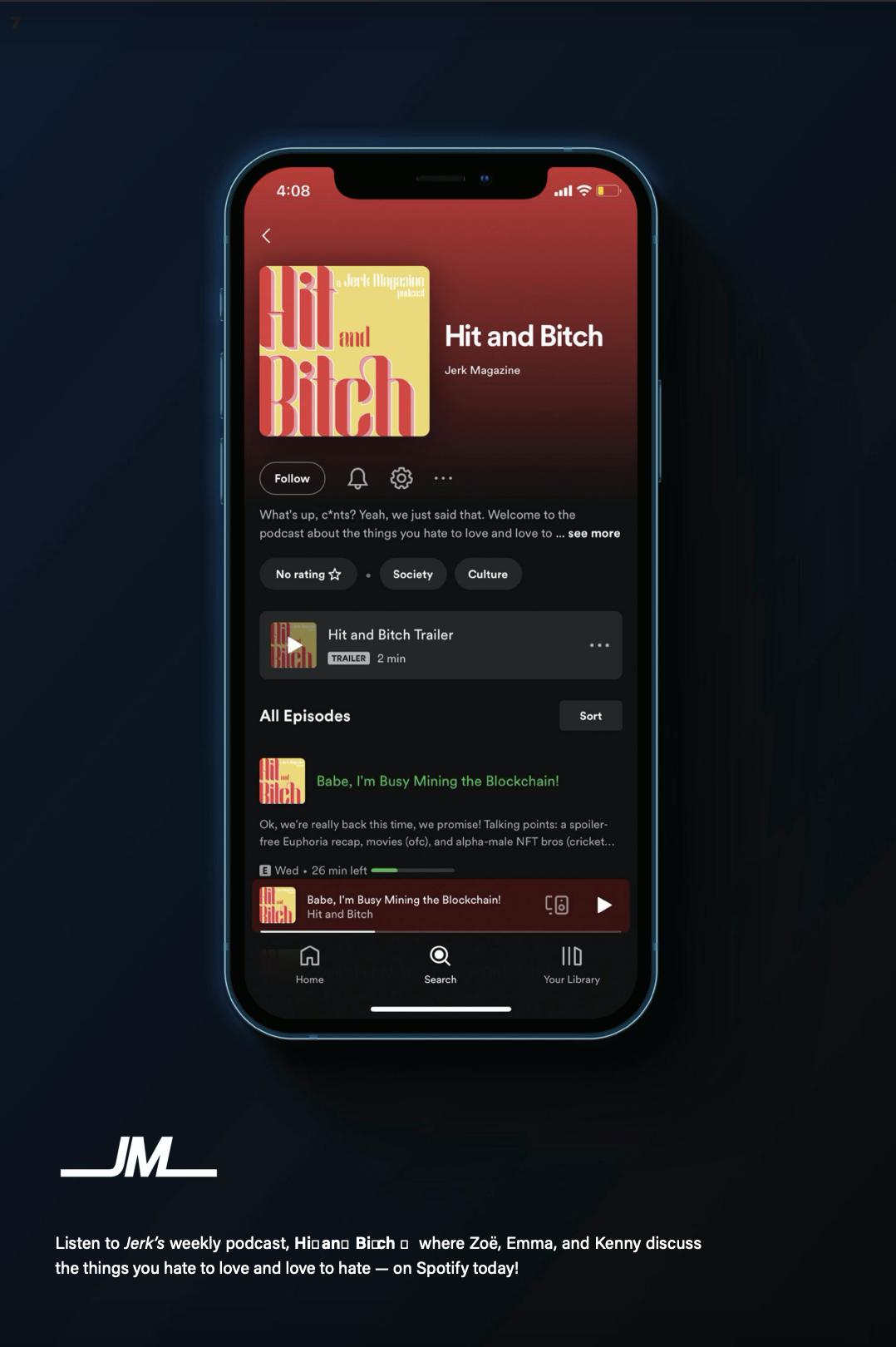
7
JERK ON THE INTERNET

Bringing you the latest and the littest @jerkmagazine
Jerk Magazine is exploring new ways to compliment our print mag. Find additional content on social media and our website jerkmagazine.net.




JERK THIS 8 JERK 1-14
GLASS ONION: KNIVES OUT DECEMBER 3
If this sequel is as good as the first one, we WILL enter a detective era. All we need for Christmas is Daniel Craig investigating a murder on a boat with a bunch of rich people trying to solve puzzles. We don’t know about you, but there was something so intriguing about the mystery and the twists, plus Chris Evans in a sweater, that just left us wanting more. We can’t wait to see where this sequel takes us.
SPOTIFY WRAPPED DECEMBER
Whether you like to be held accountable for your niche music taste or just like to know you were one of Taylor’s top 1% listeners, Spotify Wrapped is our favorite holiday gift. There’s something so comforting about seeing your music taste displayed in pretty graphics that you can flaunt in everyone’s face. Apple Music users stay mad — it’s Spotify season.
VIOLENT NIGHT DECEMBER 2
This holiday season, we are ready to take a break from cheesy Hallmark and enter the realm of gory Christmas. If you’re a Die Hard aficionado, this movie should be right up your alley. It’s got a cool drunk Santa (played by icon David Harbour), a hostage situation, and lots of stabbing using starshaped ornaments, all mixed together to make what should be a campy SNL sketch. But hey, we’re here for it.
TAYLOR SWIFT ERAS TOUR 2023
We know we’re getting ahead of ourselves, but we just can’t wait for this one! We hope you survived The Great War and got tickets during that Gold Rush. Either way, we’re Enchanted to see Taylor pay a Fearless tribute to all her eras. Call it What You Want, but there’s no fandom like the Swifties, and a whole tour devoted to their persistence through the years is appreciated All Too Well.
SPRING SEMESTER JANUARY 2023
As we say goodbye to the coziness of fall semester, we welcome spring semester with nothing but aggression. Here at Jerk, we are anti-spring semester, and we hope you agree. There’s nothing fun about leaving an afternoon class only to find out it’s already dark outside at 4 p.m., or wearing a cute outfit for it only to be ruined by a bulky winter coat. If you’re studying abroad, good for you for choosing escapism. All of us sticking around will resent you unkindly.
NEW YEAR’S RESOLUTIONS JANUARY 1, 2023
Every January first, we set high expectations for ourselves that die down faster than Kanye’s career. It’s ok to want to grow and improve as the year starts, but what’s not ok is holding yourself accountable for not meeting the drunk resolutions you made at midnight. This year we’re skipping the whole “new year, new me” and sticking to the champagne.
M3GAN JANUARY 6, 2023
Somebody tell the horror industry we don’t need any more creepy doll movies. An American Doll nightmare, “M3GAN” makes us want to cringe so hard our face muscles hurt. Not only is this creepy doll an artificial intelligence horror, but she also breaks down into TikTok-esque dances that will scare anyone right out of the theater. No, thank you.
EMILY IN PARIS SEASON 3 DECEMBER 21, 2023
Does this show even have a viewership? If it does, we don’t condone it. From the outfits to the character’s personalities, this whole show should be a crime. No hate to our girl Lily Collins, but Netflix really needs to reallocate its funds. Time to consider putting Emily in the scratch pile instead of Paris.
BITCH
What we love
What we hate
Words by Karla Perez
HIT
9
ARIES GEMINI
























Mar. 21 - Apr. 19
Okay, so you may have just thrown a fit outside of Chipotle after it was out of every single ingredient again. But fear-not Aries, that microwavable meal from Trader Joe’s is looking mighty fine in your mini-fridge. It has been a crazy few weeks! You deserve that gluten-free mac and cheese.
TAURUS
























Apr. 20 - May 20
May 20 - Jun. 20
THE CAPRICORN THE AQUARIUS THE PISCES THE ARIES
Things have gotten wild recently, Taurus. You have been so busy maintaining your frat boy situationship that you haven’t been able to indulge in a selfcare night since like... yesterday! Time to take a bubble bath, rehearse your manifestations, and rewatch Glee for the fifth time.
Alright devil’s advocate, pipe down. Please just tell your friend that they are in the right, even though they just committed a borderline federal offense. Plus, your schedule is looking a little too loaded. This new year, give all your friends a big hug, listen to the new Drake/21 Savage album (begrudgingly), and take a second to SLOW. DOWN.
CANCER LEO VIRGO




Jul. 23 - Aug. 22
Jun. 21 - Jul. 22
CANCER THE LEO THE SCORPIO THE LIBRA THE VIRGO THE SAGITTARIUS












THE
After your Midnights launch party, you find yourself relating to the sentiment, “Sometimes I feel like everybody is a sexy baby, and I’m a monster on the hill,” a little too hard. Cancer, for the love of god, wipe those tears away, remember you’re the shit, and channel that emotional energy into a unique skill this new year.
THE TAURUS THE GEMINI THE CANCER THE LEO THE SCORPIO THE LIBRA THE VIRGO THE SAGITTARIUS
You seem to have been lacking some Leo energy lately, Leo. Maybe it’s the fact that you haven’t had an absolute whirlwind of a hookup in a while. Where to find said hookup, however, is the next question. Maybe this new year is finally time to ask that sexy Recess barista for their number; they’ve definitely been giving you the eyes.
Aug. 23 - Sep. 22
THE CAPRICORN THE AQUARIUS THE TAURUS THE GEMINI THE LIBRA THE VIRGO
Okay, Virgo, you have filled out your homework planner for this week, next week, and the week after that. Now what? For your own sake, maybe it’s time for a quick sativa break. Channel your inner Barb and let the enriching words of Only power you through this semester.
LIBRA SCORPIO












Sep. 23 - Oct. 22
THE CAPRICORN THE AQUARIUS THE PISCES THE ARIES THE TAURUS THE GEMINI THE CANCER THE LEO THE SCORPIO THE LIBRA THE VIRGO THE SAGITTARIUS
This new year, it’s time to let go of all the shudder-inducing memories that make you spring up in the middle of the night and yell, “Oh shit.” Perhaps a shopping spree would make you feel better. It’s what Libra leader Carrie Bradshaw would have wanted.
Oct. 23 - Nov. 21
THE CAPRICORN THE AQUARIUS THE PISCES THE ARIES THE TAURUS THE GEMINI THE CANCER THE LEO THE SCORPIO THE LIBRA THE VIRGO THE SAGITTARIUS
THE CAPRICORN THE AQUARIUS THE PISCES THE ARIES THE TAURUS THE GEMINI THE CANCER THE LEO THE SCORPIO THE LIBRA THE VIRGO THE SAGITTARIUS
Let’s be honest Scorpio, you kind of have this reputation for being, well... a bitch. But deep, deep down, your heart is only like 90% ice. This new year, tap into that 10% by reaching out to that one person you have always had a friend crush on. And if all else fails, fill the void by leaning into your secret creative side. Come on Scorpio, how cute would you look wearing a tiny beret?
SAGITTARIUS
Nov. 22 - Dec. 21
It’s Sag season baby — your moment in the sun. This new year we want you to become the most unhinged version of yourself possible. Rip 6 shots in a row, make out with every sweaty freak in sight, throw ass to Headband by BOB, Irish exit, and then wake up just in time to make your 8 am yoga class the next morning.
CAPRICORN AQUARIUS
Dec. 21 - Jan. 20
THE CAPRICORN THE AQUARIUS THE PISCES THE ARIES
This upcoming year, try to run through fewer brown sugar oat milk lattes each day. Yes, three’s a party, but not when it comes to cups of coffee (and I’m sure your bowels would agree). Instead of stressing about the impending doom of your future, take this year to really live in the moment. Go crazy, spend thousands on the Eras tour, shit your pants, idk!
Jan. 21 - Feb. 18
PISCES
THE CAPRICORN THE AQUARIUS THE PISCES THE ARIES
Feb. 19 - Mar. 20
THE TAURUS THE GEMINI THE CANCER THE LEO THE SCORPIO THE LIBRA THE VIRGO THE SAGITTARIUS
We admire how dedicated you are to making the world a better place. This new year, what better way to rectify the world around you than by hard-launching your career as a micro-influencer? In these trying times, your followers’ only saving grace is an Instagram story of your coastal granddaughter sweater from Djerf avenue.
THE TAURUS THE GEMINI THE CANCER THE LEO THE SCORPIO THE LIBRA THE VIRGO THE SAGITTARIUS
Hey Pisces, wake up! We caught you daydreaming in class again. Yes, 5 p.m. finance is hard to sit through, but that GPA is on the line, bestie. This new year, tap into your spiritual side. There’s nothing tarot cards and pretty crystals can’t solve!
THE CAPRICORN THE AQUARIUS THE PISCES THE ARIES THE TAURUS THE GEMINI THE CANCER THE LEO THE SCORPIO THE LIBRA THE VIRGO THE SAGITTARIUS
Words by Kathryn Hendry | Art By Fe Kligerman
DEC HOROSCOPES
THE CAPRICORN THE AQUARIUS THE PISCES THE ARIES
THE TAURUS THE GEMINI THE CANCER THE LEO THE SCORPIO THE LIBRA THE VIRGO THE SAGITTARIUS
THE CAPRICORN THE AQUARIUS THE PISCES THE ARIES
THE TAURUS THE GEMINI THE CANCER THE LEO THE SCORPIO THE LIBRA THE VIRGO THE SAGITTARIUS
THE CAPRICORN THE AQUARIUS THE PISCES THE THE TAURUS THE GEMINI THE CANCER THE SCORPIO THE LIBRA THE VIRGO THE
THE CAPRICORN THE AQUARIUS THE PISCES THE ARIES
TAURUS THE GEMINI THE
JERK THIS 10 JERK 1-14
CUM ON, IT’S TIME TO FIX THE ORGASM GAP
Jerk demystifies “the big O.”
Words by Emane Haque Art by Paige Toglia
So, you’re perusing the magazines in your grocery store checkout line, looking at the fitness mags telling you how to lose 3 inches off your waist and the tabloids that always criticize Jennifer Aniston for choosing to remain childless. Your eyes fall on the glossy, bold-faced cover of Cosmo. You steal a glance at one of the headlines: “99 Sexy Ways to Touch Him: These Fresh, Frisky Tips Will Thrill Every Inch of Your Guy (Our Favorite Requires a Glazed Donut).” Yum.
As much as we would like to claim this headline is satirical, it was seriously on the cover of a 2003 issue of Cosmo. It’s ridiculous, undoubtedly creative, and indicative of our societal norm that places the responsibility of male sexual satisfaction on women. While women are given instruction manuals on how to pleasure “every inch” of their man, many men can’t even find the clit.
Listen, Jerk believes everyone deserves to cum. From stress relief to better sleep, humans are better off when they cum. Further, orgasms in a shared sexual experience can make people feel good about themselves and their partners. And certainly, if anyone wants to improve their game in the bedroom, who are we to stop them? But we also must acknowledge the undue pressure heterosexual women face to be “sex experts” while navigating consent, sexual stigma, safe sex, and then, at last, their pleasure.
The discrepancy in reaching climax has resulted in a sexual health phenomenon coined the “orgasm gap.” The gap refers to the unequal frequency in
the achievement of orgasm during the sexual encounter. In a survey of over 800 undergraduate students, researchers found that 91% of men versus 39% of women reported usually or always experiencing orgasm in partnered sex (The Presence of Clitoral Knowledge and the Absence of Orgasm for Women). So, men have a grade A chance of finishing, while their female counterparts are left with a failing grade. Although you may never have heard of the specific term “orgasm gap,” there is a prevalent cultural script that a woman’s lack of orgasm is the norm. This narrative is furthered by the flippant notion that women “just have a hard time finishing,” despite the anatomical fact the clit solely exists to induce the female orgasm.
Other orgasm gaps also exist, aside from just between men and women. There are differences in the cum quotient of women in partnered sex vs. solo masturbation, as well as rates of orgasm among women engaged in sex with other women vs. heterosexual partnerships. Still, the most significant gap is between men and women engaged in heterosexual sex.
The O-gap exists for a plethora of reasons. Looking back at our health class days, most American school systems fail to provide a robust sex-ed curriculum. Please, wrap it before you tap it, but there’s more to sex than that. Studies reveal the issue is not that men don’t want their partners to cum (although there are those gems who don’t care), but many men lack an understanding of women’s bodies, sexuality, and eroticism.
Where does this discrepancy come from? The
SEX:
11
aforementioned failure of public schools to provide young people with adequate education drove many individuals, especially young men, to seek the information they were missing on PornHub. com. These films are made by men, for men, with no concern for women’s pleasure. After 5 minutes of jackhammering in mind (and often ligament) bending positions, the women in porn always seems to throw back their heads in ecstasy and then smile wryly at the hand-held camera. When these videos are your only form of sex education, you are understandably led to believe that all women can orgasm solely from unattentive penetration. When you have an expectation that orgasm can be obtained this easily for everyone, you may not bother to ask or communicate with your partner.
This doesn’t always come from a place of malice or general disinterest in your partner’s pleasure; it can come from embarrassment, inability to articulate a potentially sensitive question, or a misguided fear of ruining the mood (which, unfortunately, never existed).
The societal, physical, and mental efforts required to close the orgasm gap should not fall solely on women. This is not exclusively a women’s issue, and telling women to go “figure out” what they like and instruct their partner is reductive when this issue is bigger than that. We need to be engaging in a comprehensive reevaluation of our norms, sex-ed, and expectations. Sex isn’t done just because he finishes.

JERK THIS 12 JERK 1-14
JORDAN THOMAS
Words by Jackson Barnes | Photos provided
Jordan Thomas often struggles to define herself as a creator. “I want to say I’m a painter, but right now I don’t know if I’m good enough to call myself one,” she said. For the most part, though, she likes to focus on 2D work and has recently focused on her printing.
“I like to work with my hands, right now I’m doing prints with a huge block of limestone that you physically have to lift to use, it’s like a workout,” she said. “It’s almost mundane, but after so much work in the process of making a print, seeing the final project just come right out of the printer is a weirdly satisfying feeling for me.”
Thomas, a junior in the studio arts program, was first inspired by her high school art teacher, who “constantly pushed me, [who] told me she saw some potential in me.” The teacher helped Thomas get her pieces into a district show, where she won an award and a scholarship. Thomas claimed that she was lost before taking that class and her teacher’s guidance influenced her to pursue art education.
As a multimedia artist, Thomas is unafraid to work in drastically different mediums. Her work ranges from tall, sprawling murals to technicolor dresses. It’s limitless, and Thomas has amassed a diverse portfolio to showcase. She also has a vested interest in teaching art in addition to making it. “My dream is to do art therapy with children, and art teaching is a good start, it’s a good balance and gives me a stable job.” Thomas described
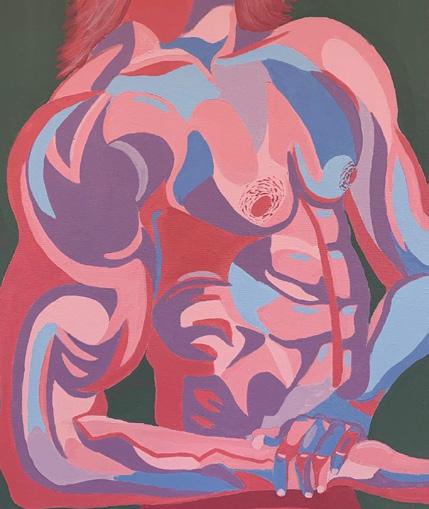
how “everyone uses some form of art to express themselves, whether you make it or just enjoy others, so it’s a shame to see people talk down on the arts.” Thomas voiced this feeling of disrespect in her two fields of study: art and education. “I feel like people constantly judge me when I tell them what I do, sometimes I even laugh at myself a little. [I] constantly get the ‘oh you won’t make any money’ comments.” To add insult to injury, the disrespect Thomas experiences has put her work in harm’s way. “Someone threw away my art when I left it in my studio, and that felt shitty,” she said. “I lost a lot of my really good pieces. It really sucks constantly hearing about the value of art when I don’t feel valued.”

As an aspiring educator, Thomas feels that arts and school don’t have as much priority as they should. “I think a lot of times kids feel embarrassed to be in the arts, and there are so many high schools that just don’t teach art anymore. Art is just making you think of things, it will fix a lot in your life and probably make you smarter.”
But despite the obstacles, Thomas hasn’t let it affect her art. Speaking with her, there’s a sense of a better future and she thinks that we’ll see a new generation of talented artists whon can utilize the Internet to expand and propel their craft. Artists and art will always remain, as will Jordan Thomas, working away at her limestone boulder.
Find her work: @jordan.nicole.art

FRAMED:
13
CRANBERRY SPARKLERS
Words by Cassandra Abel Photo by Vivienne Love
INGREDIENTS
The holidays are a time to spend with your loved ones, and you can’t spell “family time” without alcohol. Instead of adding another food dish to the table or dessert to the brunch, be the life of the party!
This sparkling cocktail is a great way to ring in holiday cheer. And what says cheer like cranberries and champagne? Maybe this drink can even spark that New Year’s kiss at midnight.
Cranberry Simple Syrup:
• 1 cup fresh cranberries (plus 8-12 more for garnish)
• 1 cup water
• 1 cup sugar
Cranberry Sparkler Cocktail:
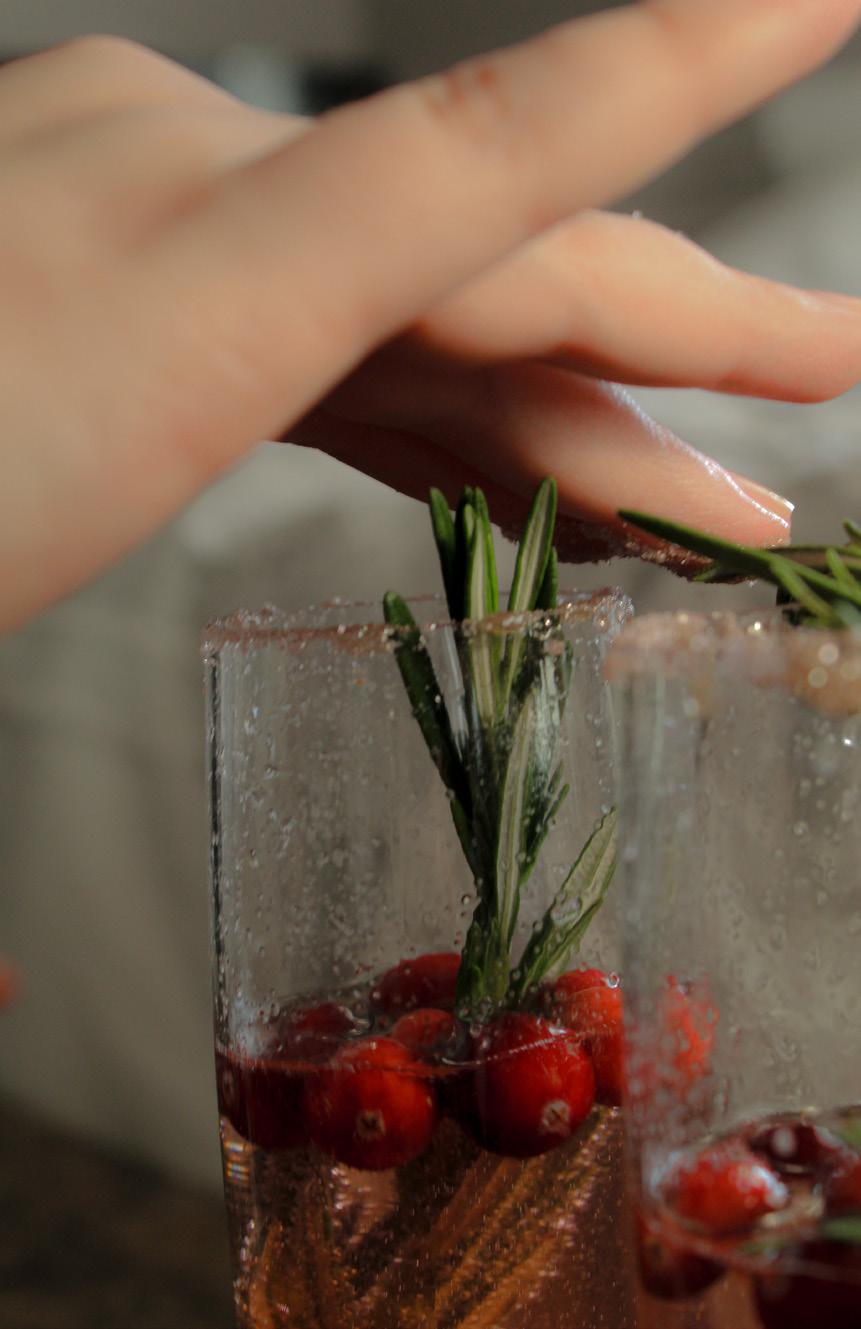
• 1 bottle of Prosecco
• 2 ounces gin
• 4 long sprigs of rosemary (for garnish)
• Gold baking sugar (for the rim) (OPTIONAL)
PROCEDURE
1. In a small saucepan, bring fresh cranberries, water, and sugar to a boil. Reduce heat and simmer for 10 minutes until cranberry simple syrup is bright red. Remove from heat and set aside to cool, about 5 minutes. Pour the syrup through a fine mesh strainer and into an airtight container, discarding the solids. Refrigerate until needed.
2. Use lemon or lime wedge (or whatever you have available) to wet the rims of the flutes and dip each glass in gold baking sugar. Add in a splash (approximately 1/2 oz) of gin to each champagne glass, followed by 2-3 cranberries and 2 ounces of homemade cranberry simple syrup. Fill the remainder of each glass with Prosecco.
3. Top each flute with a sprig of rosemary for garnish and serve.
21 +/-
JERK THIS 14 JERK 1-14
THE CURRENCY OF CATCALLING
Keep your words to yourself.
Words by Julia Reedy Art by Katie Cefalo
Do those legs go all the way up? You’re doin’ that dress a favor, honey. C’mon, don’t be such a bitch. I didn’t want to have sex with you anyways.
Sound familiar? Street harassment, or “catcalling,” is something women face on a daily basis. Catcalling is the sexual harassment of (typically) women in public spaces, mostly by men who are strangers, consisting of verbal and nonverbal behavior.
It’s difficult to pinpoint when catcalling began, but the term “catcall” originated in the 17th century when audience members made hissing and shrieking sounds to mock stage performers. Around this time the term “wolf whistle” also originated, when men use whistling as means to catcall.
Since the inception of catcalling, women have been doing everything in their power to combat catcalling; and in some countries, such as Belgium, Portugal, and France, catcalling and street harassment are now illegal.
In 1976, the non-profit organization “Take Back the Night” was founded in order to advocate for the safety and protection of women and “survivors of all gender identities from all backgrounds across the continents” against sexual assault and violence, according to their mission statement.
In 1989, the United Nations adopted the Safety Audit — a safety checklist for evaluating whether or not a building or environment is safe for women. These evaluations are used for new events, new infrastructure, and changes to public places.
These new policies, laws, and evaluations strive to minimize the amount of catcalling but do not fix the root cause of sexual harassment. Unfortunately, this is a reality that myself and women at Syracuse
University know all too well.
A few weeks ago, my friends and I walked past two men in downtown Syracuse. They called to us: “One, two, three angels! Have a blessed day,” and then, without missing a beat: “Fuck you then, I hope you die.”
We kept walking and carried on with our day, as women are taught to do after receiving death threats.
Madelyn Gosselin, an SU senior, has experienced catcalling both in and around campus, primarily coming from older men. She described one confrontation in particular between herself and a man in his 50s.
“He was clearly drunk, the way he was saying it, and I knew nothing good was going to come of that conversation,” she said. “I’ve made it a rule for my safety to never respond to these kinds of comments. When I didn’t respond to him, the other man he was with called me a bitch, which made me feel guilty, even though I know I did nothing wrong.”
From a young age, women are taught to accept catcalling as a form of flattery and to expect harassment during day-to-day activities. The only advice that can be given is telling them to prepare for it, to ignore it when it happens, to act as though their body was not just degraded, that they weren’t just objectified.
Since catcalling is a shared female experience, the conversation around it becomes incredibly nuanced. When discussing these traumatic experiences, there is a tendency for it to become competition, especially on social media platforms — namely, TikTok.
Discussing catcalling on social media gives
TW: Sexual Harassment
15
the opportunity for making social change, but this new competitive tone women can have while discussing catcalling can make the progress more complicated.
SU professor Selina Gallo-Cruz, who teaches Sex and Gender in Sociology and Women’s and Gender studies said social media serves a purpose powerful to women’s movement by connecting different communities and “allowing many women to recognize that the abuses they have experienced are not merely personal troubles, but public problems.”
On the other hand, Gallo-Cruz said online conversations and activism around catcalling might not be as progressive as we hoped they might be.
“This space might not be as free or wellorganized as other spaces coordinated to facilitate long-term organizing commitments to building change,” Gallo-Cruz said. “They are vulnerable to fleeting interest and participation as much as disruption and even sabotage or trolling.”
More often than not, the experiences of people of color and transgender people are disregarded within the context of street harassment. According to a survey from Stop Street Harassment, people of color, people living on low incomes, and members
of the LGBTQ+ community are disproportionately affected by street harassment.
Those who identify as LGBTQ+ experience more harassment as minors than heterosexual people, with 70% of LGBTQ+ identifying people experiencing harassment by age 17 versus 49% of heterosexual people. People of color are also more likely to experience street harassment, with 41% of people of color saying they experienced street harassment sometimes, often, or daily versus 24% of white people.
Gallo-Cruz explained that this points to different patterns of domination and privilege of some voices over others as well as the need to think more systemically about these issues.
“The objectification of women that happens in street harassment is one of many forms of objectification that happen to marginalized others in different ways,” Gallo-Cruz said. “There is certainly good reason for marginalized groups to form their own safe spaces for dealing with these issues.”
At its core, catcalling is impersonal — it has nothing to do with the victim and everything to do with the men trying to establish a pecking order amongst other men.
“I think it’s telling that when women in 2020 were asked to share what they would do if they could live for one day without men, they overwhelmingly reported they would walk freely in public at night,” Gallo-Cruz said, referencing a 2020 article from The Tab. “It is telling that men recall learning to objectify women at very young ages, as women also recall realizing their objectification at young ages.”
Gallo-Cruz suggested that to eliminate catcalling, it’s crucial to resocialize men, women, and individuals to value relationships based on respect and reciprocity rather than objectification, as well as to implement bystander training while catcalling is unfolding. That way, we may begin to exist in safer spaces where catcalling is a thing of the past.
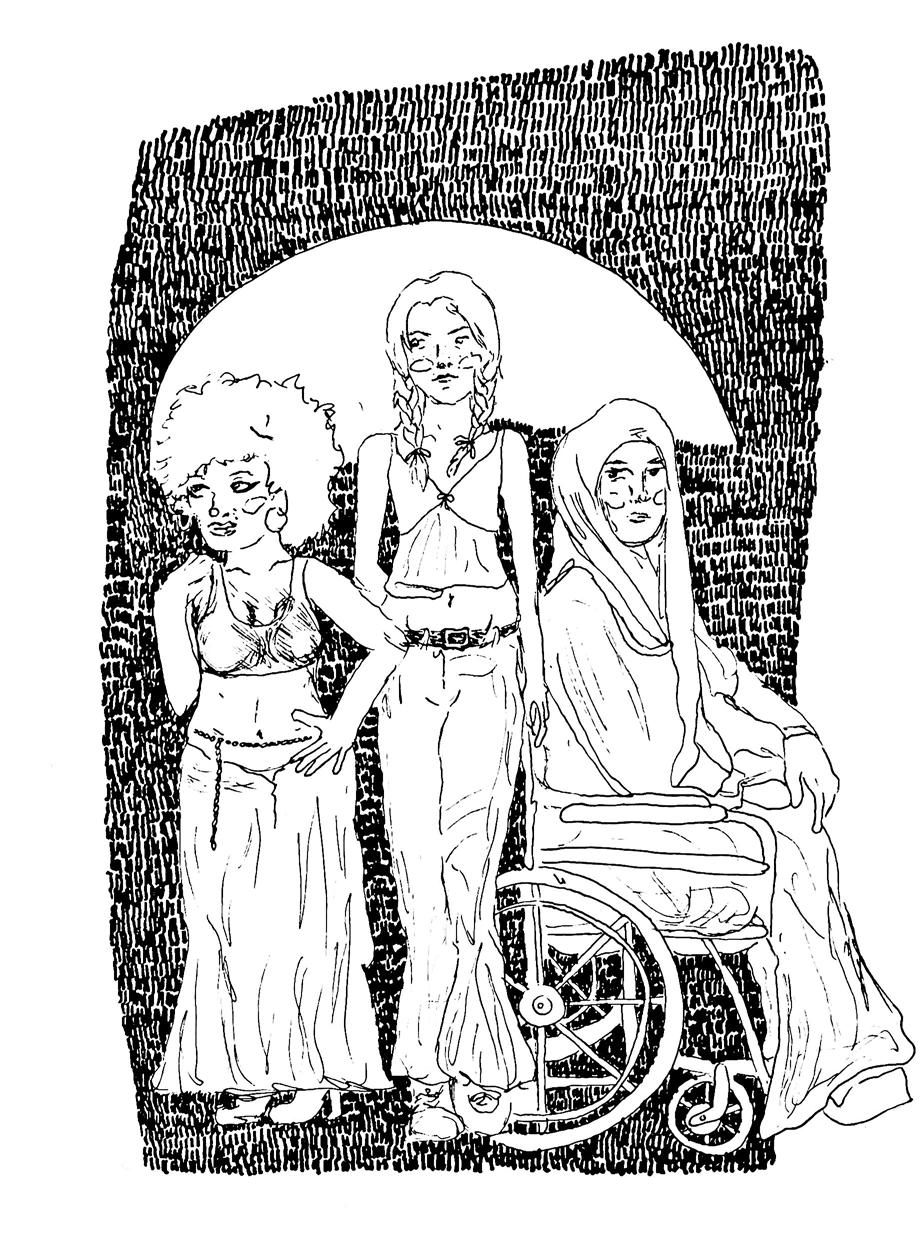
BITCH JERK 16 –21
BITCH 16 JERK 15-22
INFORMATION AGE VS SELFDEPRECATION
Battling the internet’s nihilism one post at a time.
Words by Fifi Azzara Art by Marisa Goldberg
Wake up. Go to class. Check Twitter. Do work. Doomscroll. Fall asleep. Repeat. This cycle, or at least some variation of it, is all too familiar for many of us. In this technological bubble, Gen Z has curated a collective ideology of hopelessness. Through advances in technology and the systemic failures of late-stage capitalism, our generation has been inundated with the belief that we are powerless. It’s not a surprising conclusion, based on the significant themes of our lifetimes — climate crisis, wealth inequality, and systemic racism. Political systems that make meaningful change seem impossible while 24/7 internet access enables us to witness firsthand accounts of atrocities taking place across the globe. We’re watching the slow and shattering collapse of our world and all we can do is post an Instagram infographic about it. This painful truth we’ve learned to live with has resulted in a generation-wide existential crisis of sorts, inundating our culture with nihilistic pessimism about the future. Understandably, Gen Z copes with this struggle through the most chronically online method possible: memes.
The Cruel Indifference of the Universe
From spending 2016 pointing at trash cans just to say “so me” to the sarcastic positive affirmations accounts that once dominated Instagram, our generation’s humor has always been rooted in self-deprecating nihilism. Topics that were once deemed taboo or delicate are now tossed around without thought, and ‘ironic’ videos about suicidal ideation and other maladaptive behaviors are seemingly the norm. This effect only intensified
over the pandemic — the increasing number of TikTok users coupled with political turmoil translated into an entire online culture of activist burnout and nihilism.
Fatalistic slideshows bemoaned the inevitability of corruption and injustice, lingo such as “doomer” or “black pilled” was created to denote those who had given up all faith in positive change. Phoebe Bridgers’ audios became a black hole of pessimism. The dominant form of activism at the time, Instagram infographics, was regularly mocked for its infectivity. While it’s validating to know that you’re not alone in your experience of the world, the constant consumption of such pessimistic media creates an echo chamber of apathy. If everyone is sad, it must be normal, right? If everyone feels like this, there’s no use in trying to change. If everyone is giving up, why shouldn’t you?
The Indomitable Human Spirit
Earlier this year, through political and social turmoil, a TikTok trend slowly rose to popularity. The trend was mostly slideshows featuring elements such as Are Ya Winning, Son and various Wojak’skey components of the pessimistic memes that currently dominated the platform. Yet this trend is far from a new iteration of negativity. Instead, it provided a philosophy completely antithetical to such negativity, celebrating love, grit, and perseverance in the face of hopelessness. This was the Indomitable Human Spirit. Videos featured everything from pro athletes recovering from career-endangering injuries to surgeons spending 60+ hours on life-saving procedures and children
17
surviving life-threatening illnesses. Others depicted positivity as a battle, with the symbol representing the Indomitable Human Spirit always dominating the symbol showing the “cruel indifference of the universe.” The comments these videos garner are uncharacteristically serious for the app, with users often stating how badly they needed to see something positive and others often admitting to tearing up at the videos. One recent video, posted by user @msweach, combats negativity around the midterm election results by highlighting the unprecedented LGBTQ+ representation in our newly elected government. As user @tomw210107 wrote in the comments of one video, “we need to keep this trend alive to keep our spirits alive.”
This trend of positivity in the face of an increasingly absurd world is not confined to memes and chronically-online culture.
As anyone familiar with online culture can attest, such earnest attempts at wholesome content are almost always met with ridicule. Yet, unlike the infamously hated “Live, Laugh, Love,” these memes refuse to shove manufactured positivity down the viewer’s throat.
We’ve grown up watching our politicians stand by as the planet slowly overheats — we know life isn’t all sunshine and rainbows. The Indomitable

Human Spirit trend recognizes this suffering, validating the pain this world can bring while encouraging perseverance anyways. Rather than ignore or suppress the uncertain reality of our world, the The Indomitable Human Spirit provides unrelenting resilience in spite of it. For many online, this kind of positivity and genuine hope for the future offers a lifeline.
The positive impact of the trend is backed by more than just anecdotal comments — research studies by A. Stephen Lenz suggest that hope and resilience can lead to improved mental health outcomes for youth. Additionally, research indicates that maintaining hope in difficult situations increases the ability to mitigate stress, engage in physical activity, and reach personal goals. Beyond the impact of hope on our individual mental health, determination driven by positivity and hope is historically proven to be a key aspect of activist movements. Hope is also an effective counter to climate fatalism. While it’s easy to dismiss these videos as meaningless, barely minute-long clips, the message that they convey holds an unfathomable amount of power. In the face of injustice and uncertainty, the indomitable human spirit is a revolutionary tool of resistance.
BITCH 18 JERK 15-22
THE OFF-CAMPUS CLASSISM DIVIDE
Luxury prevents students from connecting with Syracuse residents.
Words by Sadiya Kherani Art by Hallie Meyer
There are two lifestyles you can pursue once you’ve finished your two-year university housing requirement. The first is living in luxury, whether that be at The 505 on Walnut, Theory, or the newest apartments, The Laurel. The second is living cheaply, which means you probably find yourself walking 5-10 blocks on Euclid in the crisp winter weather, bravely traversing unshoveled sidewalks just to get home after class.
The rent differences between these luxury apartments and the houses on and surrounding Euclid speak volumes. A 3-bedroom in The 505 costs about $1,300 a month, while a house-styled apartment on/off Euclid costs about $750. Keep in mind that if you’re living in one of these Euclid houses you’re probably living with 4-5 roommates, which means that you’re splitting the rent of a giant, formerly family-owned house. Naturally, then, we see a huge gap in the financial backgrounds of the types of students who live in each spot (we’re not blaming either group, of course, but there is certainly a difference).
Like anything, there are pros and cons to living in either the fancy apartments versus the sectioned-off houses. We’ve all seen ads for luxury complexes with pools and open-concept kitchens, amenities that many of us fantasize about coming home to. But there is one thing we’d like to bring your attention to: these luxury student apartments promote separating the student body from the community of Syracuse as a whole.
We all get the emails from DPS: another breakin on Euclid, don’t forget to lock your windows and doors. Leave lights on. Have music playing. Of course robberies will never stop happening, and they’ll continue to exist in higher and lowerincome neighborhoods alike. But if the school
took a second to get to know our neighbors and feel more like a part of the Syracuse neighborhood community, it’s possible that safety wouldn’t have to be such a prevalent concern.
“I live on a safe street that is an offshoot of Euclid, [but] I think there are a handful of people that feel unsafe at times,” Senior Ania Johnston explains. “I know my roommate always has me lock the door, but I didn’t really grow up in an environment where I had to lock the door all the time.”
Some students worry about whether to choose safety or price when house hunting, and it often feels like they can’t have their cake and eat it, too. “The apartment complexes are exponentially more expensive than a typical kind of house-apartment style renting option and it’s unfortunate because the complexes are definitely much safer,” Junior Carina Sarracino explained. Many parents are willing to take out loans and cut into their own savings to make sure their kids stay safe, especially when their kids are so far away from home, but many parents simply cannot afford to do so. Sometimes, this leaves students relegated to oncampus housing for four years — not a fate worse than death, but it carries its own stigma.
The moral of the story is that the University perpetuates this divide. At the end of the day, it is SU’s job to protect the student body equally regardless of income gaps. Sarracino continues, “It makes it so much more difficult to afford that level of safety and I’ve heard a lot of scary stories of people in the house-style apartments getting robbed, broken into, really scary stuff with that,” Sarracino said. When this fear is constantly being fed to students through all the emails, it’s no surprise that people who can afford to live in luxury apartments choose to do so.
19
But why are we perpetuating a concept of living in which the student body is completely isolated from the city itself? All these apartment complexes are advertised as “off-campus STUDENT apartments.” It makes it so you can go through your entire college career without mingling with the community the campus has placed itself in the middle of. Of course we as students spend a lot of time on campus — after all, it’s where all our classes are — but the fact that we rarely interact with the community creates a sort of privileged bubble that can be harmful to us and full-time citizens of Syracuse.
Johnston knew she wanted to live off of Euclid when she started hunting for houses. “I like the aesthetic of old vintage houses and Syracuse is really known for old houses.” She continues by telling us about a website that holds a list of historic houses in Syracuse including information about them and they’re all available for rent. Johnston also loves living in the university neighborhood because “it makes me feel more like an adult and less of a university student.”
As the university begins to buy more offcampus housing (see: The Marshall) and continues
to threaten students with an increased 3-year housing requirement, the question remains: how much will rent go up over the next few years? There’s no question, of course, that it will, but it’s entirely possible that rent increases so much that many students simply can’t afford to live off-campus at all. We’re no Whitman majors, but simple supply-and-demand means that this would allow the university to push up its own room and board prices. We can all guess how that would end — with students being even more beholden to the university than we already are, and having to go even further into debt for popcorn walls and questionable-at-best showers.
Meanwhile, beyond the University Hill neighborhood, the city of Syracuse remains one of the most impoverished and segregated cities in the country, meaning that this rent push could become nothing short of further gentrification. Safety is certainly one thing, but we also cannot ignore our impact on the city in which we spend 9 months of our year. Of course, there are a handful of factors that contribute to rent prices, but it is our responsibility as students and the university’s responsibility as a business to make living in Syracuse as fair as possible for all of us, 505-ers and Euclid trekkers alike.
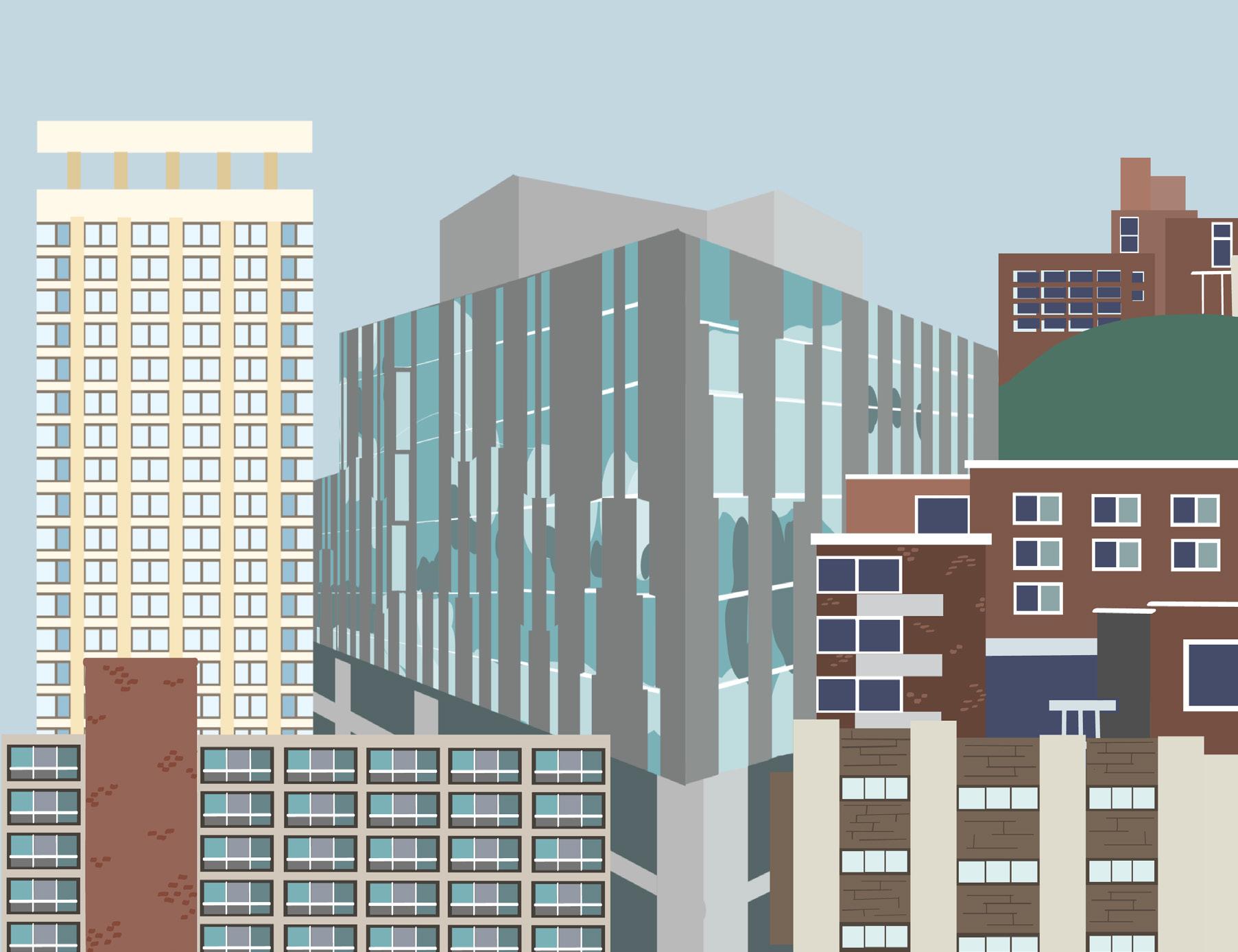
BITCH 20 JERK 15-22
STUDY ABROAD SNOBBERY
Being pretentious isn’t sexy.
Words by Russell Tom Sun Art by Lang Delapa
WE GET IT. ABROAD CHANGED YOU (and yes, before you ask, I also studied abroad). Meanwhile, the rest of us are fed up with hearing about what a wonderful time you had galavanting around the world, traveling to different cities every weekend, and enjoying reliable public transit. We totally get it, you miss your city abroad, and you all make it sound like the most magical place ever. But do you hear yourselves??? You all sound so incredibly obnoxious.
Not everyone has had the privilege of going to study in a foreign country or the flexibility in their major. Many majors at Syracuse don’t allow for students to have the availability to study in a foreign country, especially factoring in trying to transfer credits if you aren’t studying at one of SU’s campuses abroad. In addition, factoring in the costs of going abroad is incredibly inaccessible to some students on campus. Living in Syracuse is expensive enough already, but going to a foreign nation and having to deal with the currency exchange rate? Those of us who are struggling financially would be in greater debt trying to manage the day-to-day necessities. Having the financial freedom to travel abroad at this young age is a liberty that most students will never get to experience, and being able to hop from country to country every weekend is just pouring more salt into the wound. I’m currently chugging a glass of wine while scrolling through my friends’ feeds in Madrid while I somberly write this piece.
And then those who studied abroad come back to campus and have to remind us daily that they studied abroad with their British tote bags, their French sneakers, and their Spanish shot glasses. It’s nauseating to have to see constant
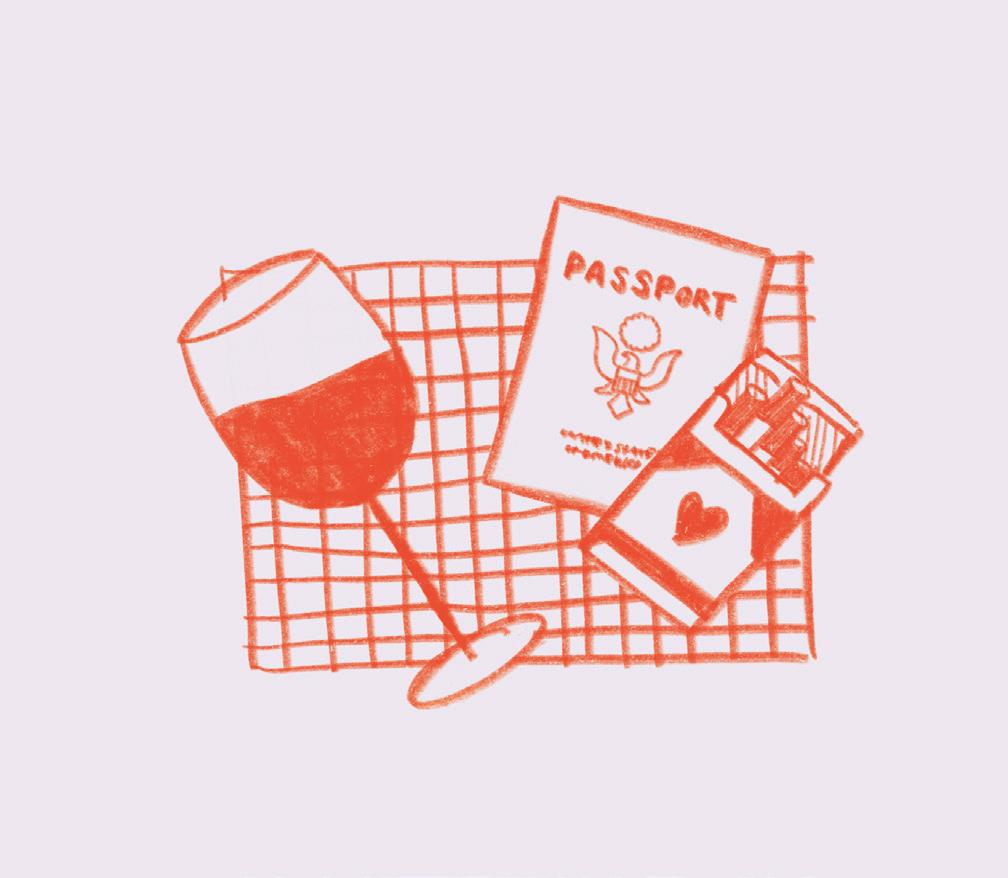
reminders of what they have and what the rest of us lack.
To compensate for the heartache and jealousy I feel, here is a (in my humble opinion) hilarious and somewhat accurate categorization of what type of Syracuse student participates in each study abroad program:
LONDON Aggressively basic heterosexuals who think smoking cigarettes while drunk “doesn’t count”
STRASBOURG People with a slight humiliation kink who really like croissants
MADRID Slutty, bicurious partygoers who only learned to say “cafe con leche”
FLORENCE Sad bisexuals with a slight addiction to red wine who probably went here because they watched Call Me By Your Name
SANTIAGO Granola gays who are okay with being forgotten
PRAGUE Film majors who are either serial monogamists or have commitment issues, no in between
BARCELONA Madrid rejects who didn’t want to learn Spanish. (Also, why did everyone in Greek life go here?!)
DUBLIN Those 5 engineering majors who had to fight tooth and nail to study abroad, much respect
Note: We couldn’t fit all our bitchery on one page, so check out part two of this piece at jerkmagazine.net!
OBITCHUARY:
21

SMUT FEATURES In Smut, we deep-dive into aspects of on and off-campus life that affect you (yes, YOU!). HOME IS WHERE THE HEARTBEAT LAW IS SU students reflect on the way abortion bans have altered their attitudes on sex, protection, and the place they call home. 23 27 35 31 HOW TO SURVIVE A SNOWSTORM SU is known for more than just the snow. PSYCHOANALYTIC DREAM JOURNAL Photoessay DALEY’S TECHNICOLOR DREAMCOAT In 2004, Father Fred Daley was one of the few openly gay priests in America. Today, he continues his mission to support social justice work. SMUT JERK 22 23-40
HOME IS WHERE THE HEARTBEAT LAW IS
SU students reflect on the way abortion bans have altered their attitudes on sex, protection, and the place they call home.
Words by Jojo Wertheimer Art by Hannah Landon
This June, the right to a safe and legal abortion slipped through the fingers of almost 1 in 3 American women. The Supreme Court finally performed the ultimate time travel trick: turning back the clock to before 1973, the year when Roe v. Wade federally legalized abortion in the U.S. The effect of the Supreme Court’s decision to overturn Roe v. Wade was immediate, with trigger laws in 13 states banning abortions, or planning to do so in the near future. In Kentucky, the fallout was instantaneous; A 2019 trigger law makes abortion a felony, regardless of rape or incest. For Syracuse University junior and Kentucky native Jenna Muschong, the change in legislation was very upsetting.
“I’ve never had to get an abortion and I’ve never had a pregnancy scare,” she said. “[But], it’s scary to think that if I didn’t go to school in New York, and if I did get pregnant at the University of Kentucky or something, then I wouldn’t have access to [an abortion].”
Muschong explained that the new legislation was especially bothersome because those in rural, poor areas are usually those in the most need of contraception and abortions. She is worried that her home state will see extreme consequences to the overturning of Roe v. Wade since she described Kentucky as a state without great education or healthcare.
“Thankfully I’m privileged enough to go school in a state with plenty of abortion clinics, and even if I did get pregnant in Kentucky, I would have the access to drive out of state to get one,” says Muschong. “It makes me reflect a lot on the privilege that I have to do that. There are so many
Kentuckians that can’t.”
On a campus littered with students from all over the country, Muschong’s feelings of sadness, fear, and relief are far from isolated. Many students, like senior Arleigh Perkins from Kansas, felt shocked when they first learned about the overturning.
“It definitely gave me a terrible feeling in my stomach,” she said. “I don’t think anybody would ideally ever want to have an abortion, and I think that’s the most compassionate way to look at it. It’s not anybody’s ideal situation.”
Perkins said the overturning “brings up a ton of emotions” because to her, it seems like the overturning is a way to take power away from women. She says that cisgender men, no matter their views on abortion, will “never have to feel the stress in a way that a woman will.”
The stress of avoiding unwanted pregnancy is not new for female students. However, no longer being able to count on abortion as a last resort has added a new layer of anxiety, leading many students to change their attitudes about sex at home.
“You have to be ultra careful, especially [about] who you’re doing it with,” says Leah Kim, an SU freshman from Texas. “It turned to, ‘I have to really like you, I have to really trust you, really know you, and make sure that you understand the responsibilities that I would have to bear.’”
With no exceptions for rape or incest, the abortion ban in Texas starkly contrasts the prochoice legislation of New York State. Culturally, the difference can be jarring, especially as students return home for the holidays.
“Coming [to New York] has been a culture
23

SMUT JERK 24 23-40
shock in a way,” says Kim. “Here, it’s surprising [to me] to hear adults agree that, ‘oh, abortion should be accessible... Adults [in Texas] have a lot more anti-abortion rhetoric, rather than here where most of the adults I’ve talked to have not been like that.” This stark rift in culture and legislation also
has crucial impacts on the way students view contraception. In fact, the changing legislation has led Muschong to value contraception in Kentucky in a different way than she does in New York.
“I would be a lot more careful about my sexual attitudes and behaviors [in Kentucky] than I

25
would at school in New York,” Muschong says. “Contraception is super important, obviously, but I would say that it’s not top priority for me here like it would be in Kentucky... It’s not as scary [in New York] to think about [not having] contraception at the moment. I wouldn’t be as freaked out.”
Like Muschong, many students feel that contraception is more important than ever since the overturning has taken effect. Even for students who don’t like the side effects or the idea of taking the pill or using other contraceptive methods, the pros have begun to outweigh the cons.
“The week before it got overturned I was really debating going off of my birth control pills, just because the side effects can get kind of annoying, and then it got overturned and I was like, ‘there’s actually no way that I’m going to go off it now,’” Muschong said.
However, in Supreme Court Justice Clarence Thomas’s concurring opinion on the overturning of Roe v. Wade, Americans’ access to contraception was also threatened. In July, the Right to Contraception Act — legislation with the potential to federally protect access to birth control — passed in the House but fell short in the Senate, partly due to nearly all of Texas representatives voting against it.
“I know in Texas, they’re looking at banning or having less accessible birth control, and that’s very frustrating because if I’m going to have sex, I want to know that it’s going to be safe,” Kim said. “I want to know that I’m going to be okay... and be able to make sure that my body’s okay. And without accessible birth control, that’s not an option. It really limits it to not having sex.”
For many young women, the gravity of choice is so strong that the overturning of Roe v. Wade has impacted their future plans. Whether it be college decisions or post-grad plans, location has an entirely new meaning when abortion rights aren’t nationally protected.
“It solidified that I would not be coming back,” says Kim, who says she will not be considering Texas when she explores places to attend grad school. “I know I’m going to be most comfortable in a state where I know I can have freedom over what I can do with myself. Especially when I’m older, if I need [an abortion], [I want to] know it’s accessible.”
Perkins, on the other hand, sees things
differently and continues to consider moving back to Kentucky post-college as a viable option.
“It’s important to not write off places because of [these] things. Like how is change going to happen if you’re not willing to be a part of it?” Perkins said. “I’m happy that I’m able to vote in Kansas. I’m happy that I’m able to talk to some of the people I’ve talked to in Kansas and have those conversations. Because, if nobody challenges anything or at least brings it up, how is anything ever going to change?”
SMUT JERK 26 23-40
HOW TO SURVIVE A SNOWSTORM

SU is known for more than just the snow.
Words by Naimah Rahman Art by Thelma Gies
Winter on one of the snowiest campuses can come as a shock to those coming from around the globe. The white powder litters the campus and becomes the new norm. Depending on where you are from, you probably have dealt with snow in some capacity. You admire the beauty of the first snowfall and what it represents. But snow quickly turns to slough. Slough that ruins your shoes. Slough that does not seem to melt. Slough that can not seem to give you a break.
27
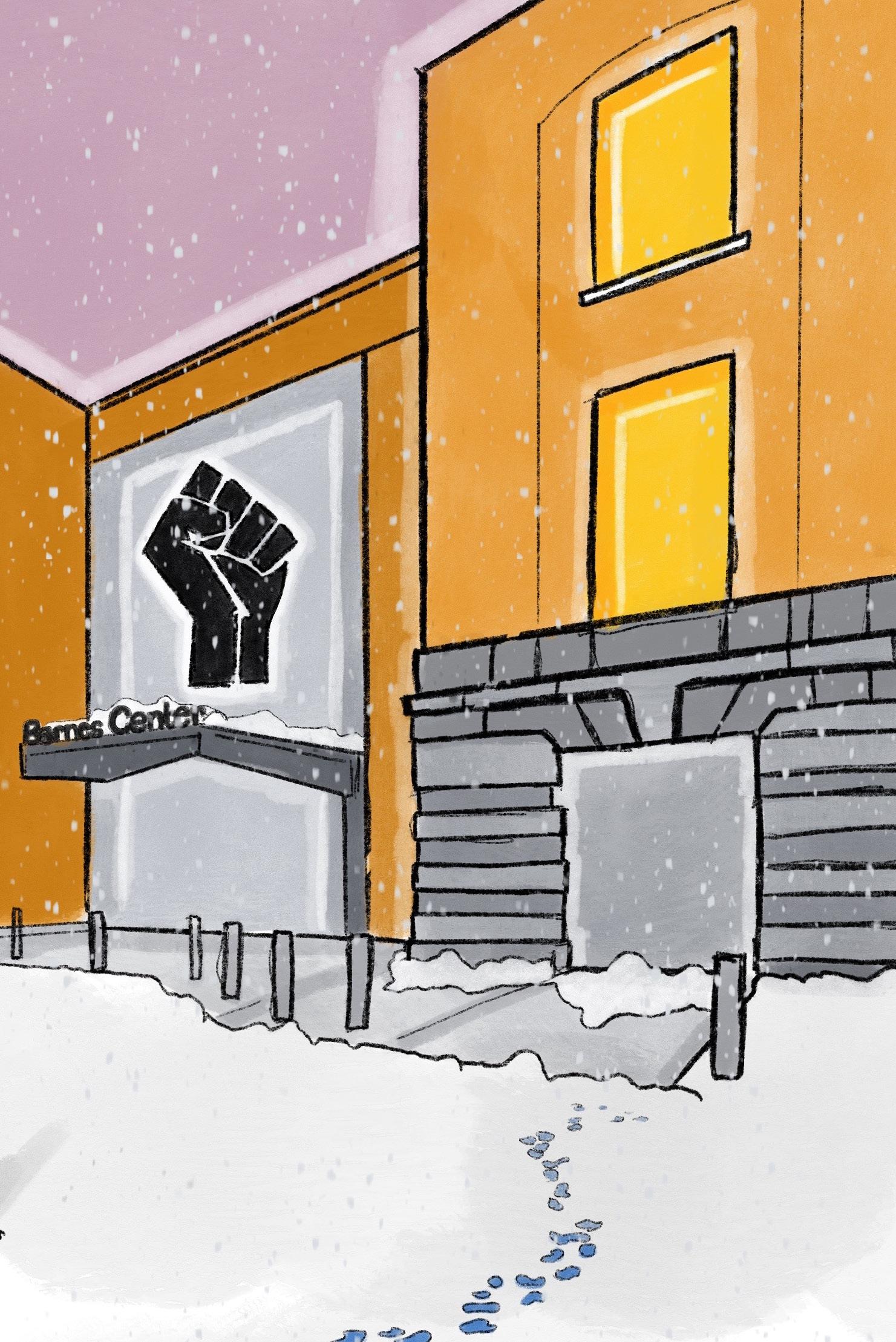
SMUT JERK 28 23-40
For many, the snow does not just fall out of the sky. Snow walks our campus, snow is our professor, snow writes our curriculums. Snow is white people and white people quickly turn to slough at predominately white institutions.

As winter makes its entrance the snow can become increasingly difficult to deal with. For some of us, it is not our first winter at SU, and for others, they are learning which snow boots are the right fit to protect them.
Out of SU’s student body, 54.7% of the student body is white. Although this is a statistic I can search in the SU database, it is one my eyes meet every day. As a South Asian woman, my identity quickly became the loudest in any room. As a student studying Broadcast and Digital Journalism at the S.I. Newhouse School Of Public Communications, in every room I walk into I am met with blank stares. Stares of “How did you get in here?”, “Are you lost?” and “what major are you?”
The snowstorm starts as flurries. But SU quickly allows the flurries to become a storm. The University has a history of its treatment of students of color and it manifests in how the administration conducts itself today. First-Year Seminar 101 (FYS) is a result of the rash of hate crimes on campus that triggered #NOTAGAINSU in 2019 and was meant to replace SEM 100. The FYS class was intended to teach bias-related incidents to first-year students in order to prevent further bias-related incidents on campus after these incidents. However, as someone who took the newly instated FYS, prior to my knowledge of SU’s history leading up to the course, I could not tell you what the class’s intentions were. There were some weeks that focused on home colleges, while other weeks felt like the instructor was pulling teeth to get the few minorities in the room to speak about their identity.
If you are of any marginalized group, expect your identity to be a topic of conversation. This can
29
usually feel degrading and frustrating. But like any snowstorm, you always prepare.
Your gloves become your ability to stand your ground. “Where are you from?” “New York.” “No where are you really from?” “Oh! Brooklyn.” Don’t give them the answer they want because it is not the question they are asking.
Your snow boots become your ability to set boundaries. Being a part of a marginalized group creates a sense of curiosity for the people around you. Neha Chauhan, a South Asian senior, recalls being a freshman at SU during the NOTAGAINSU movement and having to educate her white roommate on what was going on.
“Not again SU specifically, made me feel uncomfortable interacting with white students,” she said.
There are times while being on a PWI that your identity feels like a lesson waiting to be taught. White people often expect you to be the voice of all students of color while not understanding that everyone’s experience is different. This year a white student asked me for advice on how to interact with Black students on campus. Instances like this are where boundaries need to be set. It is not a person of color’s job to teach white students why students of color deserve fair treatment.
Your coat is your resource. The common theme amongst students of color is finding a support system on campus that reflects them. Summer Green credits the school for creating 119 Euclid, a space created to celebrate the Black student experience at SU. Green copes with being on a PWI by seeking out students of color. She describes how, coming into college, she was aware SU was a PWI and felt prepared since her high school had the same demographic. However, upon coming here she saw a difference due to the sheer size of SU.
“I feel for students who were not prepared to come to a PWI the same way I was. If it can be challenging for me and I came from PWIs, I can’t imagine the 180 it is for other students.”
Green talks about her experience in STEM classes on campus.
“I am usually the only Black woman in the room. The classes don’t feel like they are taught for me. It feels isolating,” she says. “It creates this mentality of ‘Do they really want me here? Do they even want
me to succeed?’”
SU has multiple schools and colleges, all with their own demographic. Each program has its own set of diversity issues. As a woman of color in Newhouse, I am often the only person of my identity in the room. I am currently taking two Newhouse classes. In one, I am one of two women and the only woman of color. In the other, I am one of two women of color and one of seven women in the class. It scares me when I see the diversity rates in these classes. The future of communications is in the hands of white men who think peak journalism is calling a baseball game.
Enoca Shin, an Asian-American student at Whitman expresses her distaste for the program’s lack of diversity:
“There are definitely times where because of my race I don’t fit in.”
The class of 2023 is the final graduating class to have witnessed NOTAGAINSU and the steps taken to keep the situation at bay. SU senior Uchechi Onyenkpa recalls her freshman year at SU and the instances that were not handled properly.
“There was a time freshman year when I was hanging out with friends and had to walk back to my dorm late at night. I knew DPS had a transportation shuttle service for this exact situation. When I called they basically told me I was on my own. This made no sense to me because everyone on campus knew about how unsafe it was for Black people to walk alone.”
Onyenkpa and Chauhan credit COVID-19 for allowing people to forget about NOTAGAINSU. The 2020 lockdown caused the campus to become desolate. Both believe if there was never a lockdown that the movement would have reached its full potential.
There can be beauty in a snowstorm. Keeping warm by spending time with the people who empathize with you. Making the first steps in untouched snow can be more powerful than the slough that might keep us at bay.
SMUT JERK 30 23-40
DALEY’S TECHNICOLOR DREAMCOAT
In 2004, Father Fred Daley was one of the few openly gay priests in America. Today, he continues his mission to support social justice work.
Words by Eden Stratton Photos provided
Father Fred Daley is a difficult man to track down. He isn’t an avid email user, and his voice inbox happily chirps that he doesn’t text. His head of pastoral care, Barbara Hadley, tells me not to worry.
“He’s a busy man,” she said. “But he always makes time for people.”
Days later, after leaving enough voicemails to fill an inbox, I get a call.
Despite the phone’s crackle, Daley’s voice is warm and jovial. He’s completely unbothered by my slew of messages, and is interested in the articles I’m writing. Upon hearing that he’s the subject of a profile, he starts simply at the beginning.
In 1947, Father Daley was born in Syracuse, and fondly remembers growing up with his twin brother John. Hailing from an Irish-Catholic family, the Daleys were heavily involved with their church and came to mass almost every Sunday. However, Daley said that his upbringing was never rigid or strict, and had a relatively typical childhood.
Daley said that in those days, plenty of children felt called to become a priest. They experienced a presence from God, and wouldn’t hesitate to tell the Catholic school’s nuns. Daley had always admired the priests in his church and felt a calling to pursue ministry. Unlike his peers, however, softspoken Daley didn’t vocalize his thoughts until he entered the eighth grade. The defining moment came when his teacher, Sister Helen-Lucille, asked if he ever thought about pursuing seminary school.
“A sister thinks I could be a priest, so [I thought] maybe I could,” Daley said. “That was a big moment [in] making the intention to go in that direction.”
From that conversation onward, Daley continued to foster his interest in priesthood and would eventually go to seminary school upon his high school graduation. It was eight years of rigorous study — plenty of time for Daley to reconsider his aspirations. The Catholic Church demanded personal sacrifices, requiring its priests to take a vow of celibacy. However, Daley remained convinced that God had called him for a higher purpose.
“Being with the community of other seminarians, [my] call was certainly affirmed by those around me, as well by God,” he said. “There was never a time that I thought, ‘well, maybe I should be doing something else,’ or ‘maybe this [isn’t] what I’m supposed to be doing.’”
Upon his ordination in 1974, Daley was placed at a parish in Utica, New York. He instantly was taken with life as an associate priest, filling his days with baptisms, funerals, and services. Daley was especially motivated to do good in his surrounding community.
It wasn’t a new mission for Daley. Since childhood, he had been pushed to help those who were less fortunate. When Daley was in second grade, his mother asked him and his brother to make a list of children they wanted to invite to their birthday party. When she saw that they had
31
omitted the names of the underprivileged children in the neighborhood, she quickly pushed her boys to include them.
The brothers did. When the day came, the children’s mother called to confirm that her children actually were invited. They usually were overlooked, ostracized by their classmates, and never the first candidates to be invited to a birthday party.
Daley’s mother insisted they were welcome. When the children came, they brought fire trucks for Daley and John, wrapped securely in aluminum foil.
To Daley, they were the nicest presents of all.
“I always look back at that, my mother in particular, [who] was always pointing out [and] caring for those that are marginalized,” he said.
As a priest, Daley kept making an effort to include those who hadn’t been given a seat at the table. But as time went on, he began to feel an ache within himself. Today, he speculates that it was depression, but in the 1970s it was an abstract and uncommon diagnosis. While the ache persisted, by his late 20s he eventually realized its cause.
Daley was gay.
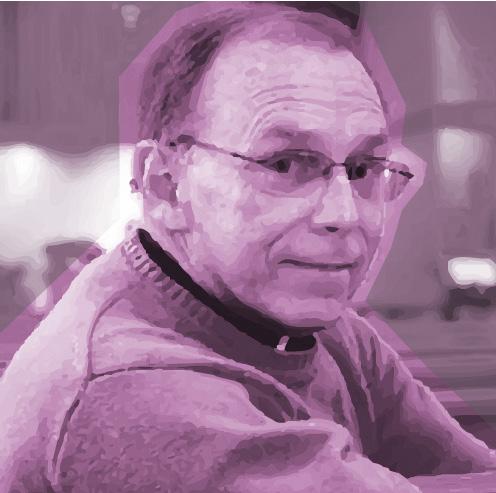
SMUT JERK 32 23-40
As the rest of the world was basking in the sexual revolution of the 70s, the young Daley had gone through seminary school with no idea if he was gay, straight, or somewhere in between. If the seminary students were going to “make it to the end” of their schooling he said, sexual repression was the only option.
By the time Daley realized his sexuality, he was an ordained priest. He had taken his vows of celibacy and was seen as a religious leader in his community. While organizations such as New Ways Ministries tried to reconcile homosexuality with Catholicism, the mainstream church maintained its position against it.
Despite the obstacles, Daley turned to others for help.
“I remember going to a priest for spiritual direction and that began a slow journey with the help of some therapy to eventually accept who I was, and then beginning to rejoice in who I am and who God created me to be,” Daley said. “That journey was a painful journey, but it was a fruitful one.”
Daley would continue his ministry work throughout the years, focusing on poverty, racial justice, and LGBTQ+ rights, opening soup kitchens and shelters. In his words, Daley’s approach to the priesthood was taking on issues with “the Bible in one hand, and the New York Times in the other.”
But, the peace wouldn’t last. In 2002, the Boston Globe reported widespread sexual abuse by Catholic clergy members, and Daley said the Church was beginning to use gay priests as scapegoats. While Daley was only out to close friends and family members, the tensions were becoming palpable.
In 2004, a young journalist approached Daley concerning his recent award from United Way Ministries. When she asked Daley about his history and his journey, the priest felt an immense wave of peace. As the journalist asked about his involvement in the LGBTQ+ community, he simply said that he was gay.
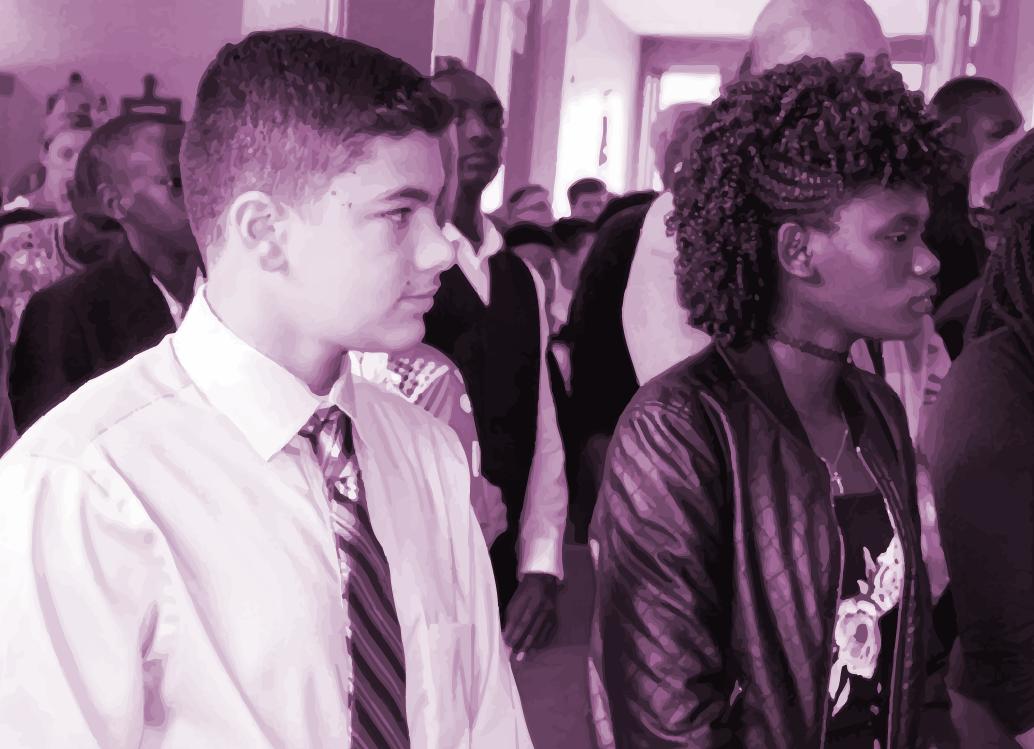
In an instant, everyone knew.
“That night I went to receive the award and I think the probably the longest stretch of time in my
33
life,” Daley said.
To Daley’s surprise, almost all of the parish members would show him support. A woman named Mary, who was as conservative as one could be, simply gave Father Daley a hug when she heard the news.
“It’s okay, Father,” she said. “I love men too.”
In 2008, Daley would come to All Saints Church, which was in a period of profound upheaval. The parish, which was formerly St. Therese, merged with Our Lady of Solace a predominantly AfricanAmerican church. St. Therese would keep their parish building, but members from Our Lady of Solace would be forced to give up their building due to the lack of space.
Daley was tasked with bringing the two parishes together. Instead of ignoring the pain of the parishioners from Our Lady of Solace, he acknowledged them.
“He just brought everybody together and let them express their anger and the sadness,” Barbara Hadley, All Saints’ head of the pastoral case, said. “He just gave credence to what their feelings were.
We all gradually came together as one.”

Today, Daley continues his ministry work. While his life remains relatively the same as it was before he came out, he has received plenty of pushback. He was once rejected from a missionary trip by Catholic leadership and only received notice a week before his departure.
“I got a call from the vice president of Catholic Relief Services saying that they had found out that I was an openly gay priest,” he said. “Therefore, I would not be acceptable.”
To his parish, however, Daley represents the best that All Saints has to offer. In his time at All Saints, Daley has established multiple church task forces combating racism, sexism, and homophobia. Cherie Cogan, the New American Minister of All Saints, said that Daley personally handles every negative letter that comes their way.
“People send letters here whenever they’re not happy with [anything All Saints] does,” Cogan said. “He takes the steps to answer the letters or to explain the reason we do the things.”
“Sometimes, I wonder if he’s Jesus Christ.”
SMUT JERK 34 23-40
PHOTOESSAY:
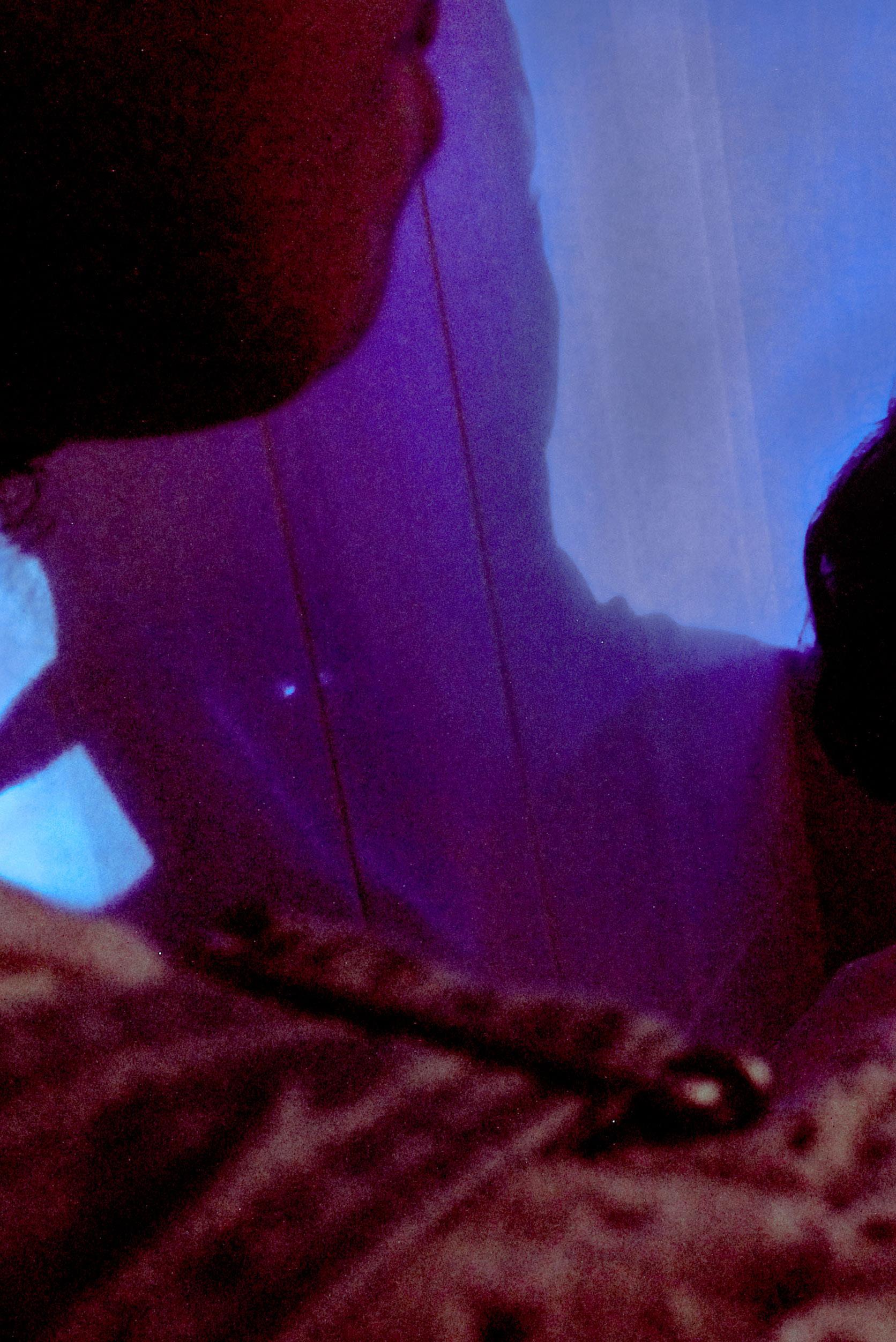
Psychoanalytic Dream Journal
Photos and words by Joelle de 35
Poto

SMUT JERK 36 23-40
I am a frequent user of a dream journal for documenting my dreams because I love trying to capture the details of my ephemeral dreams. Even though fully remembering dreams is challenging and near impossible, I have always had a fascination with the surreal and indescribable. For this photo essay, I wanted to attempt to capture other people’s retellings of their dreams via photography. As a part of the process, I created a Google form where people could anonymously submit their dreams. Using this form, I planned photo shoots and tried to capture the overall feeling of the dreams. It was an interesting challenge trying to capture dreams through such a representational medium.
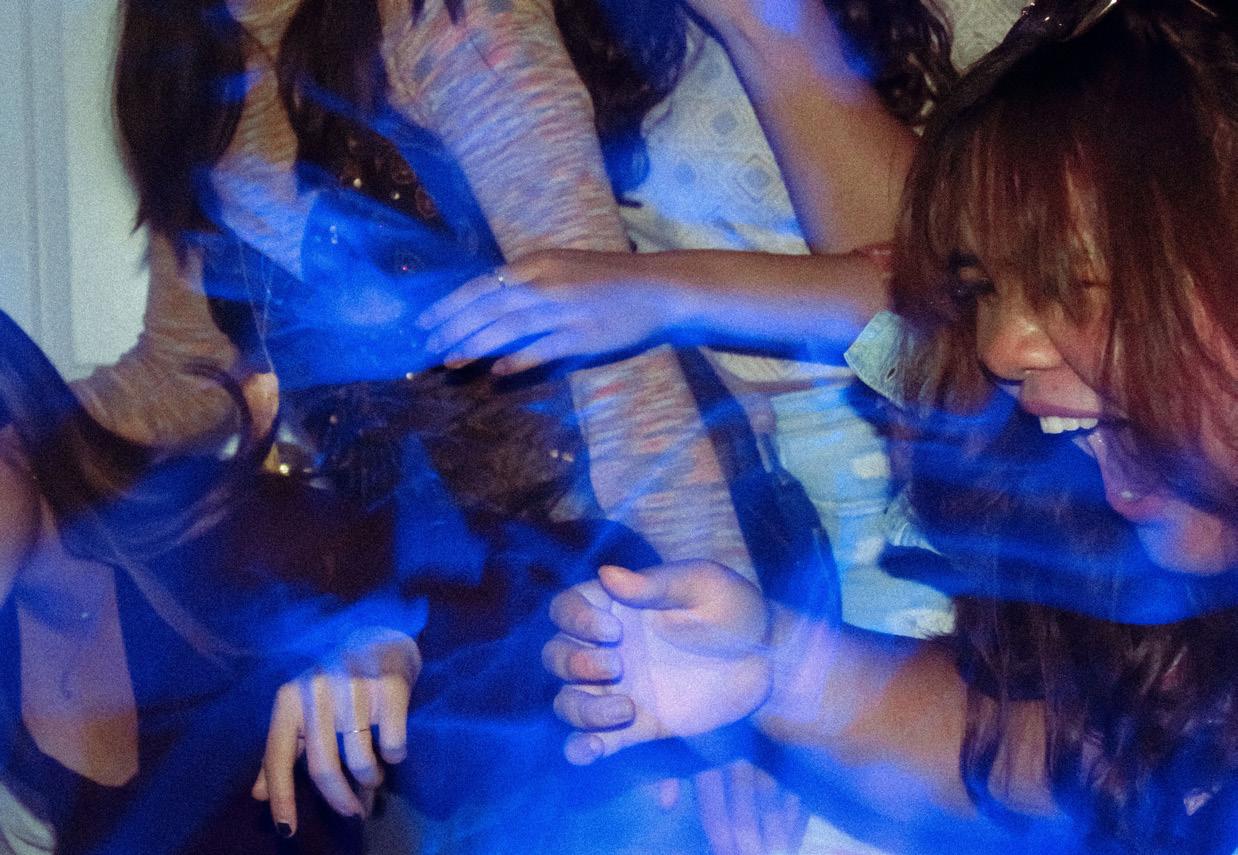
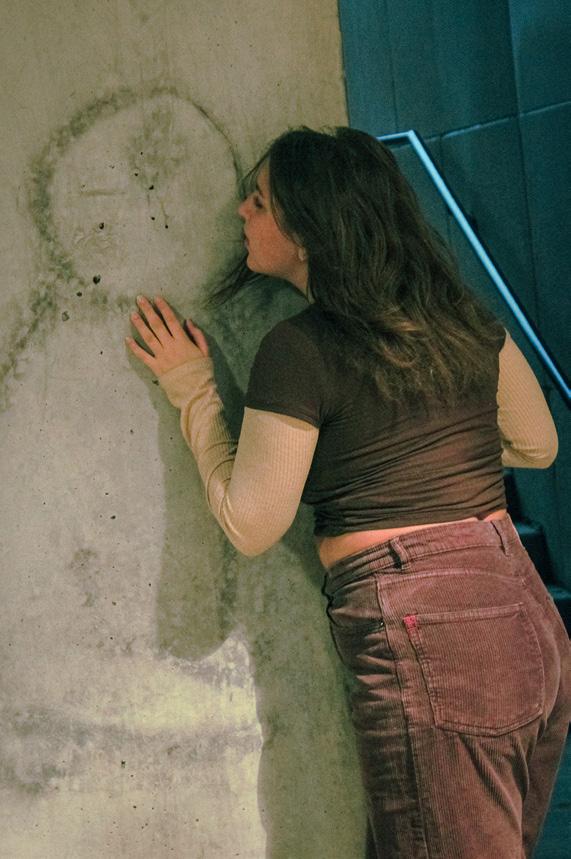
Editing was one of the most integral parts of this photo shoot because many of the shoots required photo montaging to recreate the unrealistic events of the dreams. I loved being able to play around with fusing reality with surrealism because it offered me insight into the meaning of dreams. Seeing the dreams laid out visually allowed me to better understand the nature of dreams.
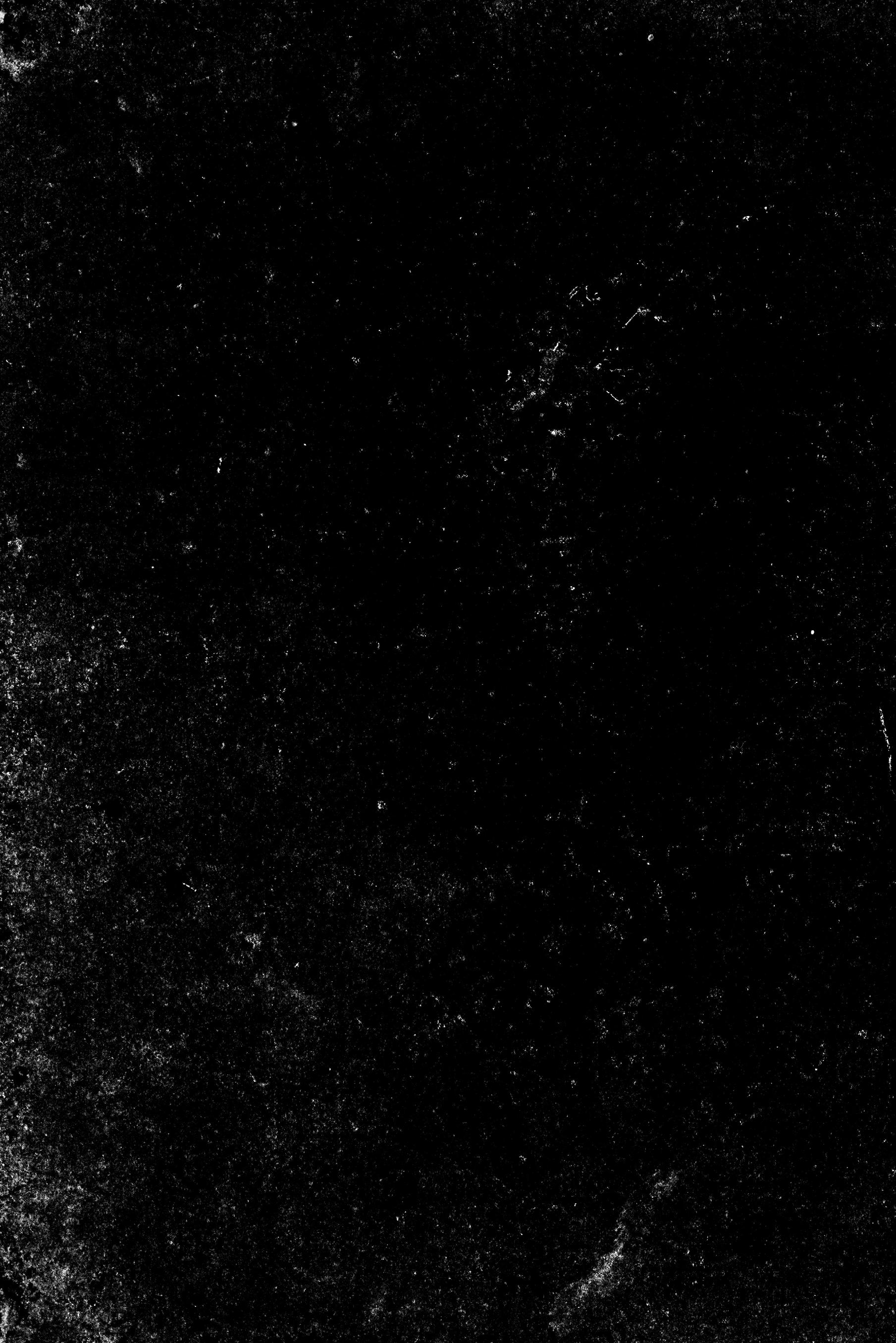
37

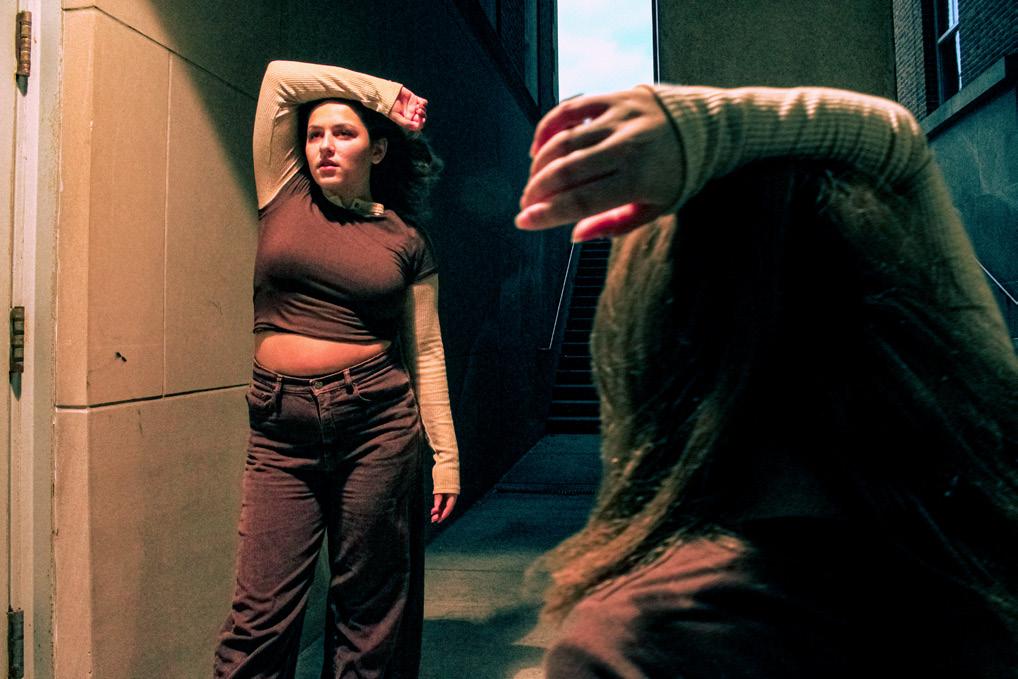

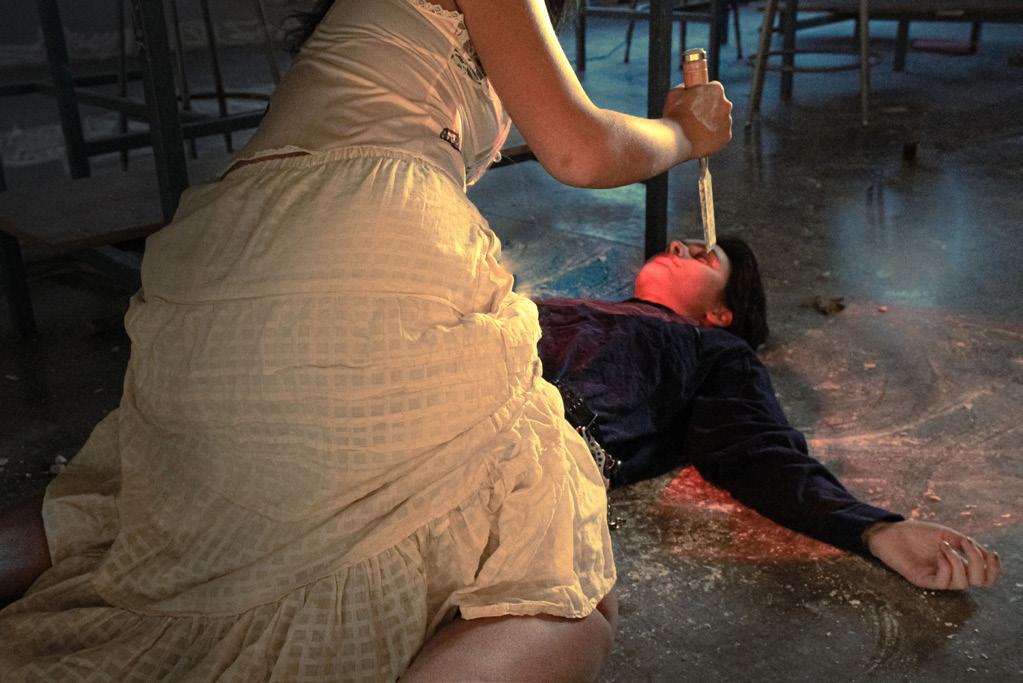
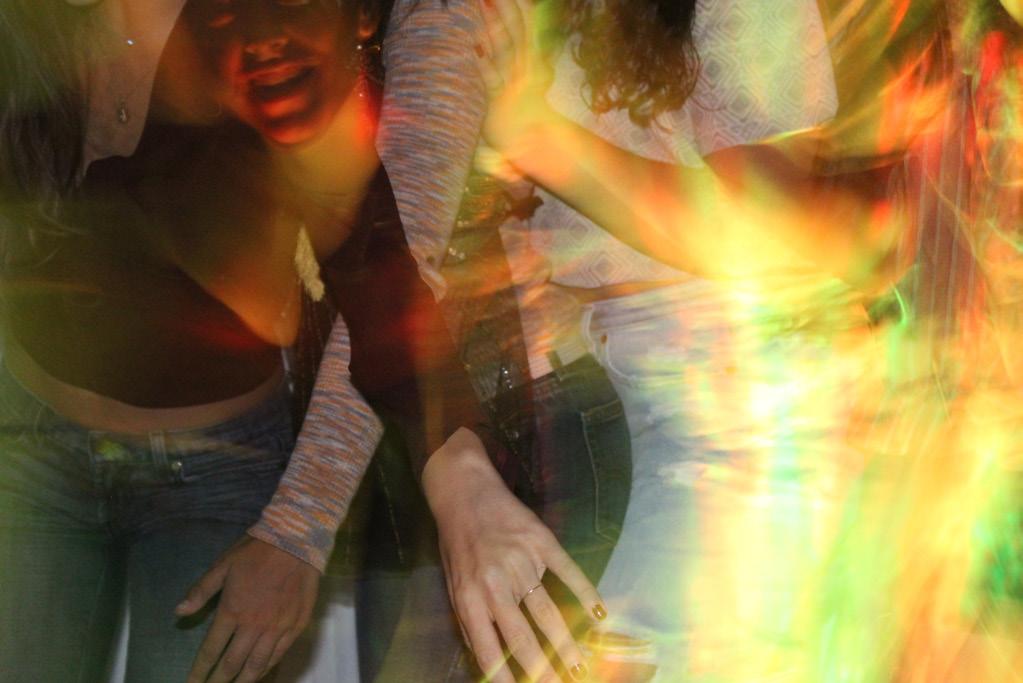
SMUT JERK 38 23-40
SPEAKEASY:
WHO YOU GONNA CALL? FOOD BUSTERS!
Words by Sarah Dolgin Photo provided
Lucy Olcott puts her heart into forging bonds with neighboring students at Henninger High School.
Raised in Fayetteville and now an SU sophomore studying medicinal chemistry, Olcott encompasses the rare combination of the local and university perspectives — and their lack of intersection.
“Being at Syracuse University, we’re very isolated from a community that we are living in. We’re surrounded by so many school districts, by so many people,” Olcott says. “So many different things are happening around us that we don’t see within the Syracuse University bubble.”
Olcott began volunteering for the Food Busters program her freshman year fall semester, initially joining the Nutrition Initiative through the Shaw Center after hearing about it from a friend in Falk College.
The program entails creating lesson plans and facilitating food science experiments through various in-person sessions at HHS.
As a volunteer, Olcott gained hands-on experience working with students as they navigated the experiments. This year, Olcott took on a leadership role as an intern for the program. She is responsible for creating the weekly lesson plans, as well as going into the classrooms with volunteers to delegate experiment materials and
keep the agenda smooth-sailing.
“We’ve done some labs where we extract DNA from strawberries, and we did a lab where we tested different iodine concentrations in salt, fun things that show the students that science is really everywhere,” Olcott says.
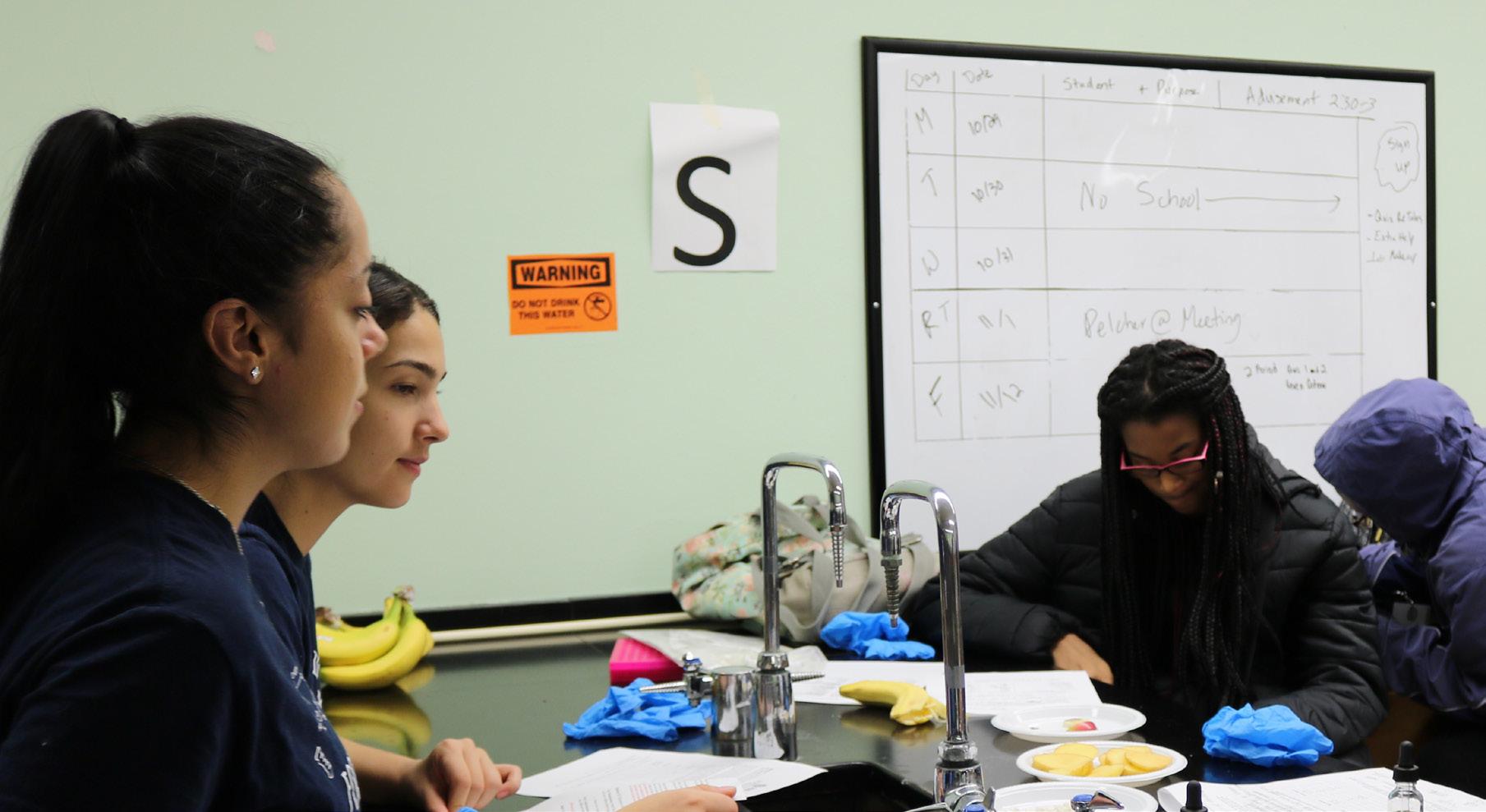
While SU students like Olcott plan the lessons, she says that the learning goes both ways.
“The Shaw Center is definitely a reciprocal learning environment where we’re teaching the students, but they’re also teaching us,” she says. “We learn so much from them every day, whether they’re telling us about everything they did that week, or they’re telling us about their classes — them engaging with us and being able to talk with us and sit with us and really work with us, it’s just such an awesome experience.”
The sadness of leaving for the holiday break is also a reciprocal sentiment, Olcott tells Jerk , as the Friday sessions are cherished by the SU and high school students alike.
“Being able to work with the community that I grew up right next to is really important to me,” she says. “I think that will be something that’s important to me for the rest of my life.”
To learn more, email NSDvol@syr.edu or visit https://shawcenter.syr.edu/.
SU sophomore Lucy Olcott tells Jerk about the joys of engaging the
local high school community through the science of food.
39
COURAGE, CARE, AND CANDLES
BeeKind is paving the way for sustainable, clean candles for all to enjoy.
Words by Eden Stratton Photo by Ellie Stern
Tucked next to Recess Coffee on Tipperary Hill, a small candle shop sits with a bee emblazoned on its front door. Inside holds a plethora of scents, from cranberry and apple jack to watermelon lemonade and ocean air. BeeKind, one of the newest candle shops in Syracuse, has always been unconventional and prides itself on its commitment to sustainability.
While businesses struggled during the COVID-19 pandemic, BeeKind chose boldness in spite of uncertainty and opened despite the obstacles.
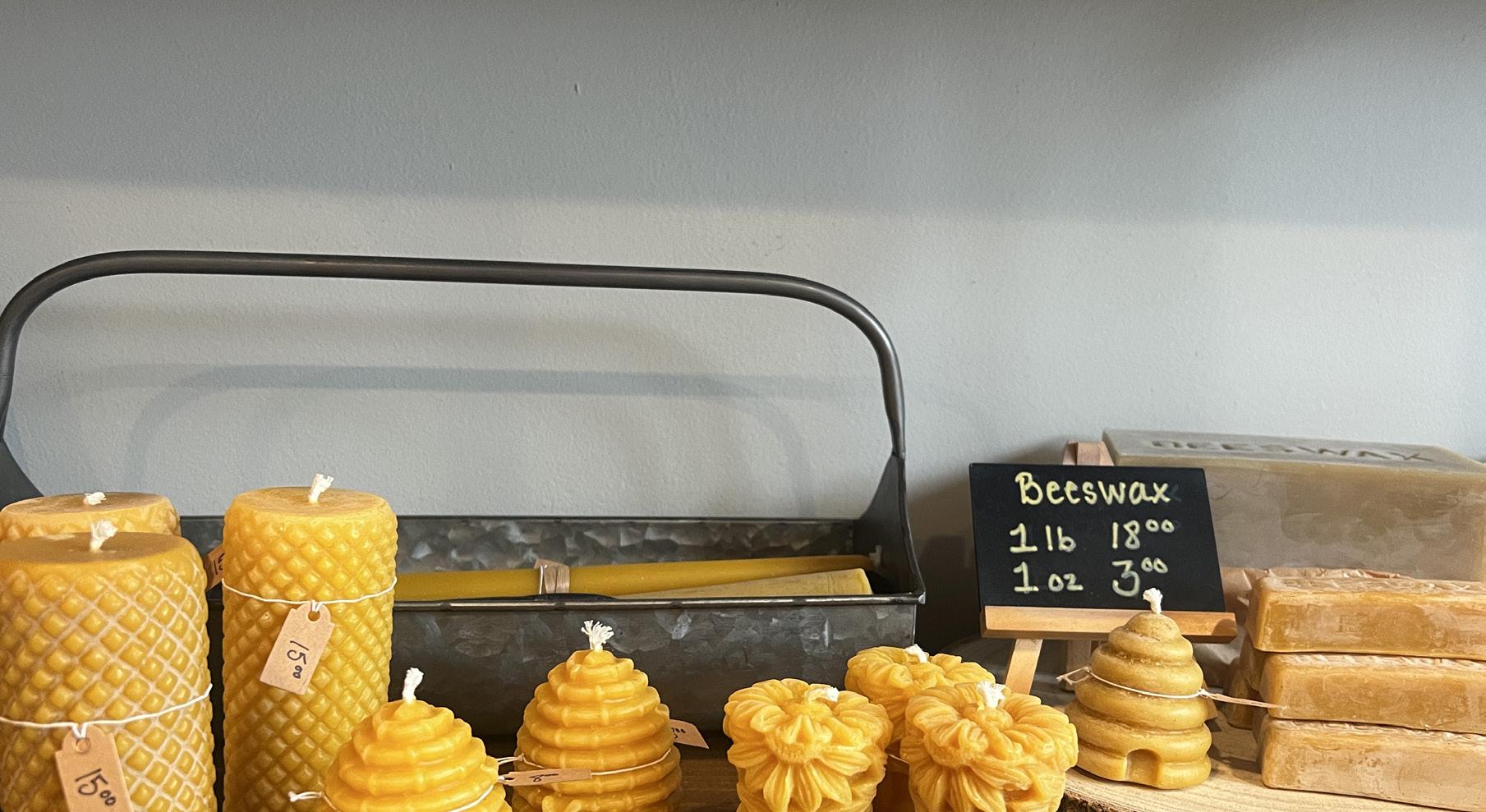
“It was a little scary, honestly. We never really knew anything pre-pandemic because we did start in the midst of it,” said Jill Barrett, co-owner of BeeKind. “But, you know, we figured a lot of people were starting to try to focus on just small local businesses.”
Like many during the pandemic, Jill and her sister Jenna were cooped up inside with newfound free time. While the world binged Tiger King, the Barrett sisters began making candles from their homes. As they experimented with their scents, sheltered comfortably in their living room, the two dreamed of having their own shop. They soon fell deeper into their newfound passion, and realized working together could make their dreams a reality.
“[Jenna] had experience running a shop and managing employees, so we [were] able to figure
out how to run our own shop as well,” Barrett said.
The sisters soon found a space for their budding business in 2020 and began shipping same-day delivery to customers. Choosing a bee as their emblem, they hoped to spread kindness and positivity through their products.
“Bees do symbolize more of a natural, clean feel,” Barrett said. “Our main focus was [to produce] clean candles.”
Today, BeeKind produces a variety of scents, each handcrafted using sustainable soy wax. Barrett explained that most mainstream candles use paraffin wax, which is a by-product of crude oil. However, BeeKind made a commitment to creating products that are environmentally friendly.
“With soy wax, in particular, it’s made from soybeans [grown] right in the U.S., which is great,” Barrett said. “It just burns much cleaner, a lot less, [and with] a lot fewer toxins.”
Today, Jill and Jenna are focusing on expanding their shop and promoting new products such as skincare and fragrances. While the world returns to a sense of normality, BeeKind is committed to the roots it planted during the pandemic.
“2020 was a crazy time for a lot of reasons and we just wanted a good message behind it,” Barrett said. “Be kind to everybody, be kind to your environment.”
DISCOVER SYR:
SMUT JERK 40 23-40


4141
SNUG
Words by Sarah Dolgin
Photos by Carmen Miller Modeling by Eva Chicón, Quenten Chicón, M.M., Ashlee Cypress, Arleigh Perkins, Cate Ushkowitz
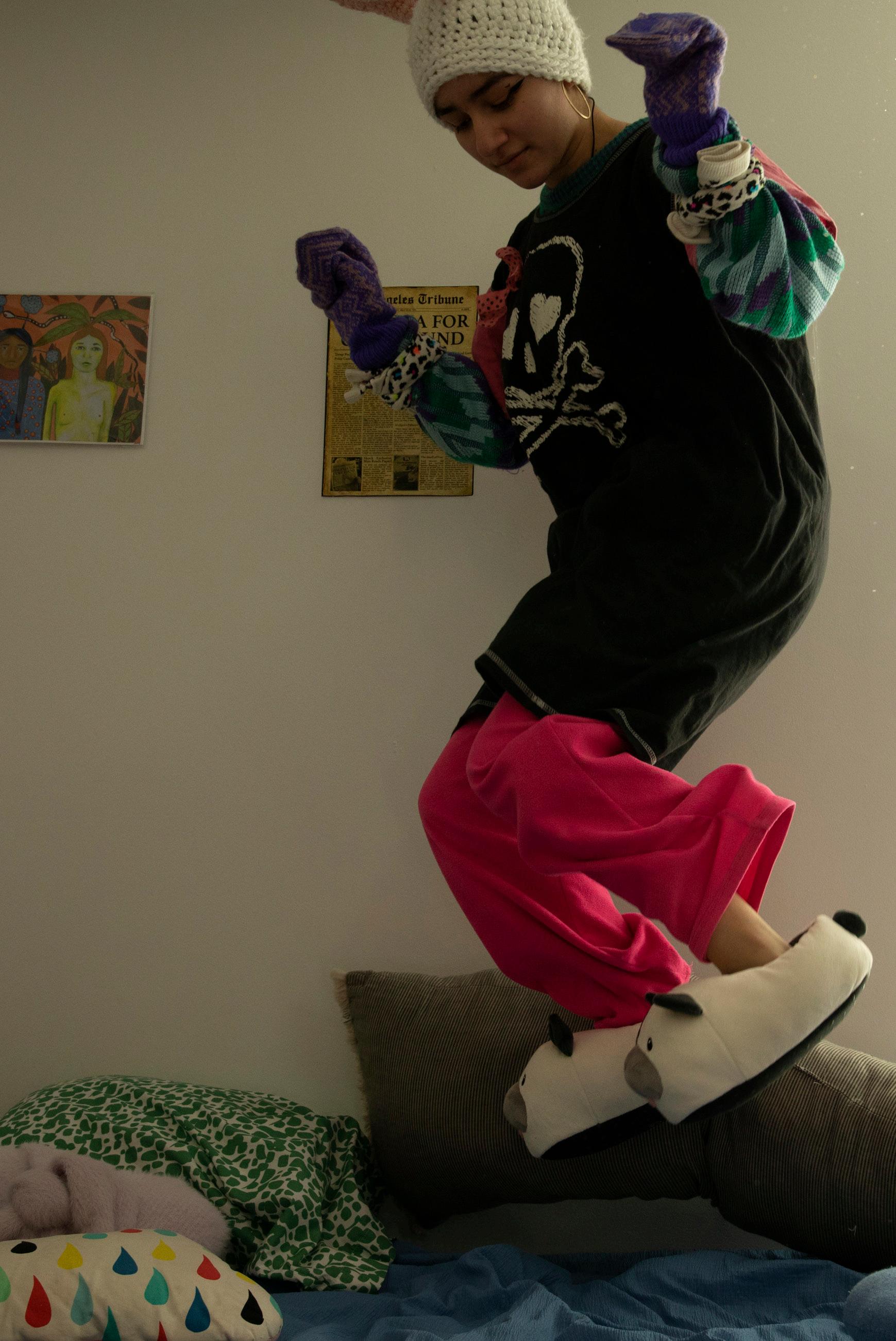
It’s the ethereal feeling of entering a warm house, closing the door to winter’s harsh wind. It’s straightening out a loved one’s scarf as they prepare to go back outside. It’s the small glimpses of humanity that remind us of the goodness we radiate, and the comfort we have the power to bring others.
This edition’s fashion feature explores the different ways we bundle up — whether it’s layering for class in the morning, revisiting cozy childhood clothes, or bringing back the classic pieces of generations past. It is also an ode to the legacies we leave behind in cherished items that once brought us comfort. This shoot is a dedication to the memories of Jay Land and Leslie Goldstein Hager, Jerk grandparents who had funky fashion senses that live on in a few of the following looks.
GAWK 42 JERK 41-52
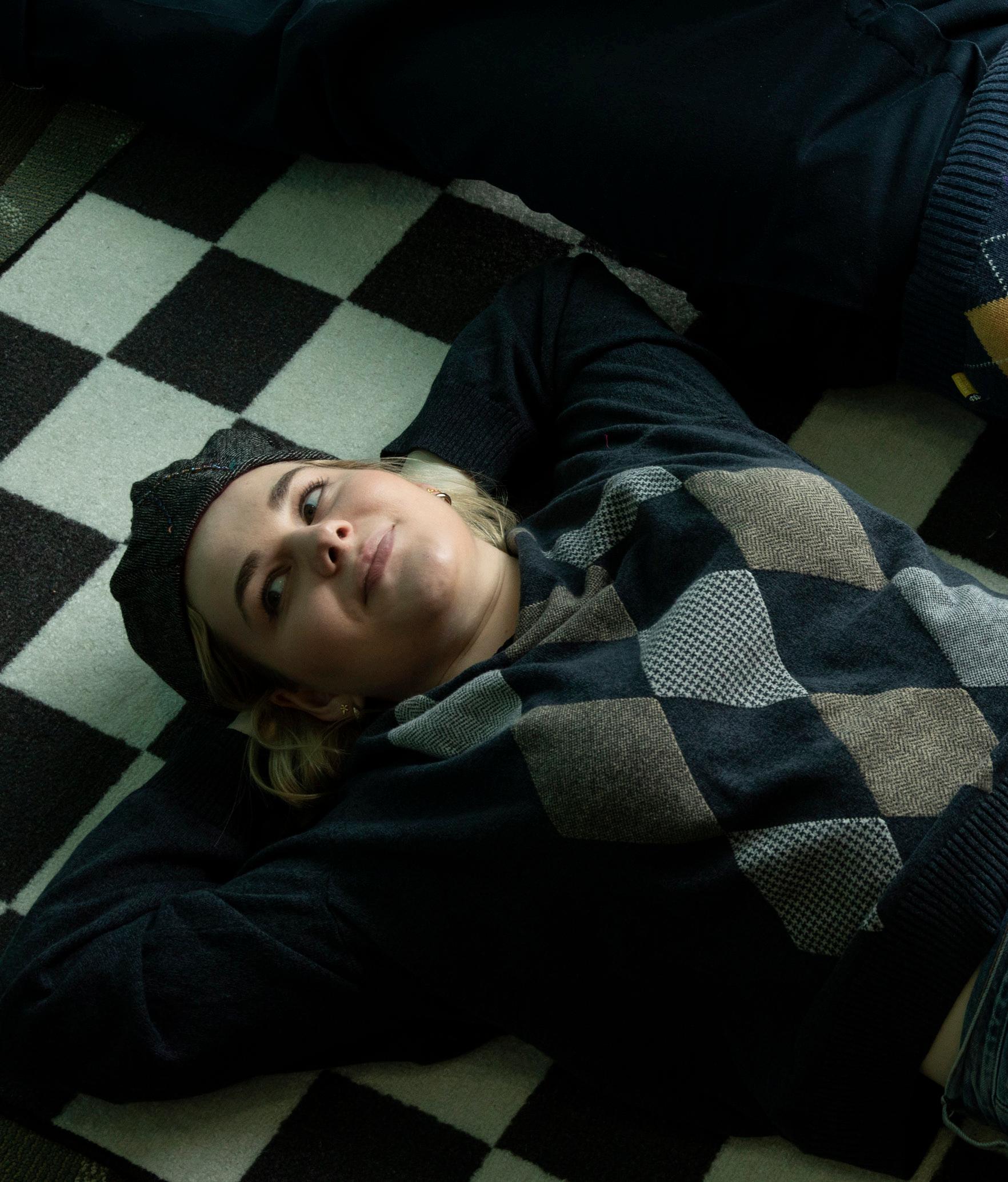
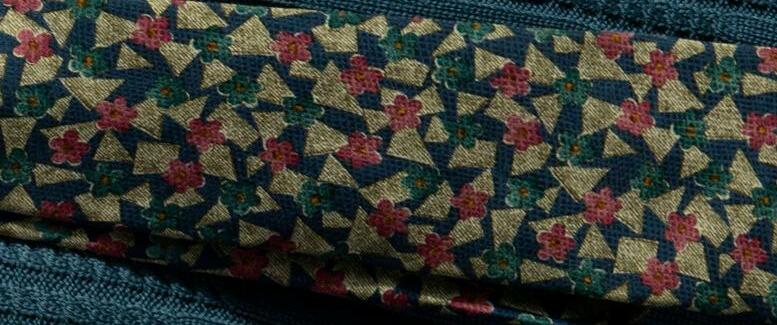
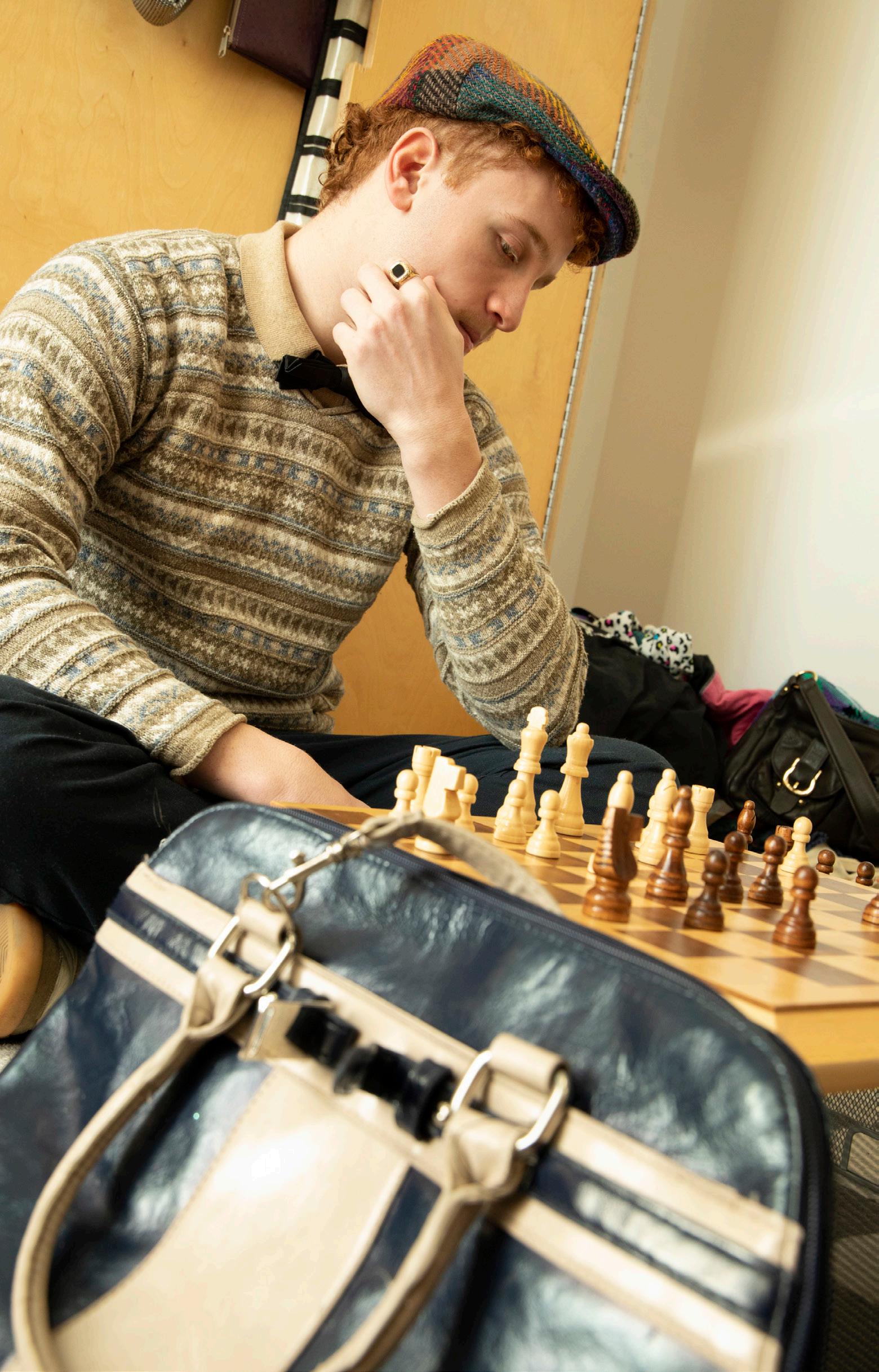
43


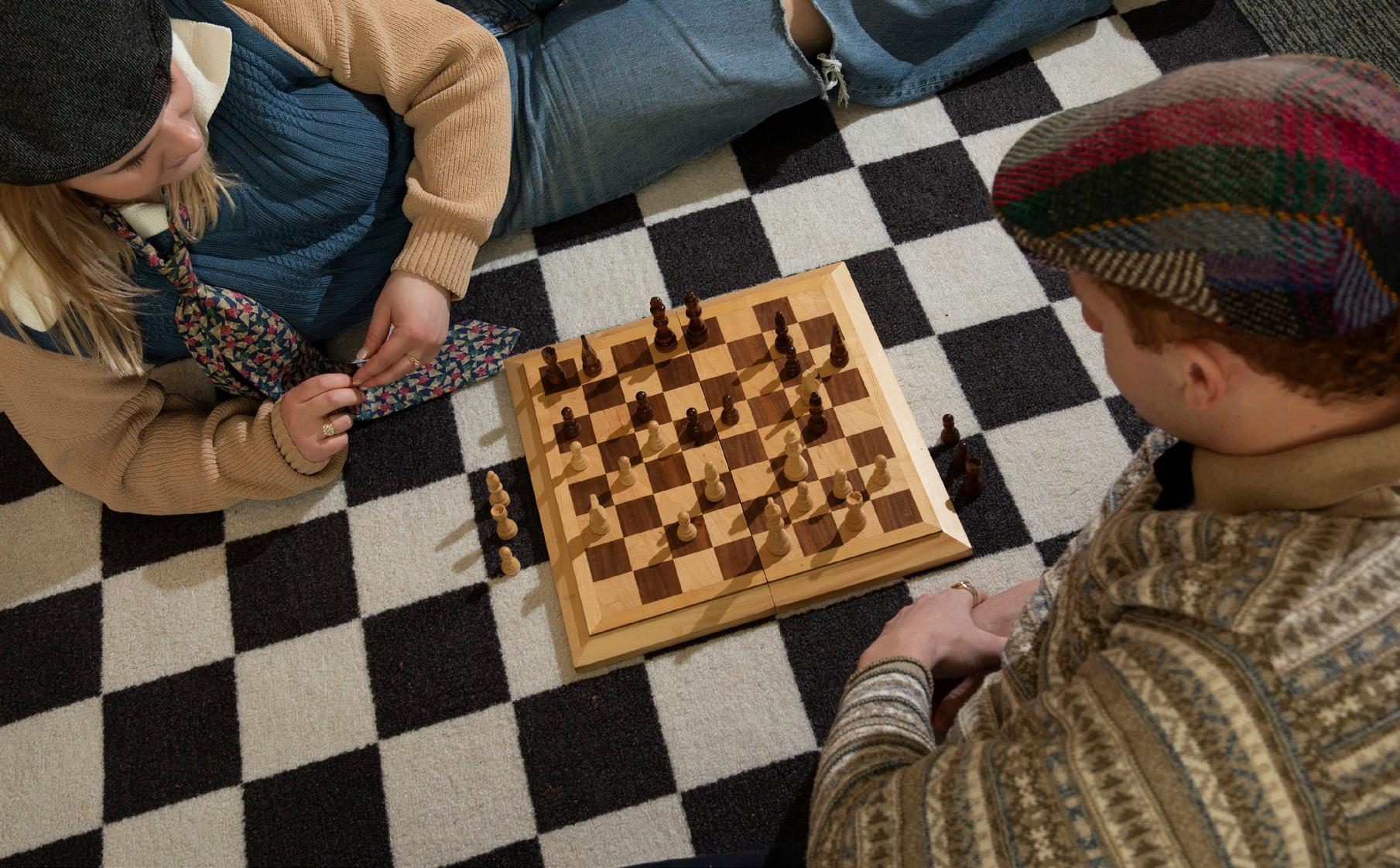
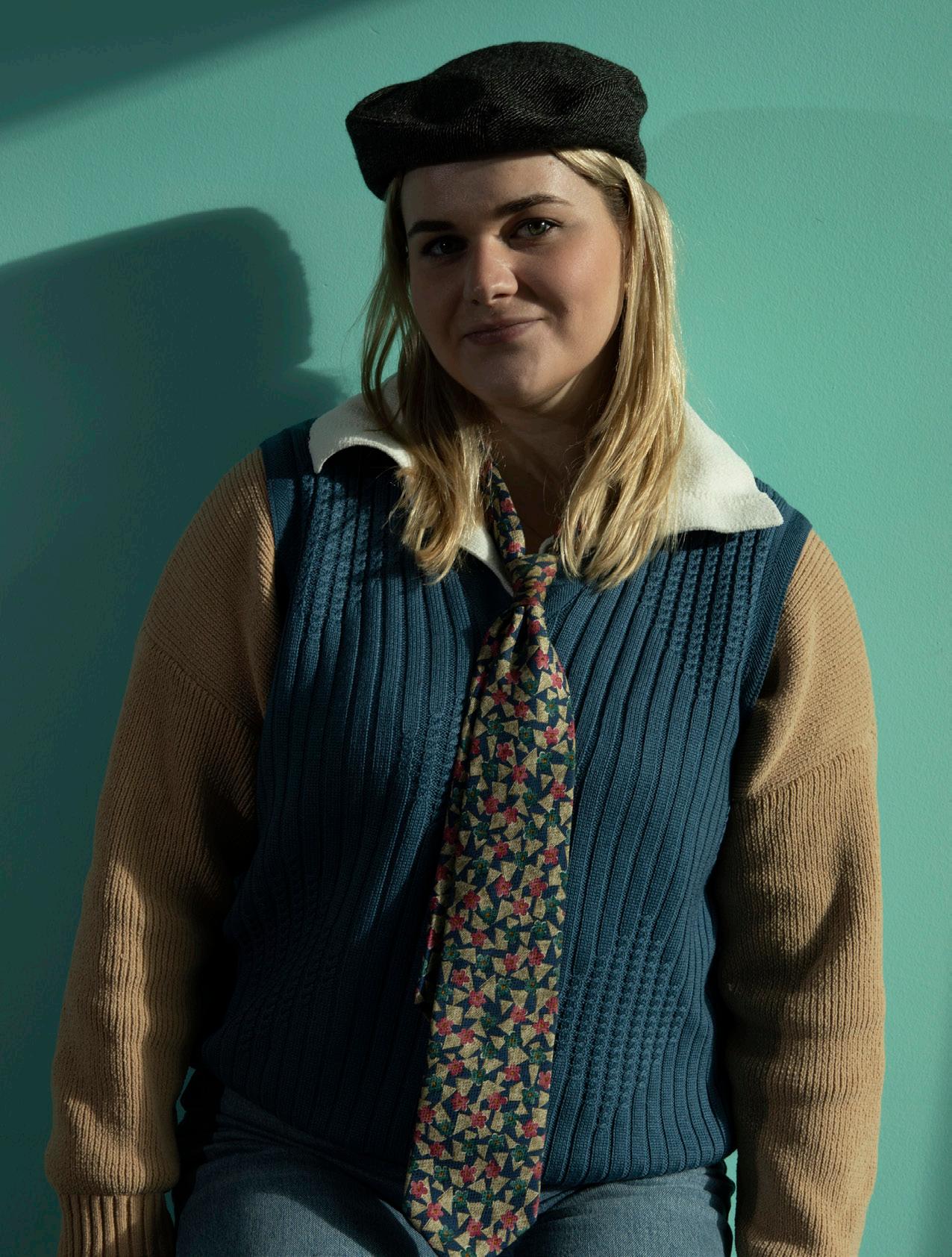
GAWK 44 JERK 41-52
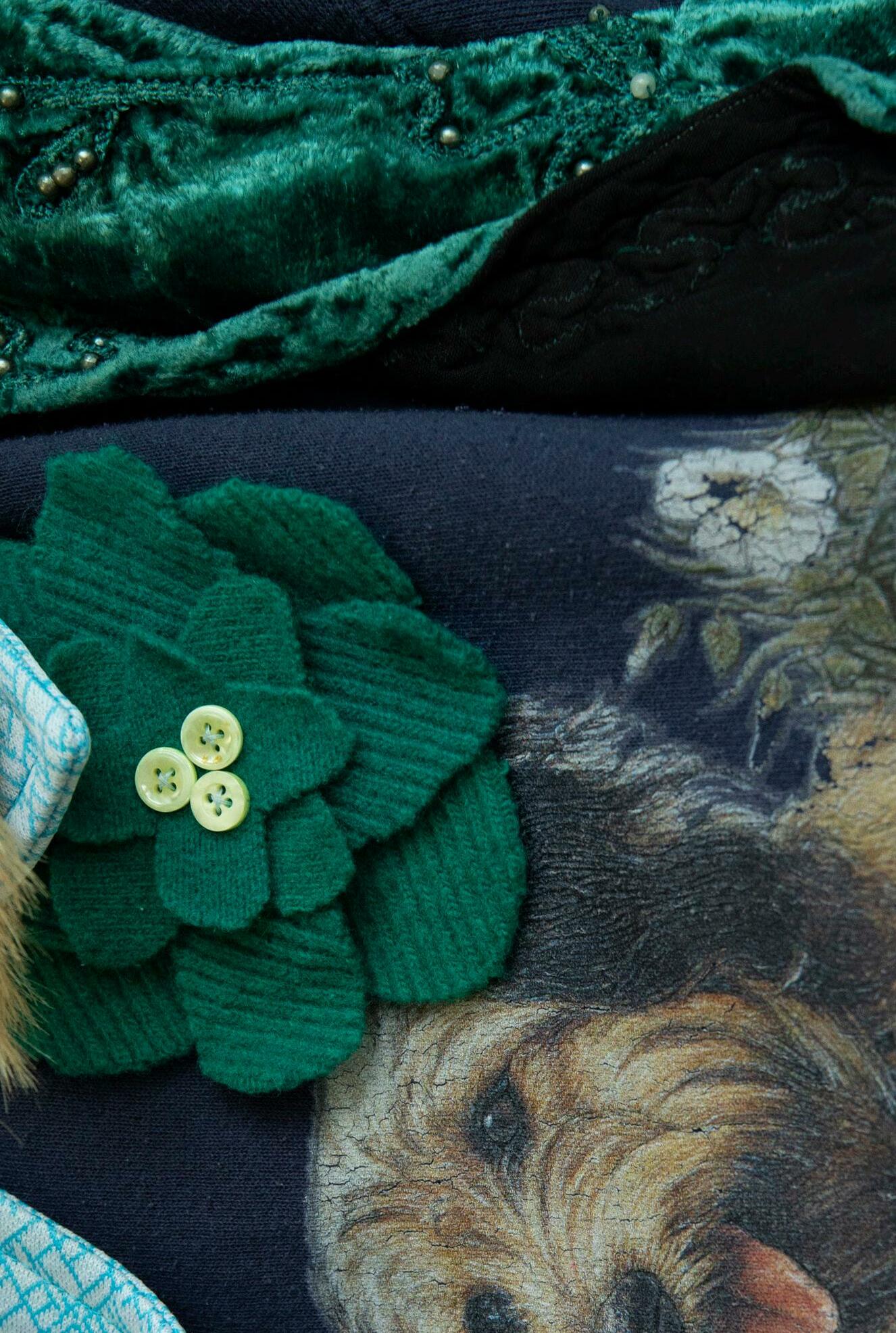
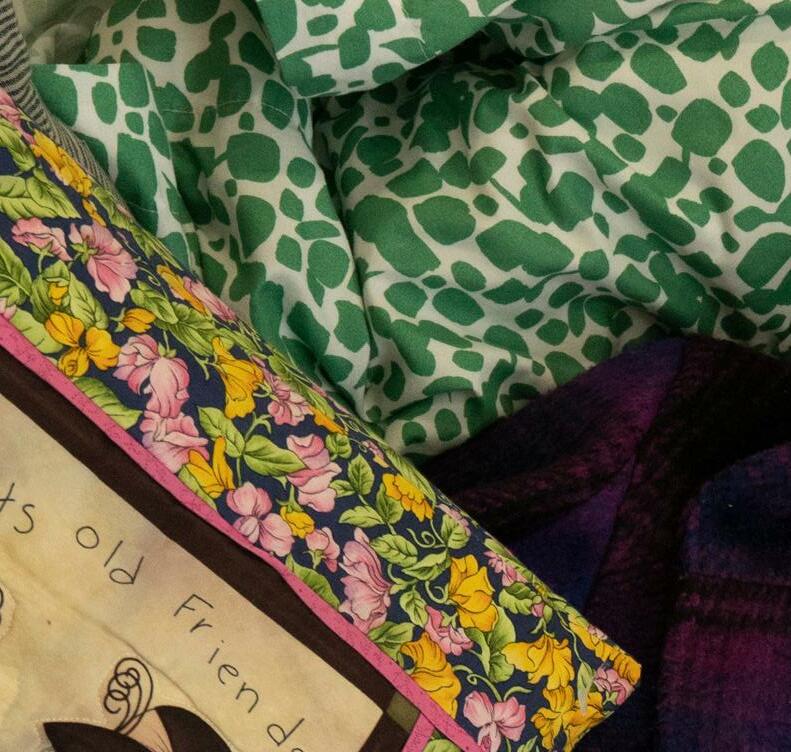
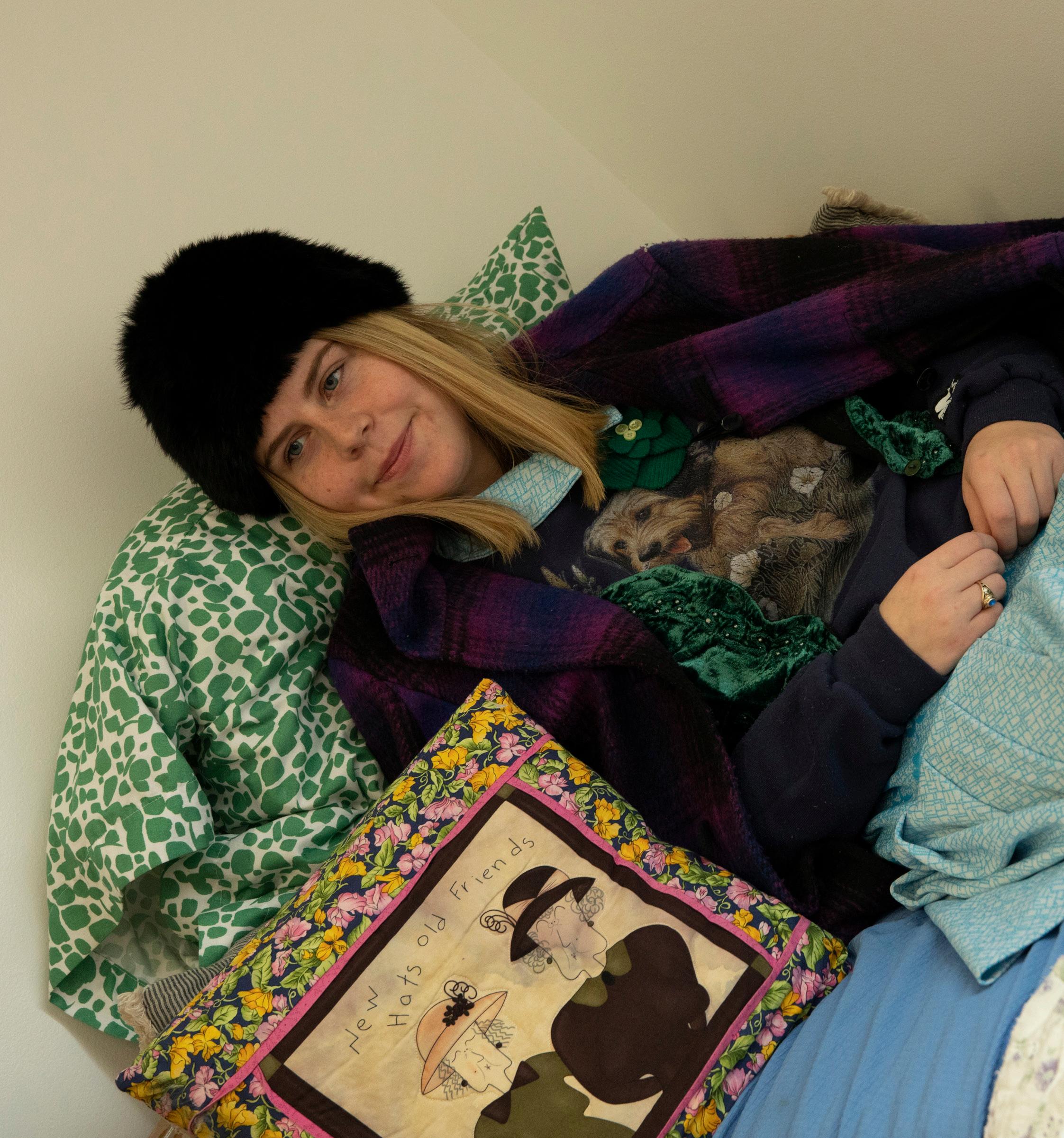
45

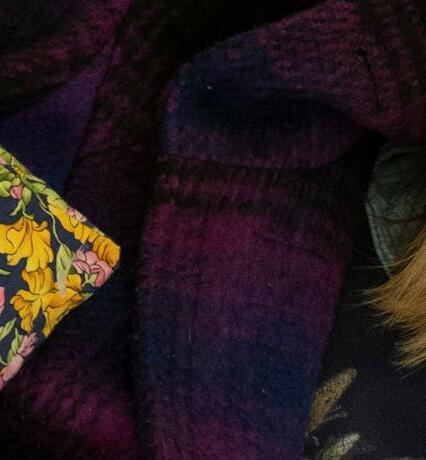
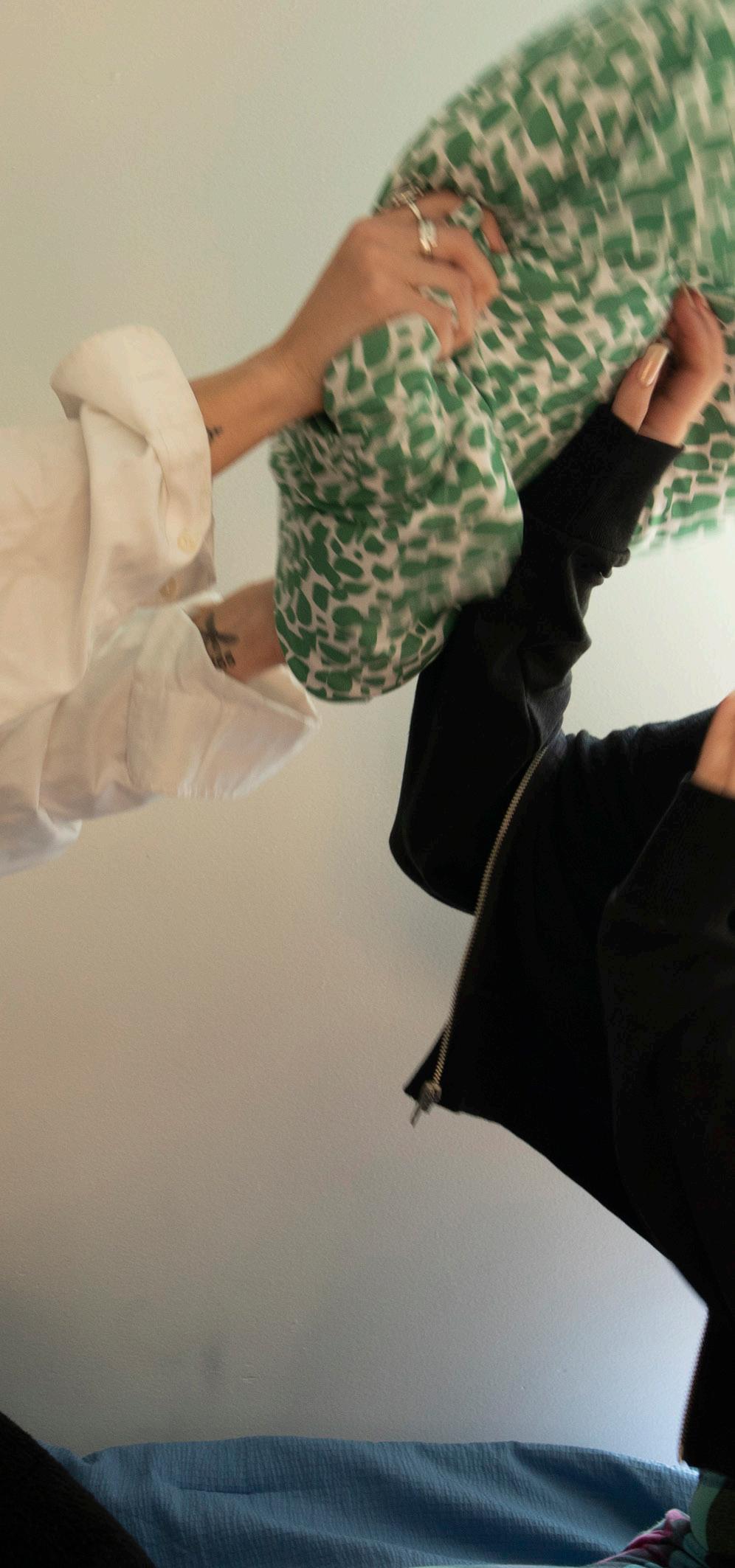
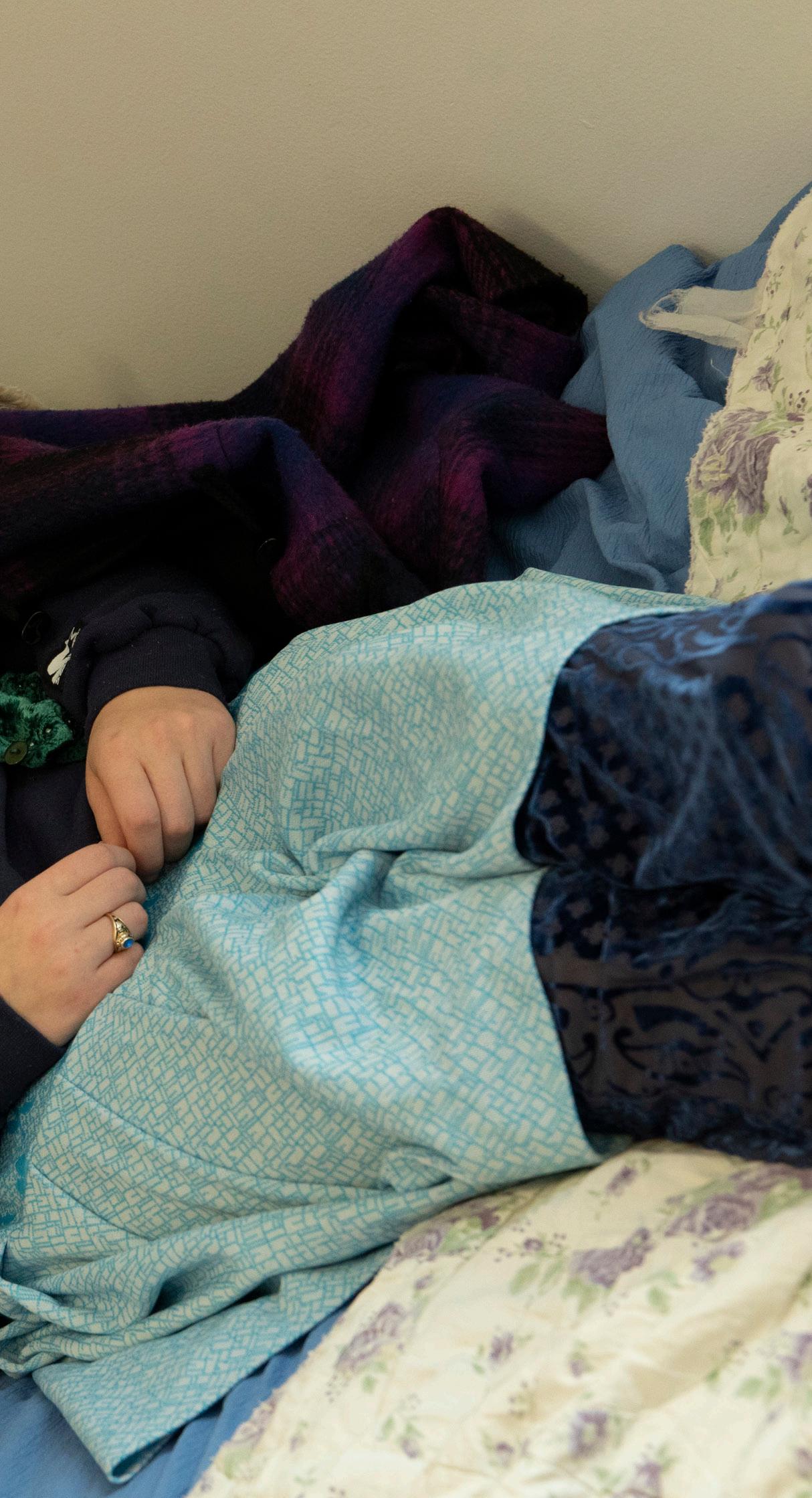
GAWK 46 JERK 41-52

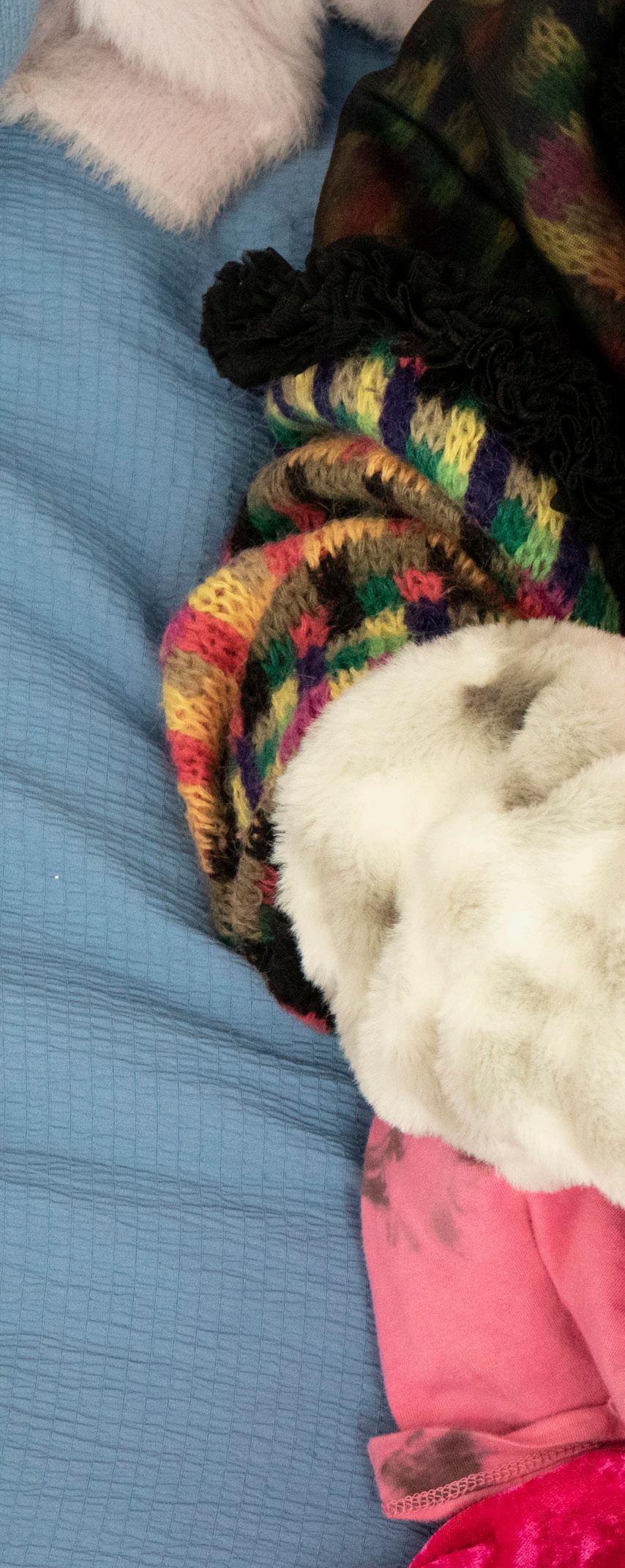
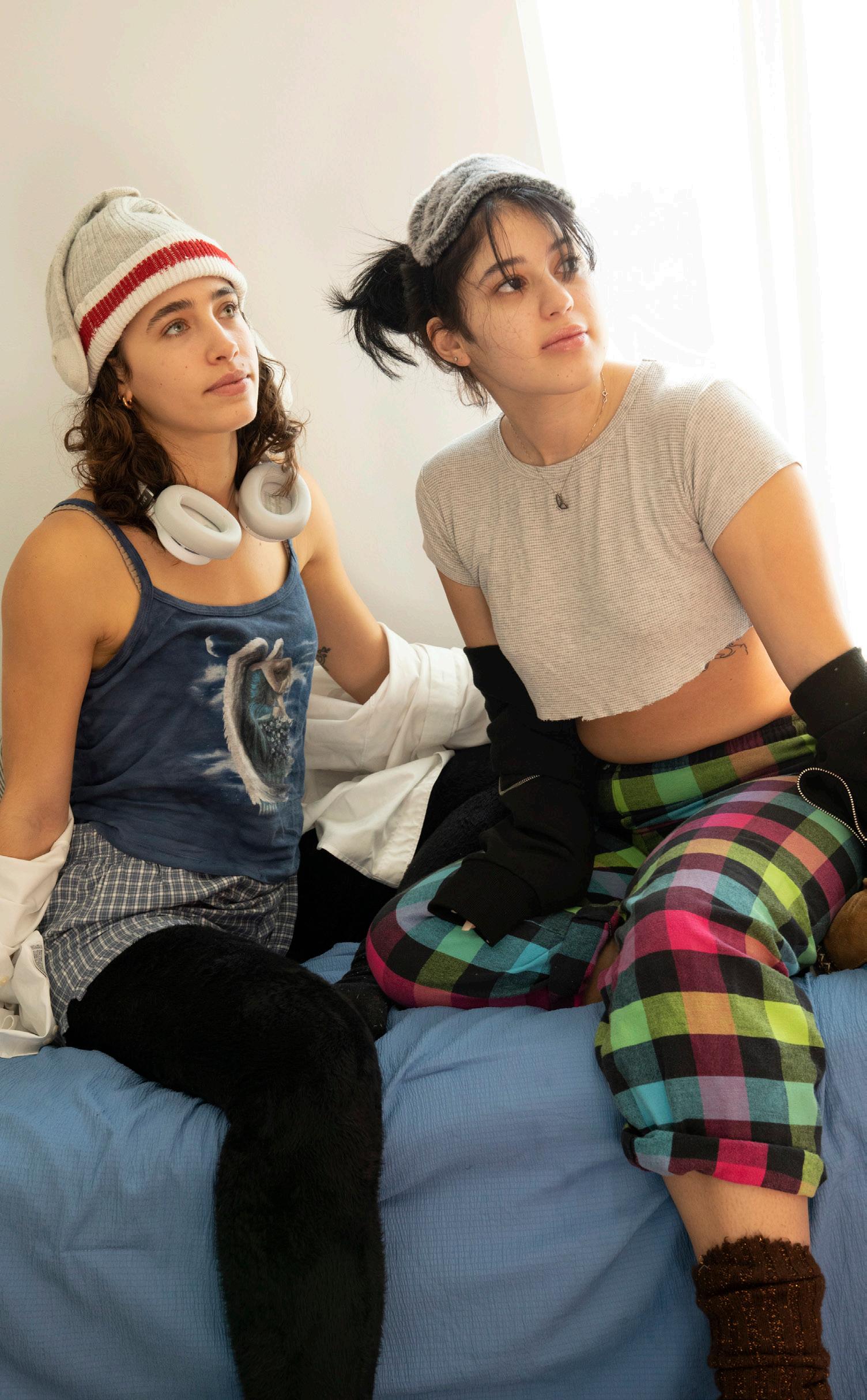
47


GAWK 48 JERK 41-52
DAMSELS IN DISTRESSED
Analyzing the designer-destroyed look.

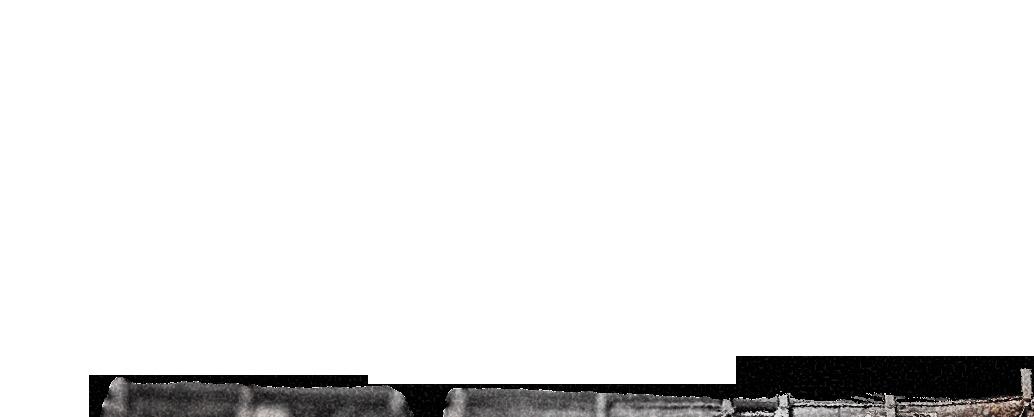 Words by Lily Brooks Graphic by Lang Delapa
Words by Lily Brooks Graphic by Lang Delapa
Picture this. It’s Friday night, and the girlies and pledges across campus are ready to enjoy a night out on the town (a.k.a Harry’s or a frat basement); they slip on their beater sneakers and their designated fracket (frat jacket, colloquially) ready to dance. They are fully aware that they will be stepping in puddles of god-knows-what, and that there is a solid chance their jacket will either be stepped on or stolen. And in a couple weeks or months, when the shoelaces are a muddy brown and their jacket pockets have a hole their Hyde continues to fall through, these damaged goods will be disposed of. Cut to the next day when they hop on Grailed or Depop and search keywords: “vintage distressed clothing.”
There is nothing wrong with having designated clothing meant to get dirty or to want to follow the trend of buying overly beat-up clothes to get that vintage or grunge look. But those jeans that fit you perfectly are begging, balled up in the corner of your closet, for you to sew that button back on. Those sneakers that have served you well this year only need a bath and a good scrub, and you’ll have yourself a Mia Thermopolis makeover.
With the resurgence of the ‘90s aesthetic and the increased usage of reselling websites, people want to emulate the lived-in aesthetic. The goal is to seem like their outfit is just an effortless accumulation of clothes that just happen to look like that, from years of living in and actually wearing them. This style is influenced by deconstructed and distressed clothing that has appeared in runway shows since the ‘80s. Yohji Yamamoto, Martin Margiela, and Rei Kawakubo shook up the fashion industry by defying the conventions of glamor and femininity by designing clothes that were the complete opposite of what was being shown during fashion week at the time.
Fast forward a couple of decades when this anti-fashion philosophy influenced the works of designers like Demna Gvasalia, who is responsible for works like the highly coveted destroyed sneakers, which were selling for almost two grand. The discussion around these designers and their clothing is mostly criticized for mimicking and mocking the wardrobes of those who can’t afford to buy new clothes. It’s a valid take, but it also often neglects the philosophy behind these collections, which are often an artistic statement on overconsumption and beauty standards. But most
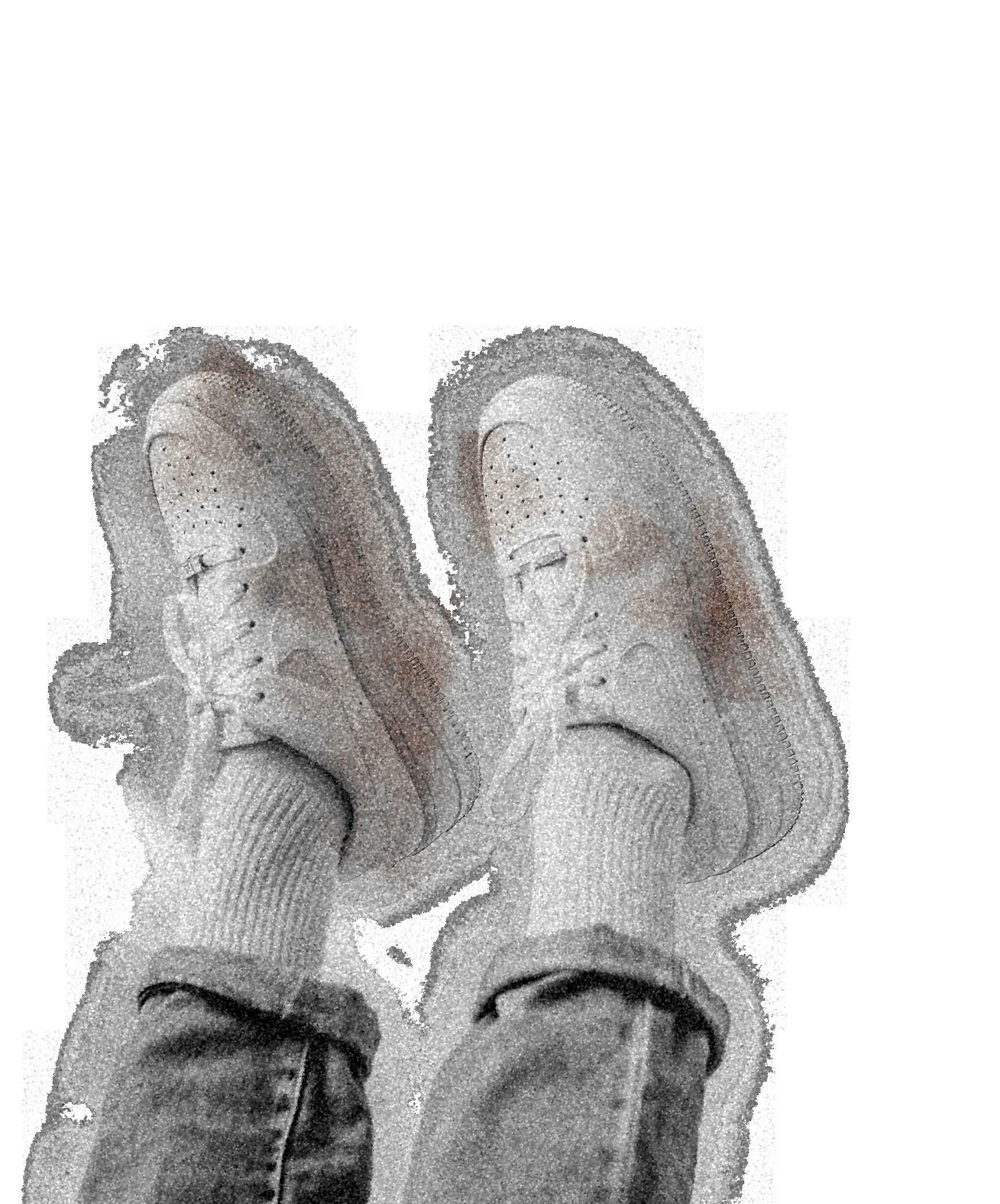
STRIPPED:
49
consumers don’t know or care about the reasoning behind the designer’s ethos. We see something that looks cool and different and wants to emulate that. In turn, overly distressed clothing has become an inverted status signal, to show others that they are up-to-date with what is cool and that they have the resources to participate.

It’s intimidating to build a personal fashion identity, and almost impossible to disengage from the mentality that you are dressing for others to perceive. But there is a way to participate in trends, such as distressed clothing, without overconsumption! Invest in clothing that feels good, bring it to a tailor if it doesn’t fit perfectly, and DIY some patchwork remodeling on your jeans. It’s easier (and cheaper) than looking at your closet every six months and wanting to throw everything out and start fresh. If there is a designer that sparks your interest, look into their motivations and processes of how they construct clothes rather than trying to carbon-copy their looks.
There is a toxic and condescending culture around these methods of wealth communication, but on the bright side, there’s also been a push on social media for people to find their own sensibilities rather than copying aesthetics. Yes, folks, the over-saturation on TikTok and Instagram has actually encouraged people to find their own voice in the sea of content. Maybe, just maybe, our generation thinks it’s better to be recognized for wearing an original and authentic outfit than the flock of Golden Geese that signal you got that nostudent-debt money.
GAWK 50 JERK 41-52
FORM
AND FUNCTION: How to dress like a...
COQUETTE GIRL
Words and Modeling by Naimah Rahman
Photo by JT Hutchinson
With the Tumblr renaissance entering full force, we can say hi to an old trend that apparently dies hard. The Coquette girl is soft and supple. Don’t ask her what’s in her tote bag because it’s just a copy of Lolita . Her wired headphones — because Bluetooth is too basic — are just playing Lana Del Rey (Ultraviolence, of course).
NOT YOUR MOTHERS
PEARLS: In this dying economy the croquette girl will cosplay her jewelry as family heirlooms but let’s be honest, she amazon prime shipped them after seeing a TikTok of someone wearing it.
REPETTO RED SHOES:
Lily-Rose Depp definitely wore better but who cares! Your shrine of her isn’t gong anywhere.
WHITE DRESS: All this white and still no privilege! The coquette girl is innocence at its peak. And what’s purer than white itself, so be sure cover yourself in it!
PIGTAILS: Tap into your inner child will pigtails. Pair the look with your best doe-eyes and the world is yours.

51
THE CULTURAL ROLE OF OUR CLOTHES
Words by Emane Haque Photos by Krystal Zhang and Lily Brooks
Fashion is many things — an art form, a way of self-expression, a class signifier– but fashion, at its core, is a mode of connectivity. Cultural clothing in particular unifies people. It outwardly expresses upbringings, heritage, and belongingness. We wanted to showcase three Syracuse University students representing the fashion of their identities.
Emmy Naw (Wearing a Chi Knyaw Pa Taw): “Every time I put a piece of Karen clothes on my body, I feel connected to my roots, and I feel so proud. What makes it more special is that I know every piece of Karen clothing is handmade with care and love. Karen fashion to me, means showing off our beautiful clothing that our ancestors have passed on to us. Yes, Karen fashion has become modern, however, every stitch and bead is traced back to our ancestors.”
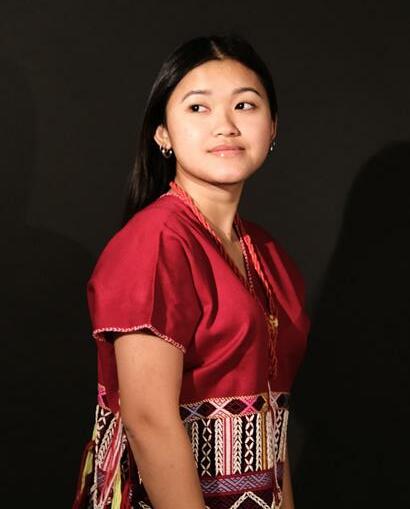
Tulsi Patel (Wearing a Indo-Western Top and Pallazo Pants): “Usually, in South Asian culture, we wear these clothes during our holidays, such as Navratri and Diwali. Whenever I get a chance to wear my cultural clothes, it makes me feel more connected to my community. The symbolism for Indian fashion usually comes from cultural heritage, elegance, and colorfulness. By showing off my culture, I’m hopefully able to help create a comfortable space for people to express themselves and be proud of their heritage.”

Malaika Wanjiku (Wearing a Kitenge dress): “Being so far away from Kenya gets hard, so when I put on a Kitenge, it connects me to my home and my people. It’s more than just fabric, but is a symbol of comfort and ancestry. Our dresses, our beads, and our scarves serve as reminders of where we come from.”

GAWK JERK 52 3–21 CLOSET CASE:
NOISE 52 JERK 53-66
THE NEW VINTAGE
Pop-ups power Syracuse’s second-hand scene.
Words by Zoe Glasser Photos by Maya Lockwood
If the sound of vinyl, the color palette of November, and the scent of coffee and elderberry were a place, they’d be the bottom floor of Wildflowers Armory in downtown Syracuse. Walls are peppered with ornate mirrors, paintings, and prints of illustrations by local artists. Plush chairs sit inside the varying storefronts, separated from the atrium and each other by plexiglass walls. Racks of retro clothes stand guard outside their shops, ready to be leafed through by customers. Wildflowers, which opened in 2019, is home to a host of different independent vendors that sell everything from candles to purses to hot sauce. But beyond these goods (which are indeed very good — check out our feature on Nectar Espresso Bar and Vintages from our October issue!), the building is a hub for something larger: pop-ups for the greater Syracuse area vintage community. You heard us right — the Syracuse area has an eclectic community of vintage sellers, collectors, and dealers that gather and collaborate through pop-up events and markets. Prior to the opening of storefronts like Wildflowers and Salt City Market, these pop-ups served as the primary way that vintage sellers could come together and sell their goods, sort of like a flea market or a yard sale. Now, the sellers continue the tradition of pop-ups on a larger scale thanks to their indoor space and increasing reach in the community.
Michael John Heagerty, a co-owner of Wildflowers and owner of McCarthy Mercantile, has been hosting these pop-ups since 2016. Infinite Pop was his first project, and certainly bears a striking resemblance to its younger sister Wildflowers — a collection of local small businesses gathered to promote their goods and network with each other. From there, he perfected his pop-up formula and began applying it to collaborations with local vendors.
“[Infinite Pop] was just me and a Square reader on my phone, plugging in between transactions, and going live [on social media],” Heagerty said. “It was kind of crazy, but it was amazing. Over the years, we’ve actually curated and done a bunch of different events, like big outdoor craft festivals. But once we got [McCarthy] Mercantile, we’ve made the center bay our trade show format to enhance the shopping experience.”
Since then, Heagerty has worked with Nectar Espresso Bar, Just Bros Vintage, and The Cherry Pit, all of which have space in Wildflowers, to host pop-up events. In June, he partnered with Nectar to hold an event called “Fatties and Baddies,” which arose out of a lack of options for vintage shoppers in bigger bodies. The event provided space for plus-sized vendors while helping customers find one-of-a-kind clothes that fit perfectly.
“Mercantile puts on a lot of collaborative events. Them, myself, and a small team put on large-scale arts and crafts shows. It’s not a nickname that I exactly wear around, but I am the self-proclaimed Prince of Pop-Ups of Central New York,” said Heagerty. “All joking aside, I can’t even begin to explain to you how many we’ve done in the past three or four years. Wildflowers came up during the pandemic, so we carved our own path, and part of that meant having these pop-up opportunities.”
For businesses like The Cherry Pit, which specializes in vintage clothing and accessories, these pop-ups were nothing short of necessary. Before the storefront, each of the three co-owners, all of whom are vintage sellers on their own, attended pop-ups individually. This helped each seller build up her own business until The Cherry Pit got its own storefront in Wildflowers. Like McCarthy Mercantile, it continues to table at popups around Syracuse, including at Salt City Market, because the owners enjoy the sense of community.
53
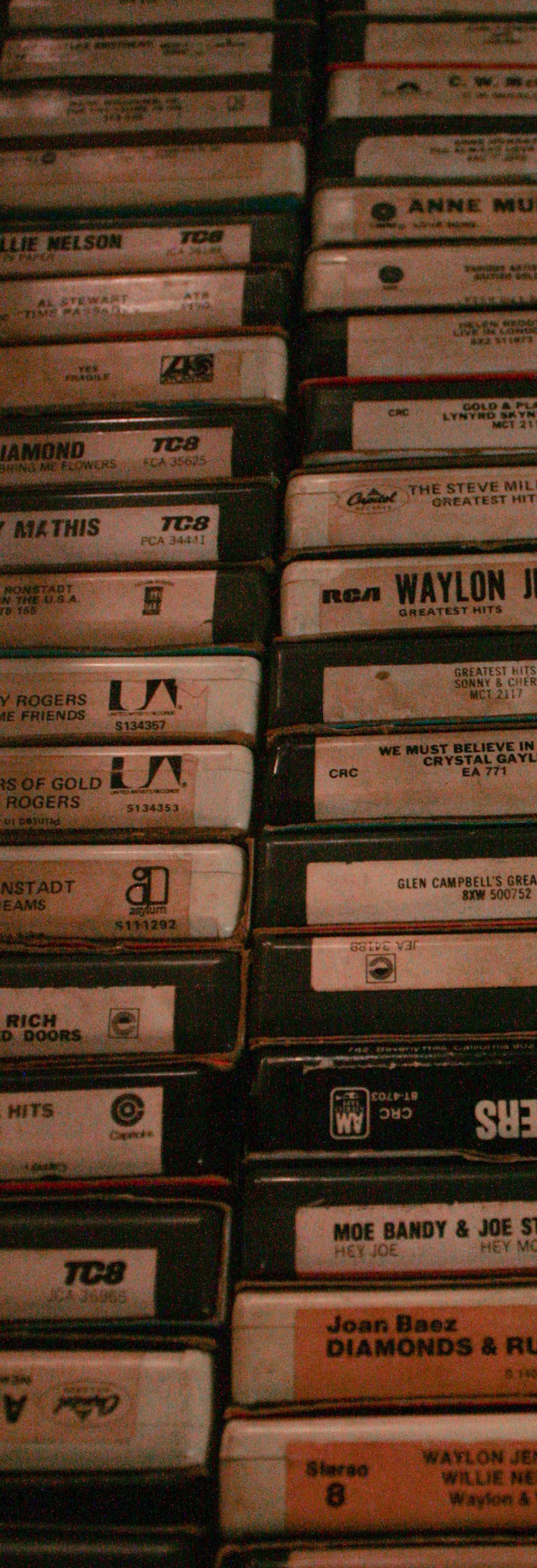

NOISE 54 JERK 53-66
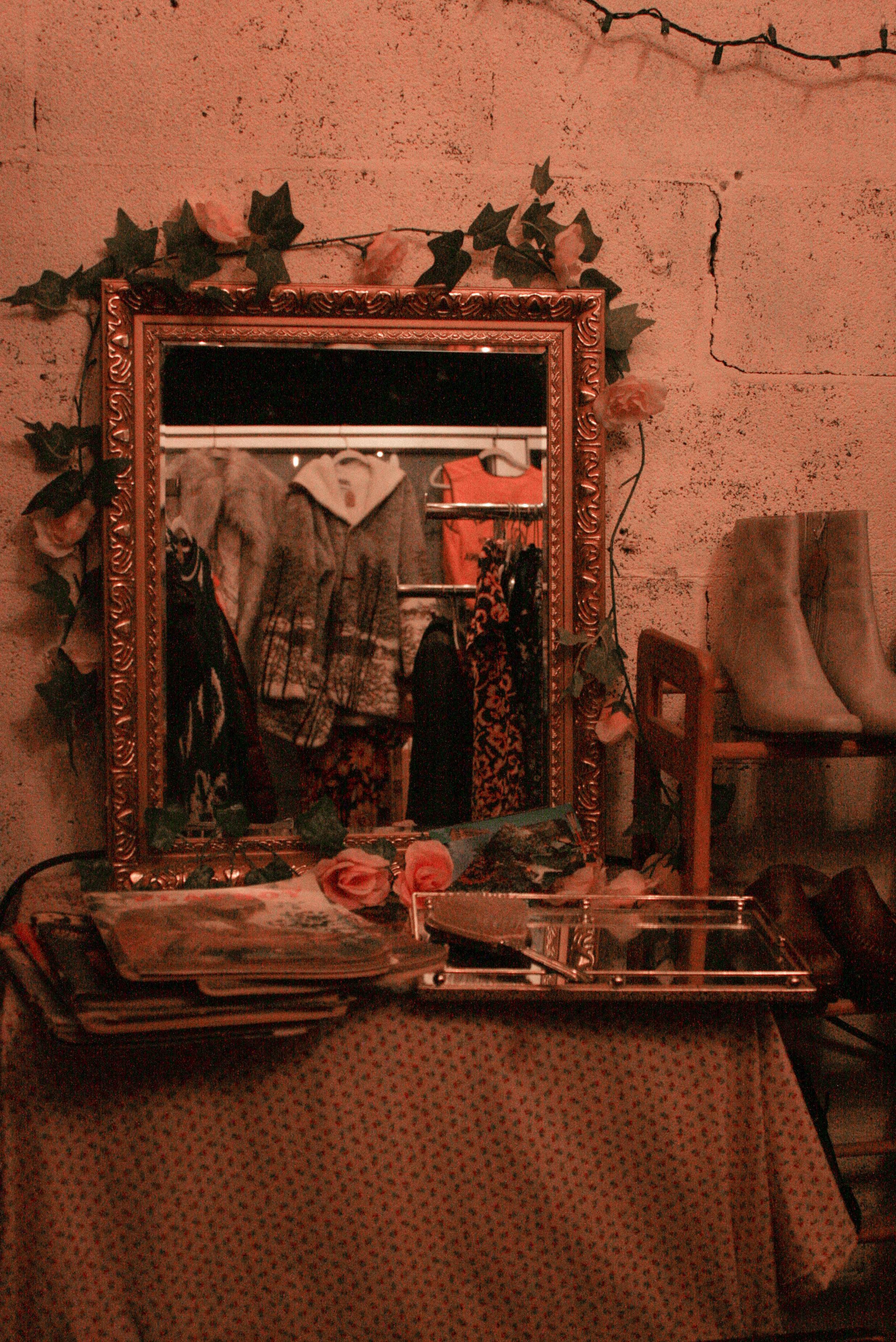
55
“We mostly do pop-ups because that’s where everyone in the community that does thrifting or handmade stuff gets together,” said Abigail Minicozzi, a co-owner of The Cherry Pit and an SU junior. “We all know each other and it’s just a good place for everyone.”
Outside of Wildflowers, there are a number of other vendors that hold vintage pop-ups and events. The BeatNook, an antique shop also located downtown, has held a handful of markets at the Westcott Theater and at Sharkey’s Entertainment Center in Liverpool. It recently hosted Misfits Market, which ran at the Westcott Theater during the Westcott Cultural Fair in September, and which also received plenty of foot traffic. It too had a wide variety of vendors at these pop-ups, including those who were selling handmade jewelry, candles and soaps, vintage furniture, and used records. BeatNook events have also hosted DJs, performers, and even tarot readers at these pop-ups. The BeatNook differentiates itself by curating its popups by hand; once they’ve decided on a theme for the event, they reach out to potential vendors instead of the vendors applying to them.
To Heather Binyon, SU alum and co-owner of The BeatNook, these markets foster a creative space for local artists while creating bonds between vintage sellers and creators. She says that the community and culture surrounding vintage goods are unique to Syracuse, which also draws traffic to these events.
“You’d think the vintage community would be competitive, but it’s actually not here,” said Binyon. “It’s really supportive. We call each other out to do like house cleanouts and things like that. It is a really welcoming community. It’s a lot of women and LGBTQ+ people, and it’s all privately smallowned businesses.”
This sense of unity has helped attract the broader Syracuse community to these events, according to Binyon, in addition to trends in fashion and an increased desire to shop sustainably.
“I think that it’s a really interesting time right now because people are really seeking out sustainability. They’re seeking out individual goods, not mass-marketed things,” she said. “People are shying away from big corporations, and as it’s silly as it seems, these public markets really are part of that. You’re supporting people that are supporting
their own families, people that have left corporate jobs to do this.”
But wait, there’s more! Because these pop-ups have drawn growing numbers recently — Heagerty said that about 2000 people attended the McCarthy Mercantile x Nectar Espresso Bar “Fatties and Baddies” event– he was inspired to reach out to Syracuse University for direct collaboration. After negotiating with the SU Campus Store Team, Heagerty hosted a two-week-long pop-up in the Schine Student Center from Nov. 8-11 and 15-18. Each shop in Wildflowers worked with Heagerty to curate their items.
As these pop-ups look to the future, the jury is still out on exactly how much expansion individual businesses want to do. McCarthy Mercantile currently has plans for a pop-up at the Cornell University Campus Store in the spring; an opportunity that came about because the campus seller at Cornell had heard about the pop-up in Schine. The Cherry Pit routinely attends pop-ups at Salt City Market and plans to continue to do so. It has also attended a pop-up in Rochester, although Minicozzi says The Cherry Pit prefers to stay in Syracuse. The BeatNook plans to hold more popups at Westcott Theatre and Sharkey’s, especially as it approaches the one-year anniversary of its very first one.
Beyond physical plans, Binyon looks forward to the growth of appreciation and community in the vintage scene.
“It’s a really great time to see more women coming into this field, see people of color coming into this field who were underrepresented for a long time. I think it lends to having new traditions made with buying things that are going to last, that have meaning to you and that you can eventually pass down. So I think in turn, sometimes we’re creating the new vintage by having these things because I look at things and wonder what’s going to become vintage — what’s going to be cool in 30 years?”
NOISE 56 JERK 53-66
Dark Academia
Words by Gray Reed Art by Kodah Thompson
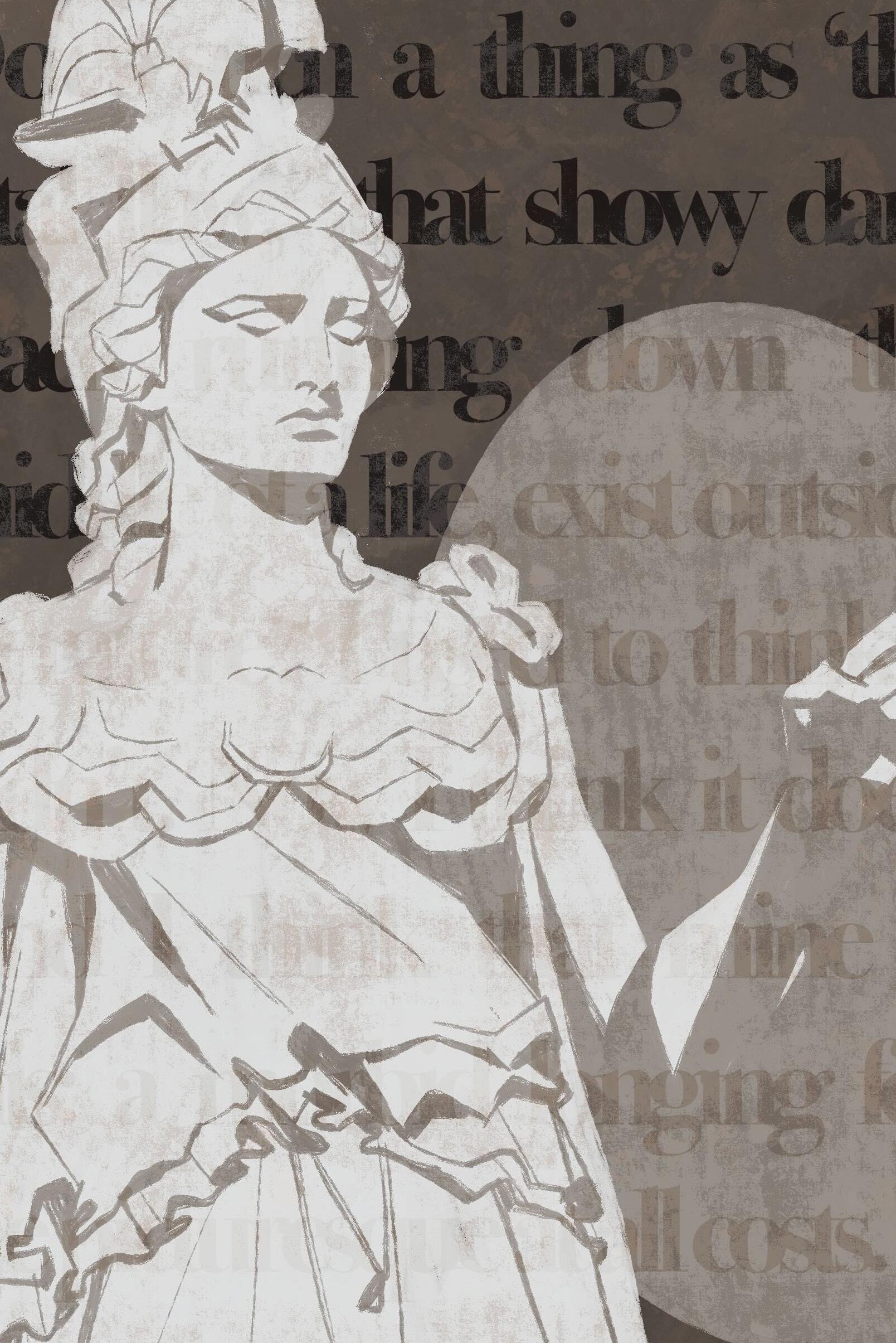 Jerk deconstructs tweed-filled aesthetics.
Jerk deconstructs tweed-filled aesthetics.
57
When I open TikTok, my feed is cluttered with videos explaining how to style blazers and various forms of “study with me” content. The same goes for my Instagram feed. And YouTube. Algorithms continue to push academic content in my face regardless of where I go, and I don’t seem to mind. But how did we get here? Why do we as a generation glamorize intellectualism above all other lifestyles?
Found in films such as Dead Poets Society and shows such as Gilmore Girls, decades of content have centered around the idea of romanticizing academic culture. But the current interest in the lifestyle, particularly online, can be traced at least in part to the mid-2010s on platforms such as Tumblr. Users shared photos of their favorite classic novels and posted videos of academic fashion — neutraltoned sweater vests and turtlenecks. Over the years the phenomenon spread to Instagram and Pinterest, where users curated mood boards of their favorite characters from novels such as Jane Eyre.
Yet the question remains why intellectualism as an aesthetic grew in popularity in the first place. Sure, it is pleasing to the eye and mind, but the same could be said for other aesthetics like cottagecore and indiecore. Charisse L’Pree, a professor of communications at SU who specializes in how the media impacts our understanding of ourselves, believes the rise in popularity of the intellectualist lifestyle can be partially attributed to the concept of “grind culture” and desire to be viewed as a hard worker by your peers.
“We have this real desire to show that we’re working harder than everyone else while simultaneously posting about how hard we’re working instead of working,” L’Pree said. “I’m forced to question, do we like that or are we liking it because we want people to like us?”
Grind culture celebrates the idea of pushing yourself to ensure you are better off than everyone around you. When you consider the logistics, this is clearly unhealthy. “We don’t want them to sound or believe they’re smarter than us,” said L’Pree.
This sheds light on the negative side of romanticizing an academic-core lifestyle. Does the pressure to be perceived as smarter than everyone else have lasting effects on one’s mental health? In many cases, it was found that intellectualism
can promote the idea of the over-worker, which in reality can lead to excessive burnout and lack of sleep, among other things. The concept also promotes further unhealthy habits, such as an unhealthy consumption of caffeine to ensure individuals have the energy to continue their studies or pull all-nighters.
This mindset can be likened to capitalism. In capitalism, individuals are encouraged to compete to be on top of the economy. But in recent years, the problems that come with capitalism have come to light — with systematic barriers preventing individuals from having the same advantages as their competitors. Turning back to grind culture in academia, one could argue the same concept prevails with regard to race and socioeconomic status.
For many, intellectualism is inaccessible. The aesthetic is incredibly Eurocentric — with most inspirations for the aesthetic being white. There is little to no diversity, with a large portion of intellectualism being inspired by ancient Greece and Rome, or modern-day countries in Europe.
The aesthetic can also be elitist and financially exclusive. Characters celebrated by intellectual aesthetics often attend private schools and own expensive clothes. To achieve this lifestyle, you probably have to have money. It promotes the idea that to be seen as successful and intelligent, you need to have the finances to back it all up, which unfortunately is not possible for everyone.
If intellectualism feeds into a problematic form of grind culture, lacks diversity, and glorifies financial stability, how can it be improved? One step could be diversifying media that glamorizes the aesthetic academia. Hire more people of color for academic content, show characters from differing socioeconomic statuses succeeding in their studies, and end the glorification of harming oneself for the benefit of their social image.
It is safe to assume the concept of glorifying intellectualism will not die off soon — it is quite literally plastered across the internet. However, we can change our mindset into how we approach the lifestyle, and hopefully in doing so will make it more inclusive and accessible to all who wish to partake in it.
NOISE 58 JERK 53-66
PRESSURES OF ACADEMIC CULTURE
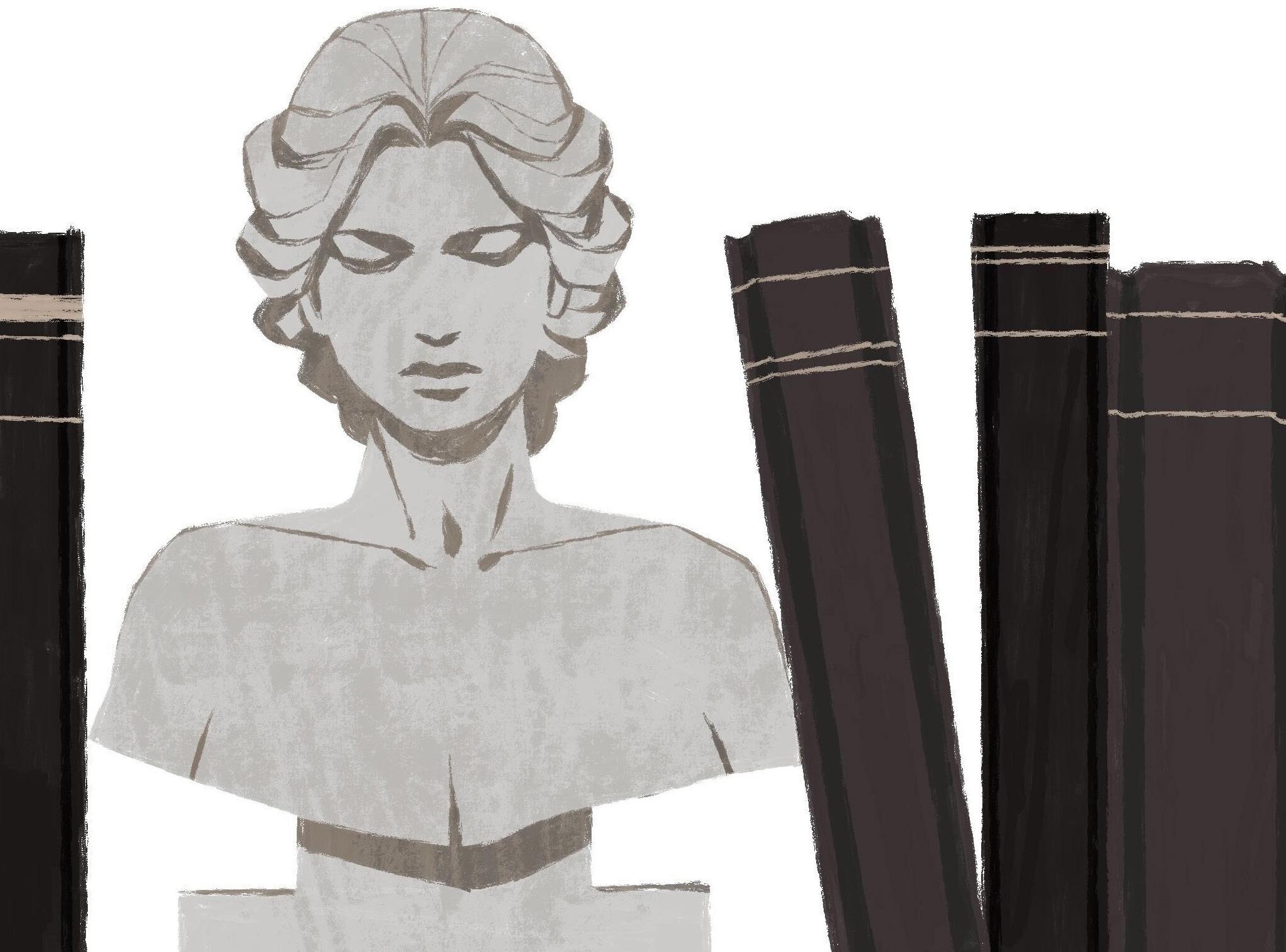
The hamster wheel of grade-driven validation.
Words by Ellie Chapman Art by Kodah Thompson
As an institution, a community, and a business, Syracuse University prominently displays its prestige as a place for higher learning by way of a well-crafted exterior. Its emphasis on productivity and performance can be seen in its winding, bustling pathways, its neatly manicured lawns, and its ivy-covered, charmingly mismatched bevy of buildings (1960s brutalism mixed with classical revival is an interesting architectural choice). As a current senior undergraduate student teetering on the precipice of commencement and well on her way toward a quarter-life crisis, I have become
intimately familiar with this university’s mottos, its hypocrisies, its beauties, and its dining hall’s abysmal selection of breakfast cereals. I can, at last, comprehend the myriad complexities of the MySlice web-browsing experience, can speedwalk from Life Sci to Falk with only two puffs of my inhaler in between classes, and can easily identify the millennial university administrators from the rest of us plebeian students, with their overly tailored, bright suits and more fervent wills to live.
I feel like I can stare into the face of this campus and its accompanying student body with the sort of understanding that only comes from undergoing
59
will be both demanding and yet bewilderingly uncaring. My academic experience has been a walking contradiction from my freshman year until now, simultaneously a challenge I don’t want to let defeat me and a ceaseless taunt that I do my best to ignore.
I think of my deadlines that always pile up in October like clockwork, and the anxiety burning a hole in my chest from not getting enough sleep at night. Despite the innumerable opportunities I have been afforded through my status as a student here, despite everything that I have been given and have tried to take advantage of, there has always still been a sense of dissatisfaction prodding at me; a compulsion to do more, to sign up for that opportunity, to respond quicker to emails, to appear more productive at the library, to look like more of a student. As if I have merely been pretending this whole time, with my heavy backpack and my favorite true crime podcast blaring in my ears.
There’s a spirit of comparison and competition that pervades this community, in a way that’s so constant it almost feels comfortable. The subdued yet busy mornings as campus wakes up, the overflowing lines outside coffee shops, and the currents of people zipping between buildings
every half-hour, have always served as bittersweet emblems of student life. Maybe it’s because when I think of these routines that turn the cogs on the over-priced wheel that is this university, all I can do is picture how my participation in the productivity of this school is tinged with the smell of dry shampoo from not having enough time to shower or the sound of a grumbling stomach in a silent classroom from not having enough time to eat.
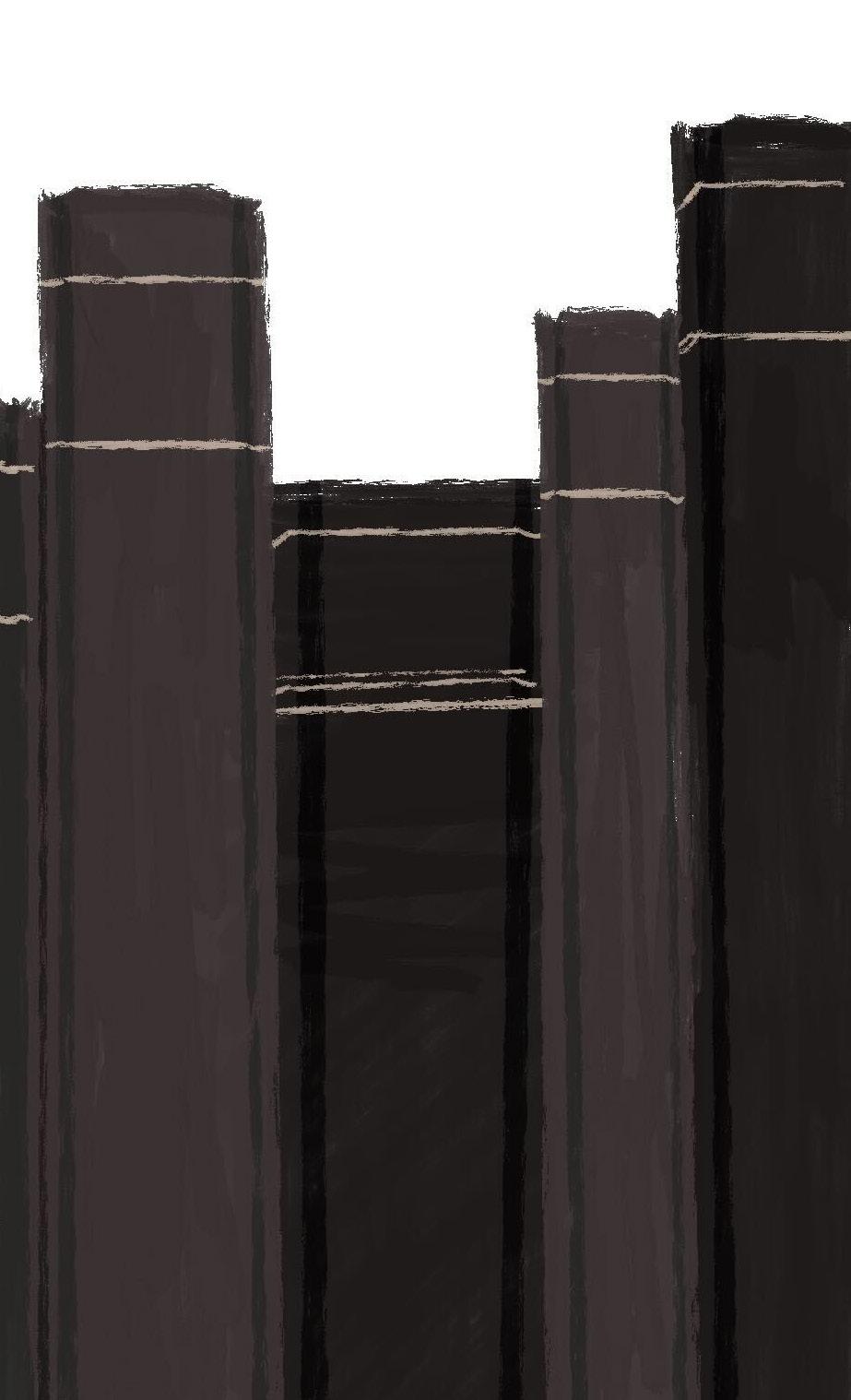
Even as a senior, when I’m supposed to have solid job references and unflappable conviction, my strides back and forth across this university, my schedule made of snoozed alarms and missed office hours, feel so fragile at times. The routes of others, anonymous faces who pass by me on the Einhorn Family Walk, always seem more important than mine, despite the fact that I know exactly what I’m meant to do here and where I need to be in order to become successful.
These doubts, born from habitual coffee consumption and a flair for the dramatic attained from some English romantic literature classes, often plague me with tempting, piercing self-comparison.
But there are other times when I’ll catch myself in a classroom of other people my age, students who range from tired to annoyingly alert, with their shoes untied or feet shoved into slippers, typing away at laptops or staring down at their phones nestled not-so-subtly in laps. And I’ll picture their days before this class, this collective learning that we find ourselves thrust into together. I picture them getting ready for their days, arming themselves with homemade matcha lattes and chunky headphones, worn puffy jackets. I imagine them looking into mirrors to check themselves quickly before they leave their gray-walled apartments, their rambling Livingston houses, and their shared kitchens with maybe a few dishes in the sink.
And maybe there’s something endearing to be found in the unspoken, more simple routines that we share without a word; our solo microwave dinners, our spilled yogurts, our brief moments of self-doubt before we raise our hands in class discussion. And in another instance of collegestudent-basicness, I suppose that I’m not so alone in feeling alone at times.
NOISE 60 JERK 53-66
SO YOU WANT TO BE A VIDEO ESSAYIST?
The niche of video essays on YouTube and their credibility.
Words by Chloe Langerman Art by Kodah Thompson
You’re scrolling through the doldrums of YouTube, tired of the MrBeast and Jimmy Kimmel content being pushed onto your home page. You want something... deeper, something that will make you feel like your time on the Internet actually makes your synapses fire. Well, you’re in luck.
Video essays are an everpresent fixture of YouTube’s — and now TikTok’s — wealth of content. The long-form videos, ranging anywhere from 20 minutes to hours, cover any and all topics of the moment. As Terry Nguyen describes in a 2022 article from Vox, video essays are “a means to entertain fan theories, explore the lore of a video game or a historical deep dive, explain or critique a social media trend,” to name just a few popular topics.
The video essay has no distinct beginning on YouTube, but it is notable that in 2012 the platform started rewarding creators who uploaded longer videos to the site. This contributed to a boom in video essay content and their popularity has persisted.
While creators put in many hours researching and analyzing different topics, in a sense making their own theses, it is all too easy to take their research, and often opinions, as fact.
“For TV shows and film it’s a good way for me to understand the themes behind things. But a lot of times with video essays, they make a lot of generalized statements that are based off of opinion. Sometimes they cite sources, but often there’s no way to double-check what they say,”

61
said video essay watcher Ahlaam Abduwali.
If you’re anything like me, you tend to tune out of a video essay about 30 minutes in. Yet somehow, the information that you’ve heard seems cohesive enough that it’s incredibly easy to internalize the creator’s arguments as fact.
Social media is inherently a collaborative space and many video essays or TikTok explainers will have thousands of comments of people giving their opinion on what they just heard. Overwhelmingly, comments often seem to agree with the creator and add to their arguments.
If a creator says a piece of media is straight-up bad or harmful, people are likely to agree with that interpretation. The video is well-researched and convincing, so how could this creator be wrong?
Yet most of the information a creator utilizes can be easily accessed on the Internet. While these people work hard to upload their videos, it is also true that viewers can often do a quick Google search and find the exact information a creator is using. The only difference is video essays aren’t their job and they probably don’t have the time for such in-depth research. While the essayists may sound convincing, and their sources may in
fact be correct, it’s just as easy for them to cherrypick to construct a narrative or use less-than-ideal sources.
“Because YouTube is a platform where anyone can make anything — I could make a video essay right now about anything without having any expertise in that field. That’s where things get dicey,” said Abduwali.

At the same time, video essays can be viewed by millions of people, which brings about further cultural awareness of a topic. As Trish Rooney’s 2022 article from InsideHook describes, a career in social media was “once a cultural joke” but has now earned “mainstream recognition as a ‘real job.’’ Subscribers take their favorite creators seriously and their input about real issues with popular media can be informative and shed light on topics that don’t get discussed anywhere else.
Watching a video essay can be like watching a kid in Whitman explain crypto to you. They’re right, you’re wrong. However, their knowledge is useful, and now you’re prepared for the Metaverse or whatever. Or in YouTube’s terms, you know every single detail of the entirety of Pretty Little Liars.
NOISE 62 JERK 53-66
A BEGINNER’S TEMPLATE FOR ROMANTICIZING ACADEMIA
Everything you need to live out your favorite aesthetic IRL.
Words by Kiran Hubbard
STARTER PACK
1. Obviously, if you’re going for the academia aesthetic, a historically accurate (unbreathable) corset is absolutely essential. Or, if you’re into the more modern style, grab your tweed blazer, an authentic string of pearls, and 3-inch heels. After all, how could anyone focus on their work without being suffocated or completely uncomfortable?
2. Ideally, you’ll be taking your work to a cathedral or gothic castle that’s at least 150 years old, where you can run up a spiral staircase with the wind blowing in your hair before you get started. If you’re like most of us, unfortunately the only stairs you’ll be climbing lead to the quiet levels of Bird — but you can always resort to maladaptive daydreaming!
3. Honestly though, motivating yourself to study can definitely be a struggle, and just going to Carnegie to look at the ceiling doesn’t cut it. Turning your own room into somewhere you want to work can make all the difference, so consider investing in forestry-scented candles (if they’re not a fire hazard), mood lights to replace the harsh overheads, and a vibey playlist–all the ingredients to convince yourself that you’re really living in whichever aesthetic you prefer.
4. Another critical element of this aesthetic involves reading or writing poetry, preferably by moonlight in a haunted yet beautiful forest (or more likely, the Oakwood Cemetery). We wouldn’t worry so much about that last bit, but we definitely recommend checking out some collections from Rupi Kaur, Mahmoud Darwish, Langston Hughes, or Edgar Allen Poe — even if you swore to yourself you’d never read another poem after high school English.
63
MOVIE GUIDE
1. Dead Poet’s Society is the clear front-runner for academia aesthetic films, and it’s a must-watch. The need for academic validation and the bittersweet sadness of Mr. Keating’s goodbye makes this film relatable and valuable to pretty much all students.
2. The Harry Potter films, especially the first four. Hogwarts is a perfect example of the architecture dark academia promotes, and something about the snowy scenes evokes the urge to curl up and read by candlelight.
3. Little Women, a period piece that never fails to pull at our heartstrings; Jo’s passion and determination to pursue the future she wants on her own terms will inspire you to do the same, even if it means actually doing your econ textbook reading.
4. The Imitation Game, is set in WWIIera England and follows the career of brilliant mathematician Alan Turing. His genius and hard work will definitely motivate you to push yourself to finish those calculus problems.
5. Murder on the Orient Express brings us to a close. Although it may be less obviously tied into academia than the others, we think something about a cloak-and-dagger murder mystery just fits. Happy viewing!
PLAYLIST
Achilles Come Down – Gang of Youths
Je te laisserai des mots – Patrick Watson
Fourth of July – Sufjan Stevens
The Wisp Sings – Winter Aid Cornfield Chase – Hans Zimmer Solas – Jamie Duffy
Experience – Ludovico Einaudi Ice Dance – Danny Elfman Runaway – AURORA
Daddy Issues – The Neighborhood Radio – Lana Del Rey Buzzcut Season – Lorde
Mystery of Love [Instrumental] –Hannah Slater
Hedwig’s Theme – John Williams
NOISE 64 JERK 53-66
BRI
Briana Gilyard’s new single is our favorite Christmas gift.
 Words by Margo Moran | Photo provided
Words by Margo Moran | Photo provided
Jerk: How did you get your start in music?
Bri: I was a musical child, I started by playing by ear on the piano when I was around 5 on a pink Barbie piano, I played violin throughout elementary school and I would sing here and there but it wouldn’t be anything special. Like, in the church choir, it wouldn’t be me singing. And then, I did my seventh-grade musical, “Shrek,” and I was involved in musical theatre ever since then. I started doing chorus in high school, but I didn’t take voice lessons until I had to audition for college. It was something I loved to do, I love to perform, I love to sing... and then I came to college for music, and that’s when I took it a lot more seriously. I didn’t start writing until college.
JM: What do you want people to be thinking and feeling when they listen to your new single, “Never Around”?
Bri: I was reflecting on a personal experience... I’m a late bloomer, so [this experience] was one of my first encounters with these real-world things and relationship issues, and I hope that it can resonate with people who are on the same wave or dealing with the same thing, especially young Black girls in America. I feel like our experiences are so different, and you need somebody who you can look at and be like “yo, I can totally relate to you”.
JM: Have you noticed any difference between BRI, your identity as an artist, and the person you are when you’re just going to class, who you are on the day-to-day?
Bri: I’m definitely bolder and fiery in my music; as a person I try to make peace from time to time but in my music I just want to leave it all on the floor. I’m definitely spunky and respectful in both aspects, but BRI isn’t afraid of that, as opposed to Briana who is a little more “think before you speak.” BRI is a little bit more put together, but I’m a mess sometimes and I own it.
AMPLIFIED:
Jerks to: Olivia Dean, Coco Jones, Omar Apollo, Samara Joy
65
Sounds like: Summer Walker, OGI, Jazmine Sullivan, Beyonce, Sinead Harnett, Mahalia, Ariana Grande
AND THAT’S WHAT YOU MISSED ON “GLEE”
How the success of Glee teaches audiences an invaluable lesson in media literacy and critical thinking.
Words
by Bryan Fletcher | Art by Paige Toglia
Raise your hand if you’ve ever felt personally victimized by Ryan Murphy’s depictions of your community on TV.
The Glee ‘formula’ was a success due in part to how it squeezed a plethora of different themes into a weekly, hour-long television program. Yet beyond these qualities lies one of the greatest sources of relevance for the series: a broad message about the importance of diversity and celebrating what makes you special. Glee was able to break the mold of network television with its depictions of different marginalized communities. For Chris Colfer’s award-winning portrayal as the initially closeted, fashion-forward introvert turned confident diva Kurt Hummel has stood out in particular as a commendably authentic casting choice from as early as Glee’s first season.
“Glee was celebrated when it first came out for a lot of its representation and how it featured characters with disabilities and storylines around LGBTQ+ characters,” Media Studies Director and Communications Professor Anne Osborne (she/ her) said. “For its time, it did a lot of things well and it was celebrated for it.”
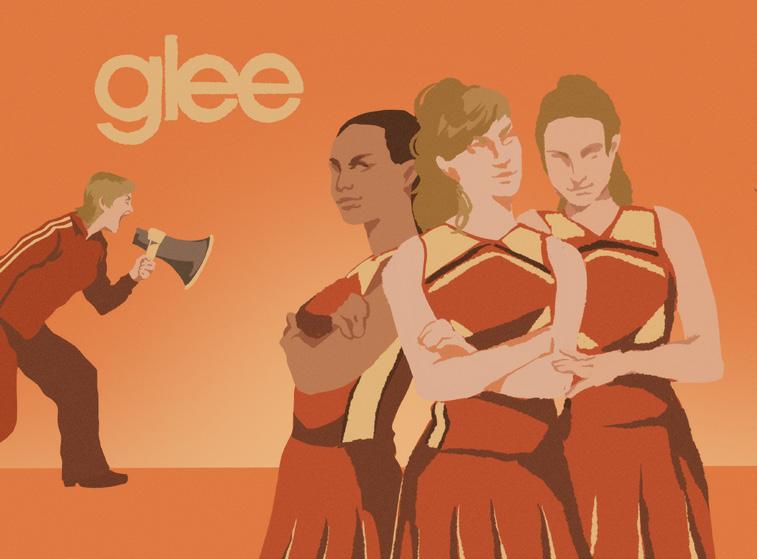
With that being said, Glee is a product of its time — the messy era of 2009 to 2015 in which social progressivism was undoubtedly on the rise but the terminology to most appropriately articulate this movement was not. This clash between sentiment and language is frequently reflected in Glee’s handling of various characters, particularly characters of color. In the years
following its conclusion, the series and its creator, Ryan Murphy, have come under a fair amount of criticism for the treatment of and lack of development for characters of color.
“We’re still having issues with trans kids in schools regarding treatments and bathroom conflicts, which Glee had a whole episode about,” Freshman Tommy DaSilva (they/them) said. “You can acknowledge that we’ve come far in some respects, but you also need to acknowledge that we’re still talking about these very same issues.”
Even with the supposed limits placed on this show by its heavy-handed approach to discussing various social issues, Glee has nevertheless remained culturally relevant well over half a decade after the series finale aired back in March of 2015 — Glee is simultaneously both of its time, yet also timeless.
“Glee was saying something,” Osborne said. “And even if we don’t completely agree with how they said it, we can appreciate that it was still saying something.”
And that’s what you missed on Glee.
REWIND:
NOISE 66 JERK 53-66




This issue of Jerk makes me want a hot dog real bad. jerkmagazine.net @jerkmagazine

 With love, Zoe Glasser (she/her/hers)
With love, Zoe Glasser (she/her/hers)









































































 Words by Lily Brooks Graphic by Lang Delapa
Words by Lily Brooks Graphic by Lang Delapa









 Jerk deconstructs tweed-filled aesthetics.
Jerk deconstructs tweed-filled aesthetics.




 Words by Margo Moran | Photo provided
Words by Margo Moran | Photo provided




